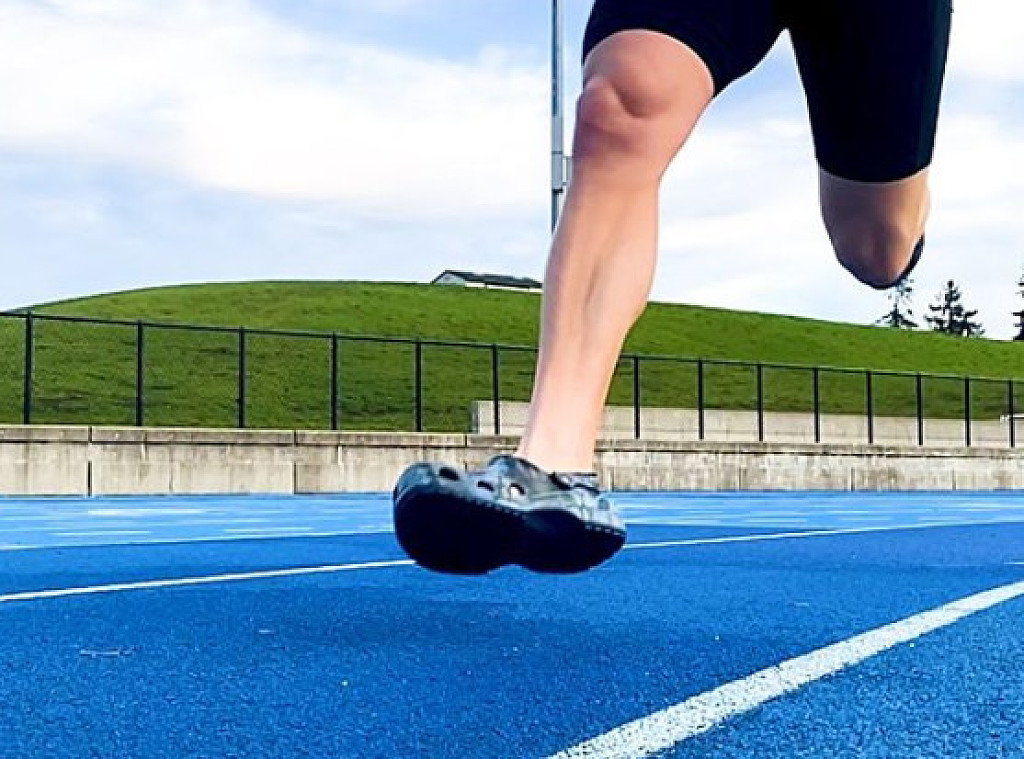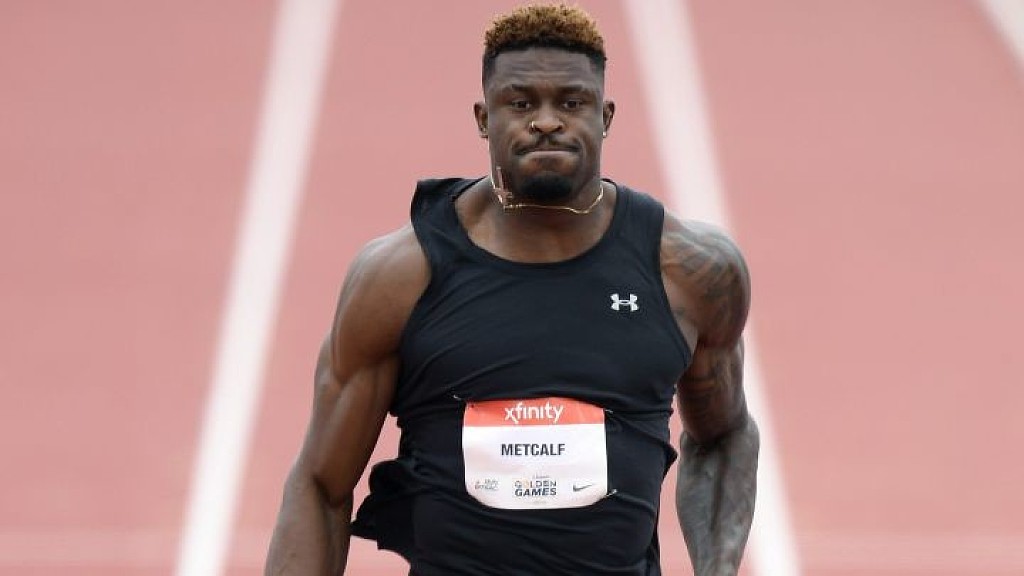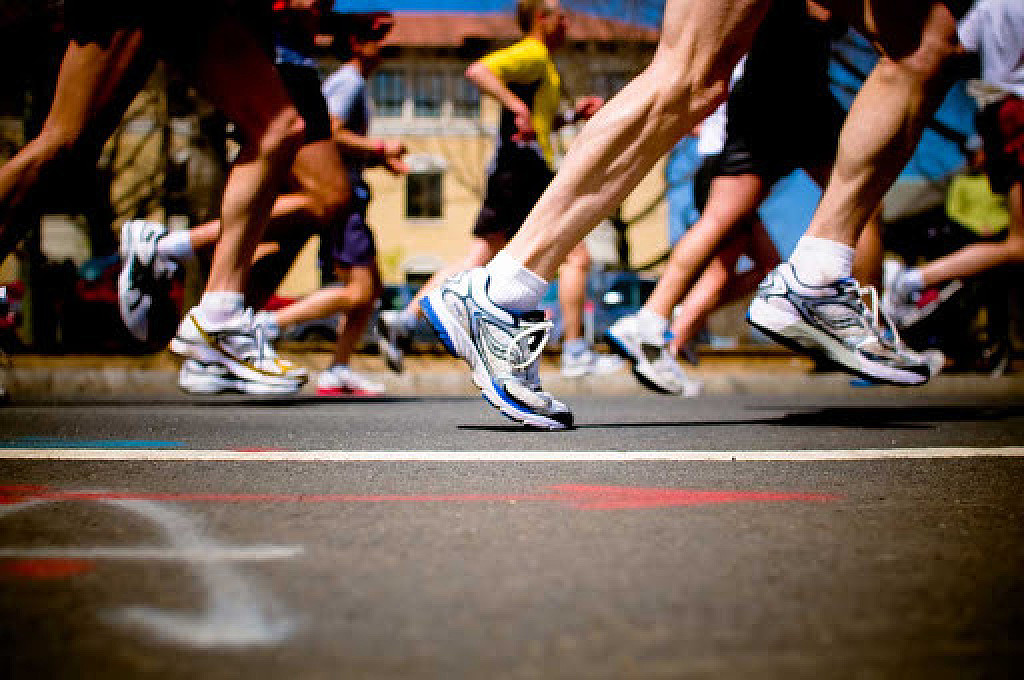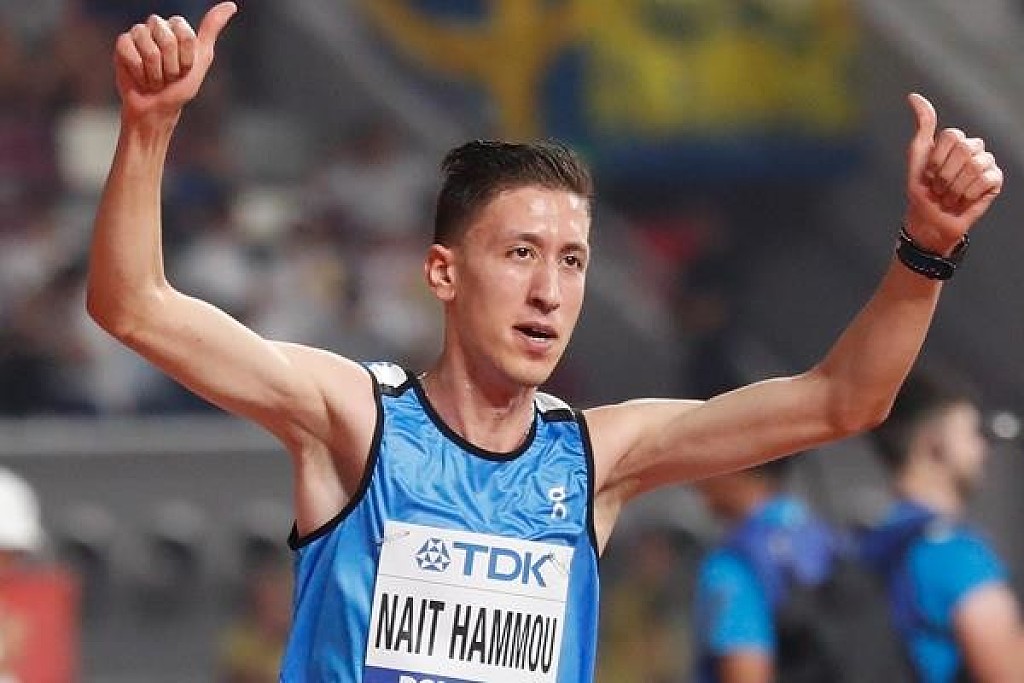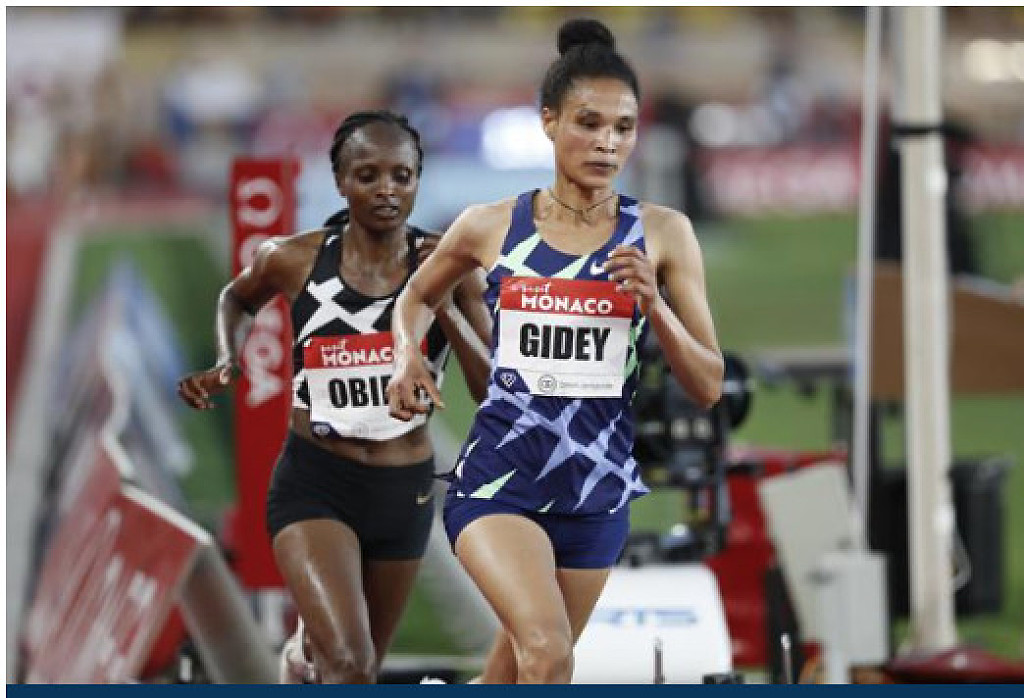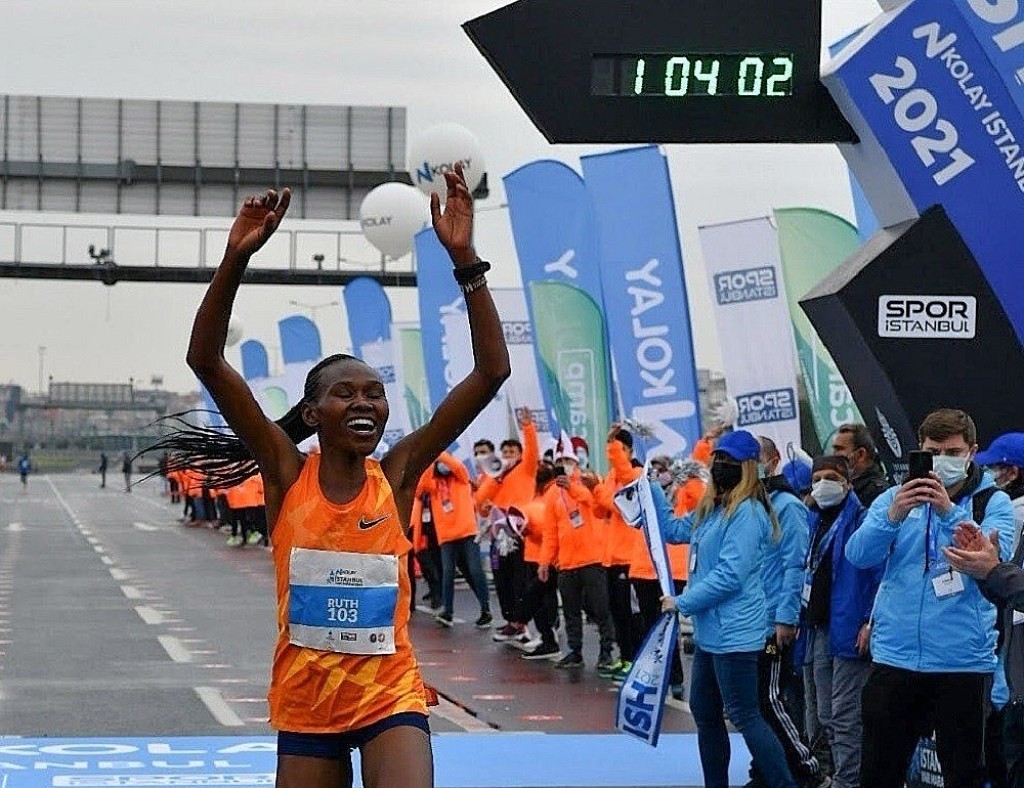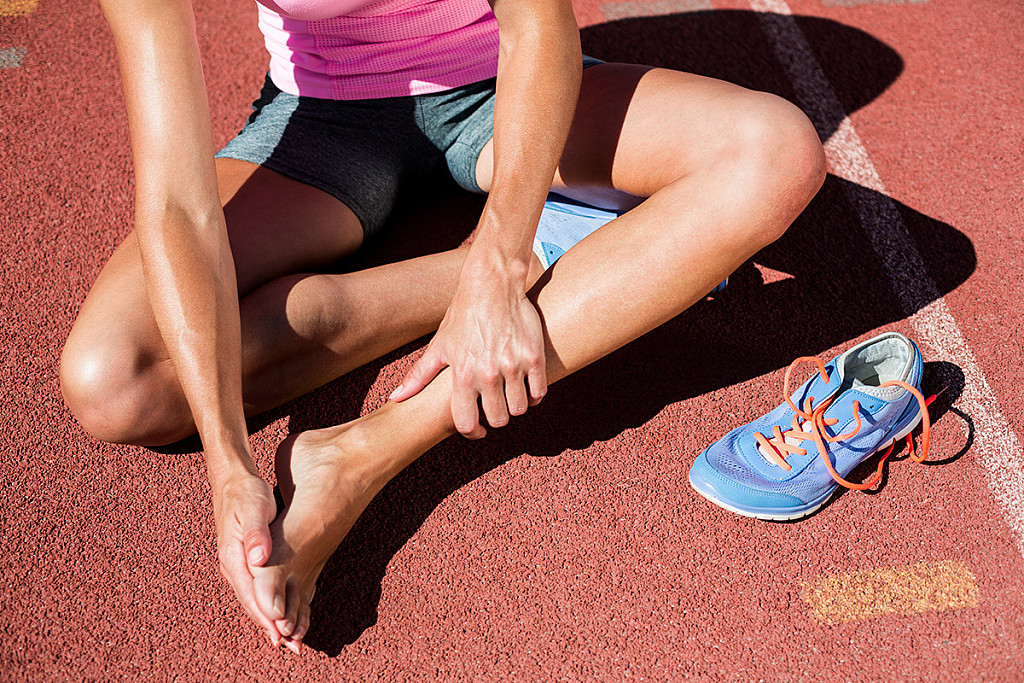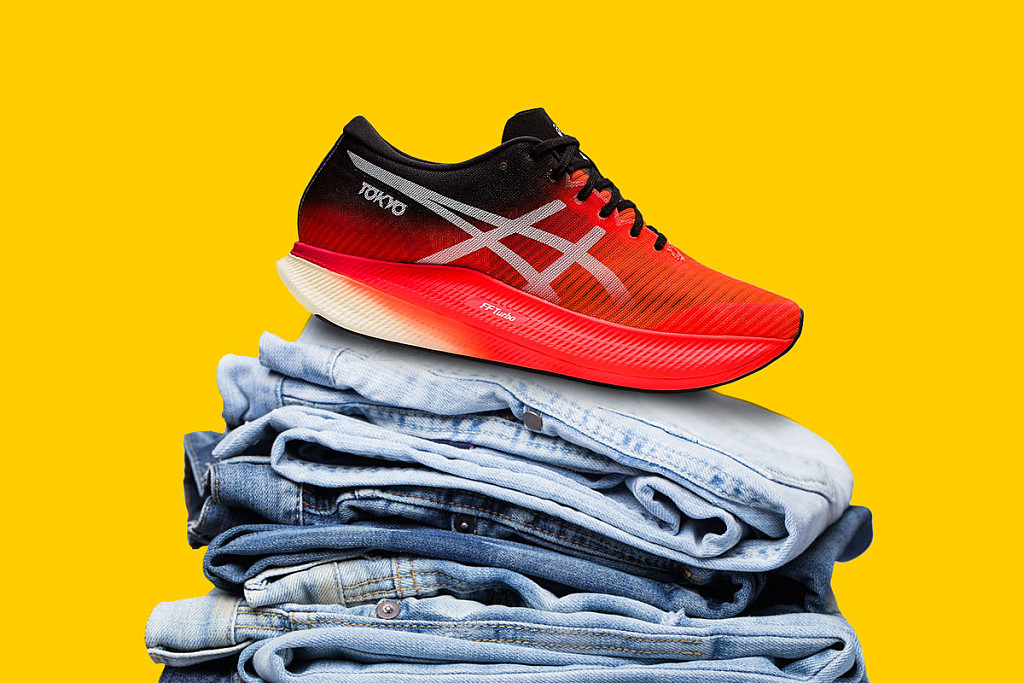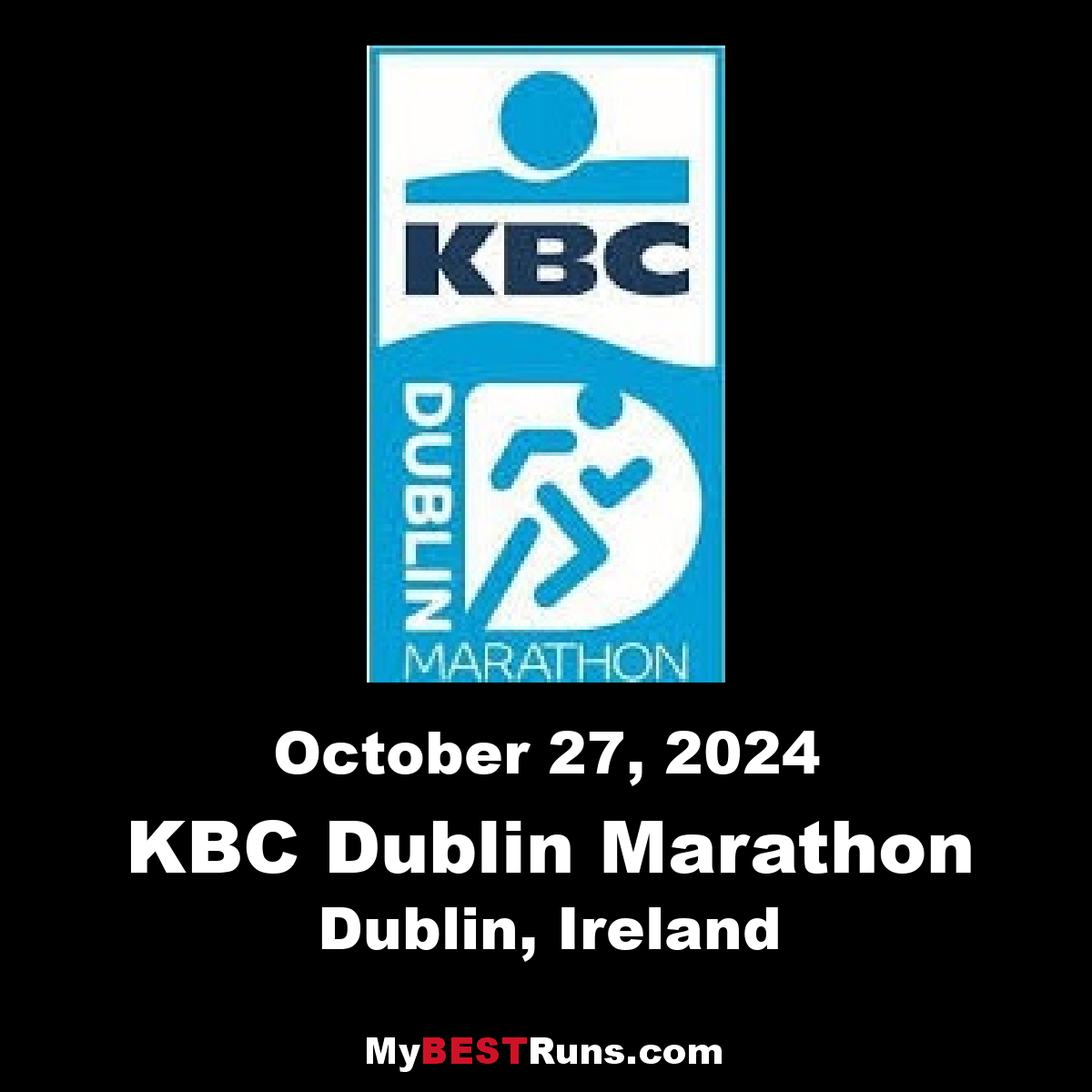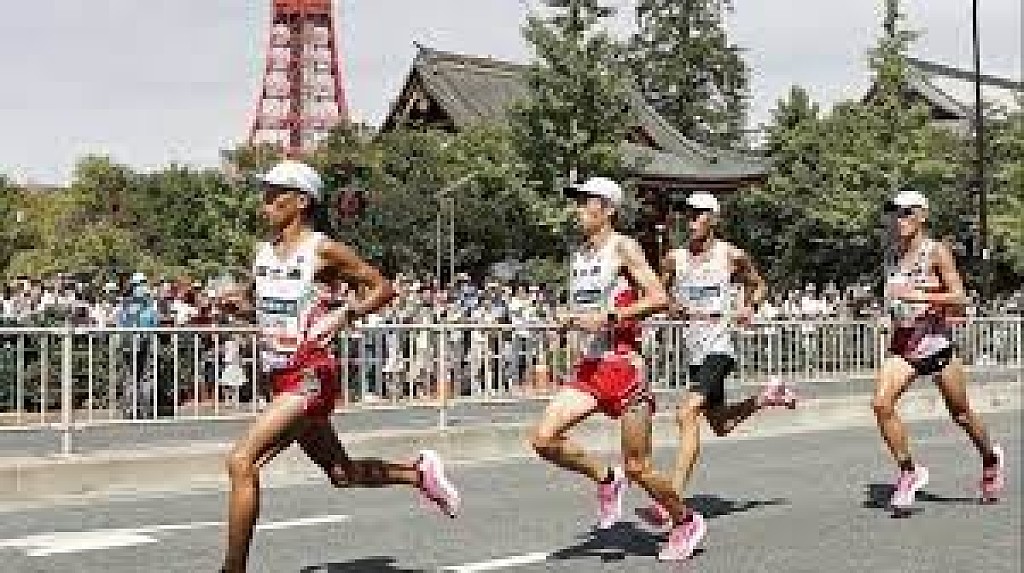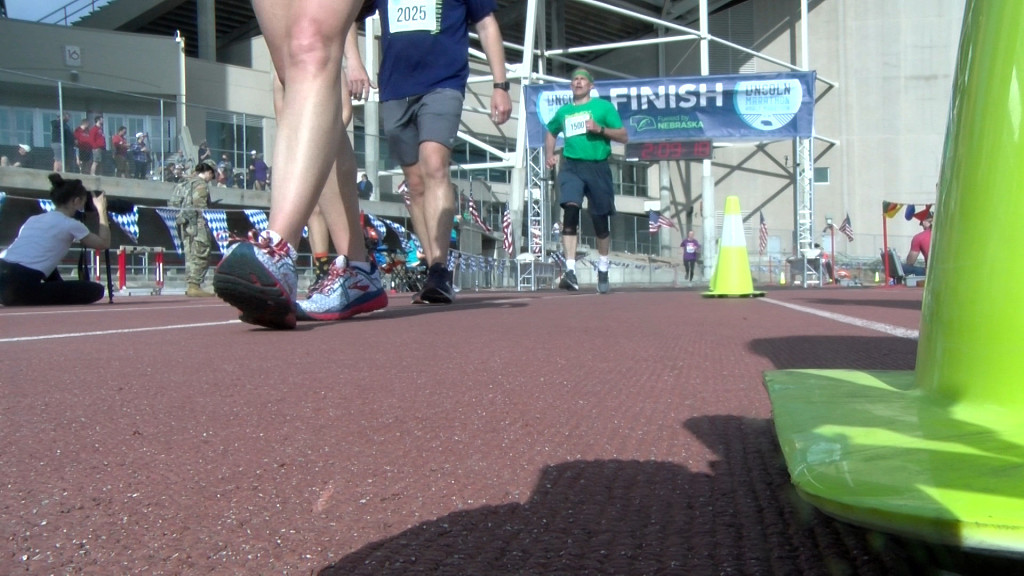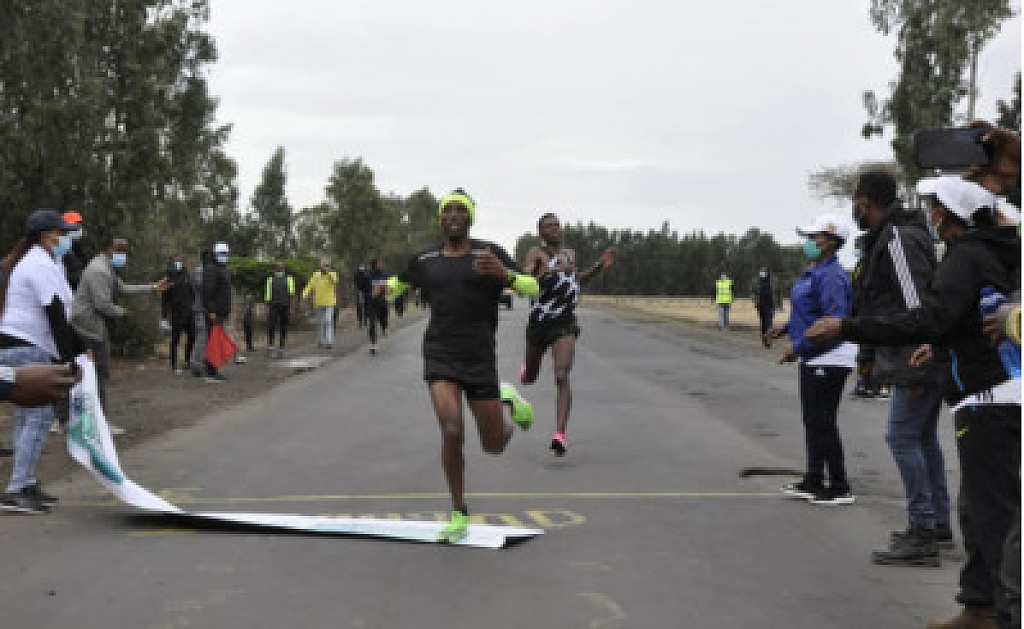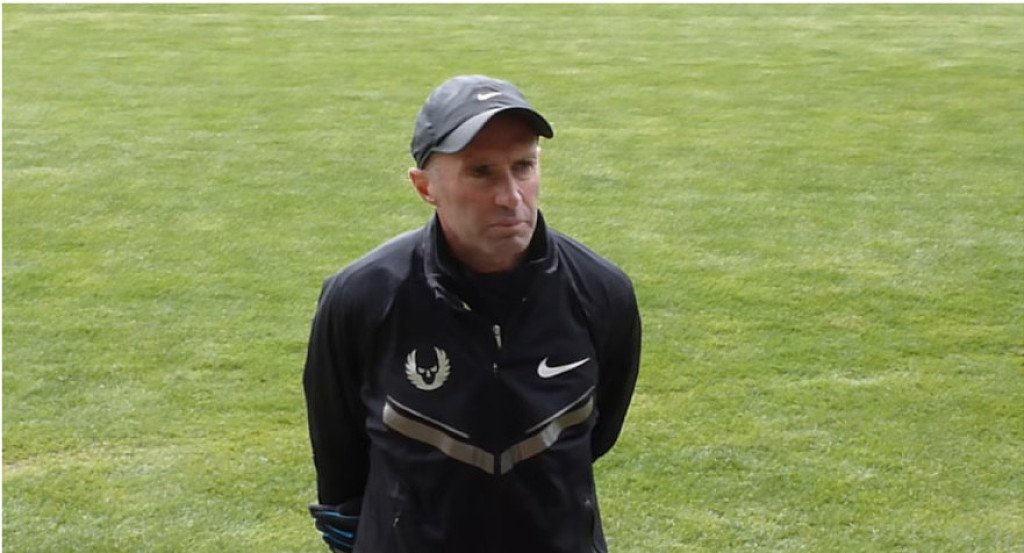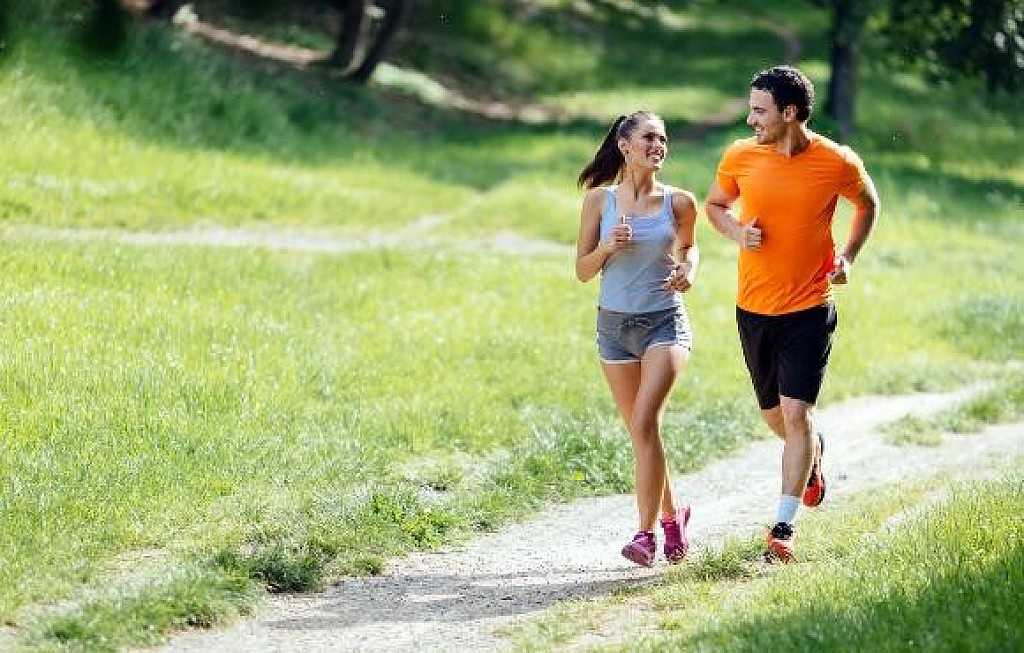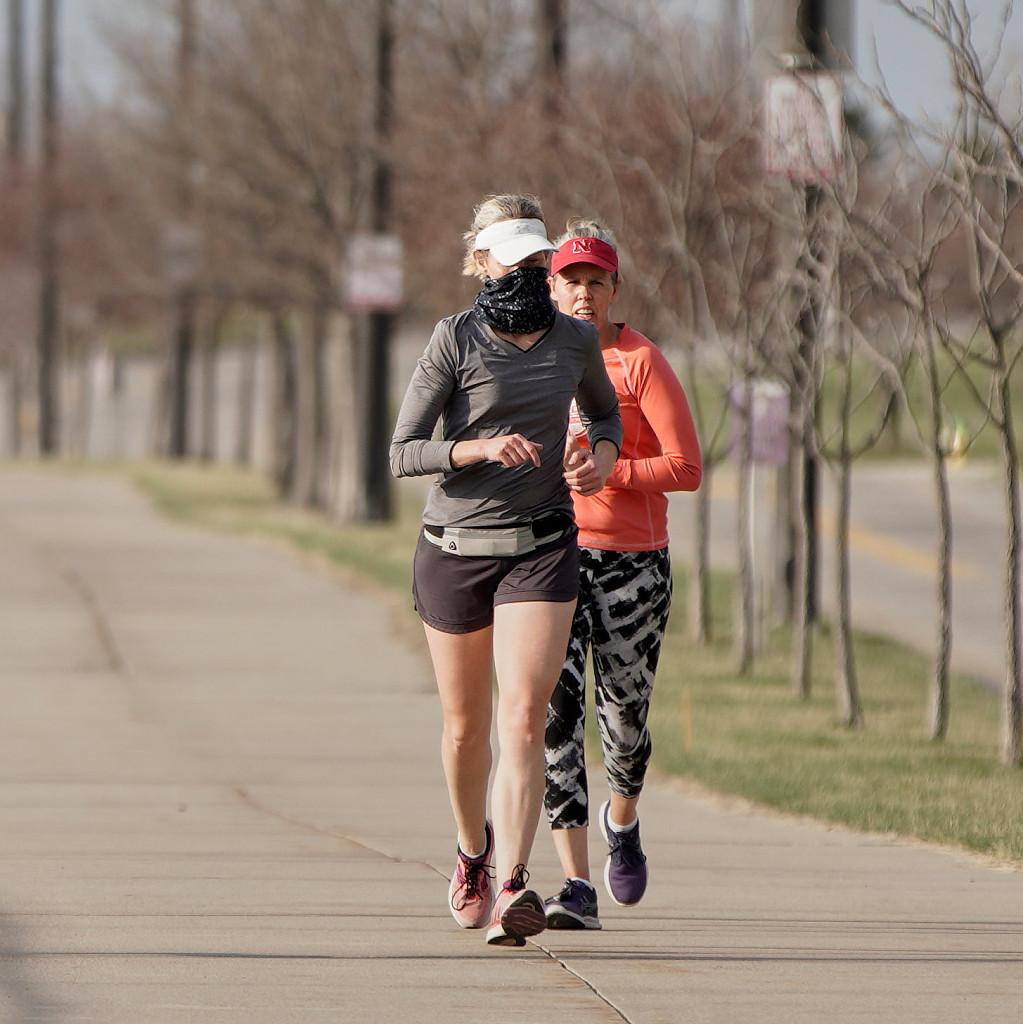Running News Daily
Running News Daily is edited by Bob Anderson in Mountain View, California USA and team in Thika Kenya, La Piedad Mexico, Bend Oregon, Chandler Arizona and Monforte da Beira Portugal. Send your news items to bob@mybestruns.com Advertising opportunities available. Over one million readers and growing. Train the Kenyan Way at KATA Running Retreat Kenya. (Kenyan Athletics Training Academy) in Thika Kenya. Opening in june 2024 KATA Running retreat Portugal. Learn more about Bob Anderson, MBR publisher and KATA director/owner, take a look at A Long Run the movie covering Bob's 50 race challenge.
Index to Daily Posts · Sign Up For Updates · Run The World Feed
Who needs super spikes when Crocs are available?, Runner wears Crocs in 5,000m race, flies to 14:47 finish
A runner named Benjamin Pachev raced a 5,000m in Portland on Saturday, running to a quick 14:47.62 finish. His time was good enough for 12th place, and although he didn’t win the race, he attracted a lot of attention during and after his run, which he completed in a pair of Crocs.
That’s right, while his competitors were lacing up their spikes, Pachev tossed on his foam clogs, and he ended up beating about half of the field.

This is not the first time that Pachev has raced in Crocs. In 2017, he took his unique shoes to the Mini-Marathon in Indianapolis, where he raced a half-marathon with his father, Sasha. The younger Pachev ran to a mind-boggling time of 1:11:53, finishing in 16th place. His father, also wearing Crocs, crossed the line just a few minutes later, posting a time of 1:17:26 and finishing 44th out of more than 20,000 runners.
Pachev’s sister, Jennifer, ran the 5K at the event, and like her father and brother, she wore Crocs, the family’s apparent preferred choice of footwear. She finished in ninth overall and crossed the line as the second female runner, posting a time of 19:56.
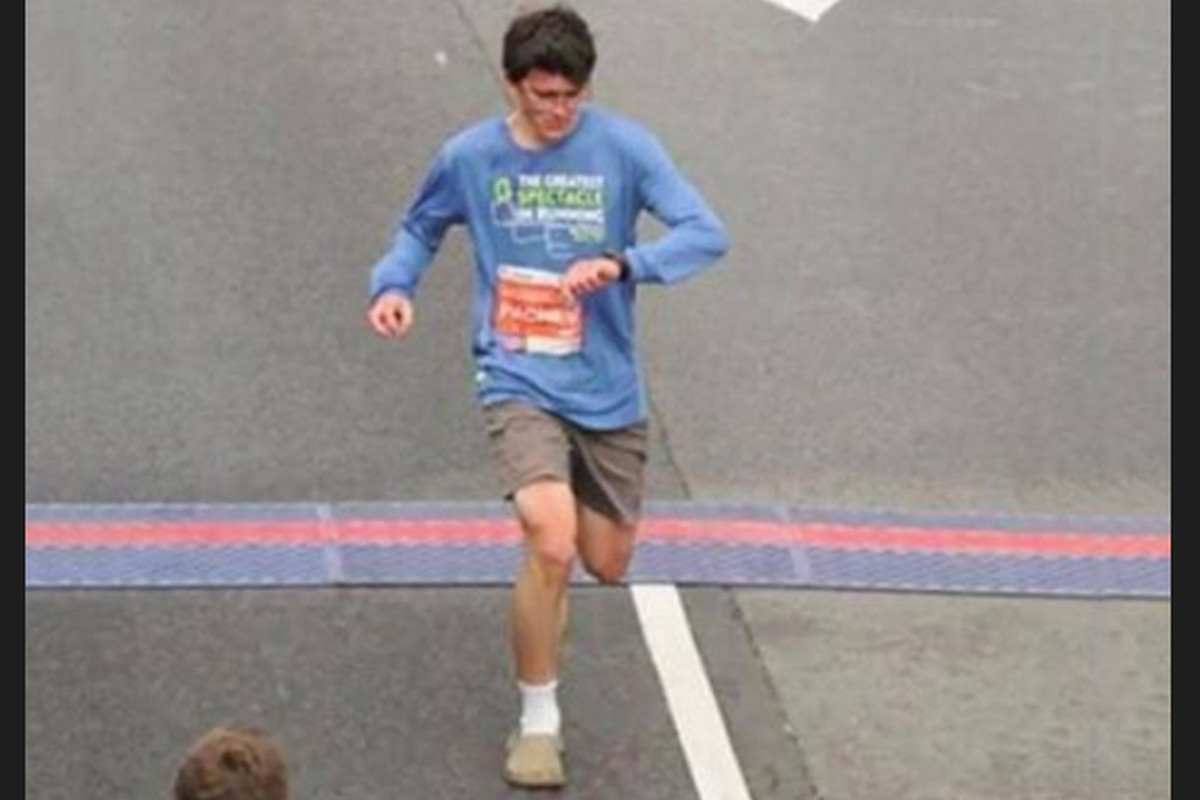
On Saturday, Pachev recreated that Crocs magic, blazing to a sub-15-minute finish in Portland. His final time works out to 2:57 per kilometre, which is a pace most people would struggle to hit even if they were decked out in the fastest spikes on the market.
It’s clear that these shoes work for Pachev, but the question still remains: why Crocs? According to an article from the Indy Star that was published after the Pachevs’ runs at the Mini-Marathon, Sasha made the change from normal running shoes to Crocs after he saw his kids run in them.
“I was trying to figure out if there was a better way to run than in regular running shoes,” Sasha said. “I was experimenting with different things.” When his kids insisted on running in Crocs one day, he noticed that their form was better than it was in other shoes, so he tried them out for himself.
“I really liked the feeling, and I’ve run in them ever since,” he said. “They’re really not that much different, speed-wise, from racing flats.” Sasha’s kids followed his lead, and the shoes are now the go-to footwear for the family. The Pachevs certainly look peculiar walking up to the start line at races in their Crocs, but they have proven that these shoes work well for them, so it’s likely that the running world will hear more stories from the speedy Crocs-supporting family in the future.
(05/11/2021) ⚡AMPby Ben Snider-McGrath
DK Metcalf Runs 10.37 for 100 Meters at 2021 USATF Golden Games
In his first track and field competition since high school, Seattle Seahawks wide receiver DK Metcalf ran a credible 10.37 but finished last in the second heat of the men’s 100 meters at the 2021 USATF Golden Games at Mt. SAC on Sunday, failing to advance to the final later this afternoon.
To qualify for the nine-person final, Metcalf would have had to have finished in the top three of his heat or earned one of the three time qualifiers; his time of 10.37 was .16 short of the final time qualifier, Bryce Robinson, who ran 10.21. The fastest qualifying time belonged to Isiah Young, who ran 10.09 to win heat one.

“Just happy to be here, excited to have the opportunity,” Metcalf said on the USATF.TV broadcast after the race. “I just thank God for the opportunity to just come out here and run against world-class athletes like this…These are world-class athletes, they do this for a living and it’s very different from football speed, from what I just realized.”
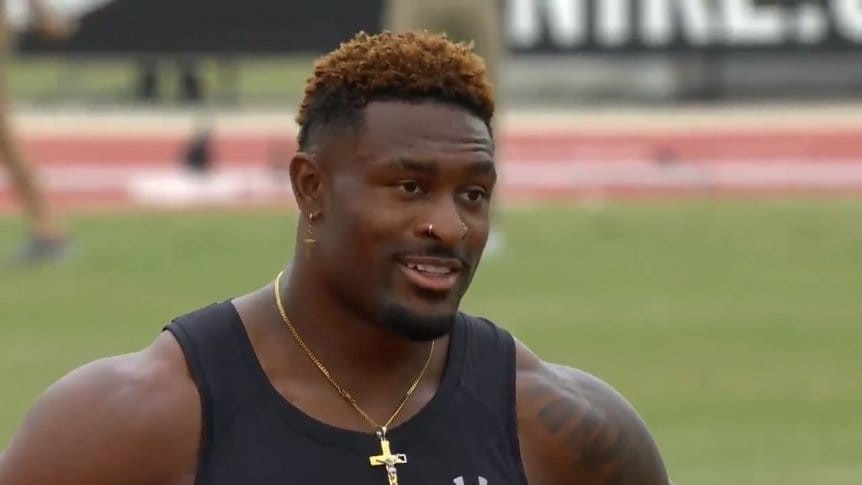
Metcalf, who did not run track in college at Ole Miss, came well shy of the automatic qualifying standard for the US Olympic Trials (10.05), which will be contested June 18-27 in Eugene, Ore. USATF will take a total of 32 athletes in the 100 meters, filling the field with the fastest qualifiers outside of those with the automatic standard. To earn one of those spots will likely take a time under 10.20 seconds, which means Metcalf will have to race again if he wants to qualify for the Trials.
That doesn’t appear likely though. When NBC’s Lewis Johnson asked Metcalf if he would continue racing, Metcalf said he had to go to the Seahawks’ mandatory minicamp, which is set for June 15-17.
(05/10/2021) ⚡AMPby LetsRun
Meet the Thick Boys Running Club—These Runners Have Lost a Combined 350 Pounds and Counting
Four football coaches in North Carolina started running together last summer, and they have inspired people all over the state.
A group of four Lake Norman High School football coaches in Mooresville, North Carolina, have collectively lost over 350 pounds through running since July 2020.

And together, they call themselves the Thick Boys Running Club.
The four coaches are all former college football players who struggled with weight after their playing days were over; they said they had wanted to lose weight for years. When the pandemic hit and their coaching and teaching went virtual, they found themselves with some extra time.
→ Want to read about more inspirational running stories? Join us at Runner’s World+ ✨
Jay Keener, 40, the school’s athletic director and football coach, was the first to make a move.
“I always justified my weight [thinking that] 300 pounds isn’t bad, and then 310. And then, I was afraid to weigh myself,” Keener told Runner’s World. “When I saw 345, I realized it’s not going to get an easier to get the weight off later, so I better do something.”
Keener started on the track by running to the straights and walking the curves. A week later, he recruited offensive coordinator Sean Fitzgerald—who weighed 284 pounds, his highest ever—to join him.

By early August, head coach Jonathon Oliphant (278 pounds) and defensive coordinator David Johnson (365 pounds) joined Keener and Fitzgerald in running daily laps around the track. As the four runners progressed, they started doing stadium stairs, and ran 5Ks and 10Ks. Rarely did any of them run without a partner.
“There’s literally 300 feet between the school and the field house, and I would be out of breath,” Johnson told Runner’s World. “That’s how out of shape I was. Being 365 pounds was tough for me. Having these guys helping and encouraging me, it gave me the direction I needed, and it helped having that support system over the past eight months.”
The four coaches wrote their weights on a whiteboard in the field house by the stadium, and they weighed in every Friday starting on August 24. Instead of competing against one another to see who could individually lose the most weight, they decided to work together and collectively reach milestones. They celebrated every time they hit a combined 50 pounds lost.
“Myself and coach Oliphant had been involved in weight-loss competitions before against people, and we wanted to do something different,” Fitzgerald told Runner’s World. “Everyone wanted to pull their own weight. It was much more fun and we never had to go at it alone.”
The first to hit the century mark was Johnson, who has lost nearly 120 pounds. Chasing him for second place is Keener who has lost over 80 pounds to get below 200 followed by Oliphant who has lost just under 80 pounds, and Fitzgerald who has lost over 70 pounds.

With kids back to the classroom and at practice, the coaches are doing more runs before and after school. And all four have noticed some stares this spring.
“It’s definitely a combo of the weight loss and wearing a mask, but it’s been difficult for people to make me out. They wonder who the new teacher is,” Johnson told Runner’s World. “People keep coming up and saying how proud they are of us and are inspired. People are telling us that they saw me out there, and now they’re running and trying to lose weight. That’s the best part to me. It’s an influence you had that you didn’t know you had.”
Additionally, their athletes are taking particular notice.
“The kids have really gotten behind us with their comments and curiosity, asking how far we ran today and how much we lost that week,” Oliphant told Runner‘s World. “They get excited about it, which has helped us keep going. It’s a lifestyle we’re proud to share with them and one we hope they take with them in their lives.”
The four runners said they have received letters of support from people in the community, and notes from coaches around the state. And their families have been supportive, and appreciated the healthier lifestyle at home, especially the recipes shared between the runners.
“My mom came and ate lunch with us a while back and she made the comment that we sounded like a bunch of housewives sharing recipes,” Fitzgerald said.
The Thick Boys Running Club plans to grow their group in the future. They hosted the inaugural Thick Boys Running Club 5K in September and pulled in more than $2,400 for local charities. They hope to host another run in 2021.
“I’ve dealt with weight issues my whole life,” Oliphant said. “Now, I got a handwritten letter from a guy from a couple counties north saying how we motivate him, and he’s 40-something years old. I relate to that and it’s been so positive to see others inspired by seeing stories like their own so they know it can be done. Being able to be that positive for someone, it’s a blessing.”
(05/10/2021) ⚡AMPby Runner's World
Check out these tips for running your first marathon
Preparing to run your debut marathon can be a scary thing. There are so many unknowns, and even though you’ve put in the work, the build to race day can be incredibly stressful. The best thing you can do to calm your nerves ahead of your marathon (or really any race that’s new to you) is to plan for every part of your run. From your clothes to your nutrition plan and more, you need to be ready for everything on the big day. And while planning ahead doesn’t mean your race will be free of hiccups, the in-depth preparation will at least help you relax a bit before the run, as you’ll know you’re as ready as you can be for the event. Here are a few tips to consider before your next race.
Write a checklist
Speaking of being prepared for race day, it’s a good idea to write a list of everything you’ll need for your run. The morning of the run, go through the list before you leave your house and make sure you have every item packed and ready to go. This will save you from the hassle of mentally checking things off and worrying that you might be missing something, plus it’ll help you avoid actually forgetting anything, which is a running nightmare that no one wants to experience in real life.

Find chafe-proof clothes
In training runs, be sure to test every item of clothing you plan to wear during the race. It doesn’t matter how comfortable something feels when you try it on, because it’s a completely different story when you’re wearing it for 42.2K of running. Test your shorts, your shoes, your shirts and even your socks. Otherwise, you might get an unpleasant mid-run surprise when you start to chafe or blister.
If you’re doing a virtual race, plan your route beforehand. If you don’t, you’ll find yourself constantly checking your watch to see how much farther you have to go. Planning the route before you start will give you the luxury of running freely and knowing exactly where you are and how many kilometres are left until the finish line.

Have a nutrition plan
Like the clothing tip, don’t try any new food on race day. Your breakfast, pre-race snack and whatever you eat during your run should all be tested in training. Ignoring a nutrition plan could lead to you taking unscheduled bathroom breaks, or it could result in you bonking. Either way, you’ll probably fall short of whatever time you hoped to run.
Get the right shoes
If you’re a regular runner, you should already have proper running shoes, but it’s especially important for long races like the marathon. You’re going to spend hours on the course, which means thousands of steps on hard pavement. If you don’t have the right shoes, you could pay for it, both during the race and in the days or weeks after you cross the finish.
Accept the pain
Don’t go into the race thinking you won’t hit a wall. You’re going to hit one. Everyone does at some point, and if you convince yourself that you’re special, then you’re only setting yourself up for failure, because when you do hit the wall, you’ll be surprised. Accepting the inevitable pain you’ll experience before going into the race will help you deal with it when the time comes, which will play a huge role in you getting over that wall and carrying on toward the finish.
(05/10/2021) ⚡AMPby Ben Snider-McGrath
Eliud Kipchoge and Sara Hall, among runners chosen for Sports Illustrated’s Fittest 50 honors
Sports Illustrated has released its Fittest 50 list, and as usual, multiple runners were included. The Fittest 50 is SI‘s attempt to list the fittest men and women in the world, looking at athletes from any and all sports. This year, nine runners were selected, with six of the 25 women and three of the 25 men coming from the track, trails or road. Here’s a breakdown of where each individual placed and why the SI panel (which included Dr. Michael Joyner of the Mayo Clinic) chose them.
Running was the sport with the most women included in the top 25, and the six athletes chosen was double the three chosen from MMA, which was the sport with the next-most number of selections. American marathoner Sara Hall is #24, and with her performances in the past year, it comes as no surprise to see her on this list. The SI team notes how Hall overcame the disappointment of missing out on the Tokyo Olympics and ended up running two huge marathon PBs, first at the London Marathon (where she finished in second in 2:22:01) and then with her win at The Marathon Project, where her 2:20:32 finish was the second-fastest marathon in U.S. history.

Up next is Dalilah Muhammad at #16. SI refers to Muhammad as the “queen of the 400-meter hurdles,” a title she has owned since her gold medal in the event at the 2016 Olympics. Since then, she has broken the world record on multiple occasions (her current record stands at 52.16 seconds, a time that won her the gold medal at the 2019 world championships), and she is now a heavy favorite to win gold in Tokyo this summer.
American ultrarunner Courtney Dauwalter comes in at #14, and her remarkable result from Big’s Backyard Ultra in 2020 is listed as a big reason for that. Dauwalter won the American title at the event, running 455K. Just ahead of Dauwalter at #13 is American track and field star Tianna Bartoletta. Bartoletta is truly a track and field standout, as she has won Olympic and world medals in both sprints and jumps. In London in 2012, she won Olympic gold as part of the U.S. women’s 4 x 100m relay team. She and the squad defended that title in Rio four years later, and she added an individual gold medal in the long jump.

Emma Coburn is #10 on the list, coming in ahead of tennis star Serena Williams.
Unlike on the women’s list, running didn’t win for the most men selected in the top 25 (American football had four athletes and basketball had three), but three athletes still made the elite list. American ultrarunning sensation Jim Walmsley was included at #24, and he is extremely deserving of this honor. Firstly, as noted in the SI piece, he competed at the U.S. Olympic Marathon Trials in 2020, going out of his comfort zone and running 42.2K instead of his preferred ultra distances of 100K or 100 miles. He finished in 2:15:05, earning him 22nd place in his debut marathon. He then kicked off 2021 with an amazing 100K run in Arizona, where he finished in 6:09:26, breaking the American record and finishing just 12 seconds off the world best.
Next up is Eliud Kipchoge at #20. While Kipchoge had the worst marathon of his career at the London Marathon in October 2020, there’s no denying that he’s still one of the best road runners in the world. He’s the world record holder in the marathon and he is the only human to run under two hours in the event, making him a favorite to win gold in Tokyo this summer.
Finally, breaking into the top 10 is Noah Lyles at #9. Lyles is the reigning 200m world champion, and he owns a PB of 19.50 in the event. He’s a heavy favourite to take gold in Tokyo, and he might even compete in the 100m. Add all this together and he’s a clear choice for SI‘s Fittest 50 list.
(05/10/2021) ⚡AMPby Ben Snider-McGrath
Athlete refugees now eyeing Tokyo berths, after a year of pandemic setbacks and challenges
The postponed Tokyo 2020 Olympic Games looked one step closer to reality in recent days with the staging of the athletics test events, the half marathon in Sapporo on Wednesday (5) and the Ready Steady Tokyo Athletics Meeting at the Olympic Stadium on Sunday (9). Athletes from around the world were tuning in to catch a glimpse of the courses, the facilities and the track they're hoping to compete on when the Games kick off in July, including two clusters of the Athlete Refugee Team from their bases in Tel Aviv and Ngong, Kenya.
One of them was Tachlowini Gabriyesos, a distance runner who trains with the Alley Runners club in Tel Aviv who achieved a major milestone at the Hahula Galilee Marathon on 14 March. Contesting the distance for just the second time, the 23-year-old Eritrean native clocked 2:10:55 to become the first refugee athlete to better an Olympic qualifying standard for the Tokyo Olympic Games.
"This (past) year was different because of the pandemic, but most of my training was as planned," said Gabriyesos, who has steadily moved up in distance over the past two seasons. He competed in the 5000m for the Athlete Refugee Team at the 2019 World Championships in Doha but in 2020 found a better fit with longer distances.

He was slated to compete at the World Athletics Half Marathon Championships in Gdynia, Poland, last October, but was unable to obtain a visa. So instead, two months later he improved his half marathon lifetime best to 1:02:21 in the prelude to his marathon breakthrough.
"I think I'm in better shape than I was last year, but physically and mentally it was hard to train with the pandemic restrictions."

Focusing on Tokyo has helped.
"The Olympics is my dream as a professional athlete and it would be a great honour to be part of the Refugee Olympic Team," he said. "I want to show others that everything is possible and they shouldn't give up."
Lokoro targeting second Olympic appearance
The International Olympic Committee will announce the composition of its second Refugee Olympic Team (this year competing as EOR, its French acronym) in early June. While the selection process is complex, quality of performance will play a key role. Paulo Amotun Lokoro, a refugee from South Sudan and a member of the inaugural team in Rio, is hoping to make the cut again.
But unlike Gabriyesos, who has largely managed to navigate the pandemic restrictions over the past year, Lokoro, who is based at the Tegla Loroupe Peace Foundation training camp in Ngong, wasn't as fortunate. The camp was forced to close during the first lockdown in Kenya in April of last year, forcing Lokoro to return to the Kakuma Refugee Camp where, training-wise, he found himself alone. He returned to Ngong in December and resumed training only to be forced into another lockdown situation in the beginning of March.
"It has been frustrating, we haven't had enough time to train," Lokoro said. "And during this lockdown the government has discouraged us from training in public and as a team, so we were training individually."
Lokoro finished 11th in his 1500m heat in Rio, clocking 4:03.96. He's improved steadily since, currently boasting a 3:44.10 lifetime best set in 2019. He also competed in Doha, but, suffering with a hamstring injury, didn't advance from the heats.
"In 2019 I was well prepared," he said. "My shape is different now, but we still hope to catch up before Tokyo."
World Athletics provides ongoing support
Since the IOC put the refugee athletes on the international stage in Rio five years ago, World Athletics has entered an Athlete Refugee Team (ART) in almost every major championship: the 2017 and 2019 World Athletics Championships, the 2018 World Cross Country Championships, the 2017 and 2019 World Athletics Relays and the 2020 World Athletics Half Marathon Championships. The African and European area federations have opened entry to refugee athletes based on their continents. Those competitive opportunities, coupled with generous scholarships from the IOC and ongoing training and logistical support from World Athletics, has made a difference.
Otmane Nait Hammou, a refugee from Morocco who is based in Sweden, made his Athlete Refugee Team debut at the 2018 World Cross Country Championships, competed in the steeplechase in Doha and more recently at the World Half Marathon Championships in Gdynia where he finished 67th, clocking 1:03:28 in his competitive debut over the distance and beating some of the world’s finest half-marathoners in the process. He's hoping for a spot on the steeplechase start line in Tokyo.
"World Athletics' support to compete at three World Championships did play a big role to keep me feeling hungry and motivated," he said. "With the solidarity support from the International Olympic Committee and my sponsors ON Running and Maurten and my French club ES Sartrouville, it has really made a difference.
"Honestly, it was really hard to keep motivated without having short term goals (during the pandemic), but you can't give up when it comes to the Olympic Games."
"We have been facing a lot of challenges, but at least we have been able to train individually," said Rose Nathike Lokonyen, a refugee from South Sudan who was the team's flag-bearer in Rio.
Before the pandemic hit, 5000m hopeful Ukuk Utho'o Bul said: "We were all training well, it was an Olympic year and we were preparing well. But when the pandemic came the camp closed so we all had to go back to where we came from. When we are training as a team there is a motivation. You always move forward, you motivate yourself. Then I was in a different place. I was alone and training alone. But we are trying our best."
In Lisbon, Dorian Keletela, a refugee from Congo, is aiming to be the first sprinter selected for the Refugee Olympic Team. Keletela, who competed in the 60m at the European Indoor Championships in March, has a 10.46 career best from 2020. He's hoping to compete at the European U23 Championships later this summer as well.
(05/10/2021) ⚡AMPby World Athletics
Tokyo 2020 Olympic Games
Fifty-six years after having organized the Olympic Games, the Japanese capital will be hosting a Summer edition for the second time, originally scheduled from July 24 to August 9, 2020, the games were postponed due to coronavirus outbreak, the postponed Tokyo Olympics will be held from July 23 to August 8 in 2021, according to the International Olympic Committee decision. ...
more...Should You Ice Your Injury or use heat?
Few topics have gripped the therapy and performance world in the past few years more than icing. To be honest, I was one of those professionals and educators that was a proponent of icing injuries. As a college professor and a person who reads research and pounds the pulpit of evidence-based practice, I too was one of the millions of professionals who fell for the fallacy.
I remember explaining to athletes and individuals from the general population that ice slows inflammation and allows tissues not to become hypoxic (without oxygen). It makes sense that swelling in a muscle or joint should be removed and that ice should stop or slow swelling as it slows inflammation. However, there are a couple of glaring issues with that argument I ignored.
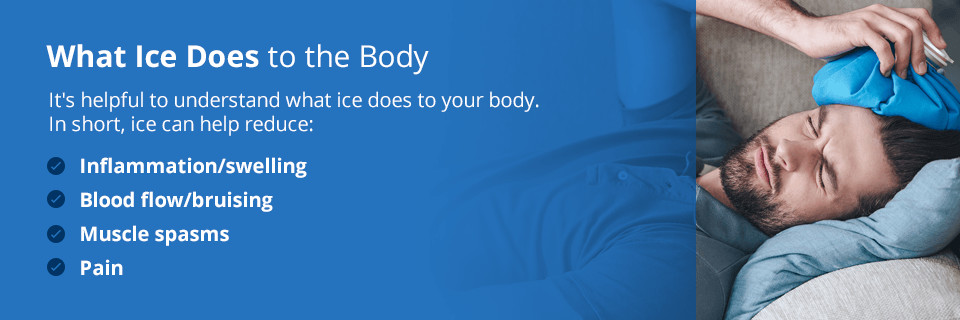
First, there is not consistent research on the effectiveness of icing injuries. A 2015 study found that men who regularly applied ice packs after weight training workouts developed less muscular strength, size and endurance than those who recovered without ice. Another review revealed that athletes who did ice baths after tough exercise regained muscular strength and power more slowly than their teammates who did no post-sweat chilling. And most recently, a new study in mice suggests icing muscles after strenuous exercise is not just ineffective, it could be counterproductive.
I think any doctor would have a hard time justifying the broad use of a drug with such inconsistent (you could even go as far as to say negative) findings, but ice seems to be the exception.
I don't think it is wise to swing to a completely anti-ice stance. I also do not advocate heating up a knee with a ACL tear. What I am saying is that icing is unsupported in most chronic injuries, rehab protocols and performance-related recovery. Let me try and convince you.
The Stages Of Healing
In the case of injury, whether a joint injury or muscle injury or muscle damage from general training, the body will go through three stages of healing. The first is inflammation. Often regarded as a negative consequence, inflammation is actually the trigger that removes damaged structure and starts to bring in the needed fuel and structures to rebuild. In order to move things in and out there must be fluid movement. Ice actually prevents movement and slows healing.
In the case of swelling, obviously fluid has increased in a joint or muscle. At that point, freezing or significantly cooling down the tissue is not going to speed the movement of fluid but in fact impair it. The best thing to do is to move the fluid. Moving the fluid could be done by actually moving, massage, a muscle stimulator or compression with movement. Ice will not move fluid.
In relation to ice baths and other forms of cryotherapy, ice will only again slow the process of healing. If you want to avoid the soreness that follows muscle damage 48 to 72 hours after a long run, the best thing would be go for a walk the next day. Move fluid, don't freeze it.
Icing Injuries And When To Do It
However, I did mention that I don't believe ice should be completely dismissed. Ice does a couple of things really well: it numbs or temporarily blocks pain, and it pulls heat out of the tissue. To the first point, in rehab situations the use of ice could be helpful. It can allow the joint to be moved easier in order to push fluid and establish range of motion.
To the second point, if a runner runs multiple times a day in the heat, an ice bath might be beneficial. While the adaptation process would be slowed, the athlete would not care about adaptation as much recovering for the following bout of exercise in the same day.
In the end, ice is a tool. Ice is not a blanket treatment, it has a specific time and place for its usage. If you need a quick turn around and just want to feel better, you could use ice or an ice bath. However, if you are actually trying to build and recover the muscle, provide movement to allow repair of tissues and leave the ice alone.
For chronic joint pain, compress and move the joint in order to heat it up or just heat it up directly. However, if a joint is producing chronic pain, fix the problem which is probably due to a mobility or stability or muscular strength issue. Even a degenerative joint can fall under one of those three areas (mobility, stability, strength).
For acute injuries, ice if needed for pain, but compress and elevate the joint and let the healing process run its course. Pain free movement can aid that recovery (assuming a consultation with a medical professional depending on the severity of the injury).
(05/10/2021) ⚡AMPby Trail Runner Magazine
COVID-19 restrictions for Tokyo Olympics shouldn't apply to female athletes' infants, toddlers
A few days shy of her first birthday, Alex Morgan’s daughter Charlie is already more well-traveled than most adults.
There were the two-plus months in England, when Morgan was playing for Tottenham. The week in the Netherlands, followed by a few days in France, for U.S. women’s matches. There’s likely to be another trip in June for pre-Olympic warm-up games.

“It’s important to allow mothers that option, to have their kids with them while they compete. I’ve been lucky to be able to do that with every single camp and matches with Charlie,” Morgan said last month. “It’s incredibly important to feel supported as a mom. I hope I continue to feel that way leading into the Olympics and in the Olympics.”
But COVID-19 restrictions for the Tokyo Games could force Morgan and a small number of other athletes who are mothers of small children to choose between their dreams of competing at the Olympics and their families.
At previous Olympics, children of competing athletes would come to the Games like any other family member. Visas, if necessary, would be arranged, and they would travel with their other parent, another family member or caregiver. The family would either stay together outside the Olympic village, or moms would arrange to see their children between training and competitions.
That won’t be possible this summer. Japan is desperately trying to keep the Olympics and Paralympics from turning into a superspreader event, and the International Olympic Committee and Tokyo organizers have already said foreign fans won’t be allowed at the Games.
Japan also currently bars entry to residents of 152 countries “unless special exceptional circumstances are found,” meaning someone from the United States – and pretty much every other country sending athletes to the Games – can’t simply get on a plane and go to Tokyo.
But if allowing female athletes to bring their infants and toddlers to the Tokyo Games doesn’t qualify as a “special exceptional circumstance,” I don’t know what would.
“I would be most sensitive to moms that are breast-feeding, new moms, moms with very small babies,” sprinter Allyson Felix, whose daughter Camryn turned 2 in November, said last month. “I know how crucial that is. I know for me, when I competed when Cammy was under a year old, you need to be near your child. That needs to be taken into consideration for those mothers.”
Tokyo organizers did not respond to questions about whether female athletes will be allowed to bring their young children. IOC spokesman Christian Klaue said women athletes who want to bring their children to Tokyo will be dealt with on a case-by-case basis, without pr
Of course it will be crushing for partners, parents and siblings to miss what is, for many athletes, a once-in-a-lifetime event, and if any family members are allowed, no doubt everyone will be clamoring to go. But prohibiting babies and toddlers from accompanying their mothers to the Games is not remotely the same, and the IOC and Tokyo organizers need to acknowledge that.
This isn’t a matter of, “Oh, I want to have a selfie with my baby at the finish line.” For female athletes with an infant or a toddler, not having them in Tokyo can have a direct impact on their child-rearing decisions.
And their children’s health.
Breastfeeding benefits a child’s physical and cognitive development, and the World Health Organization – which the IOC relies on for medical advice – recommends children be breastfed “up to 2 years and beyond.” Research also indicates that mothers who have been vaccinated are passing COVID antibodies to their babies through breast milk, but that immunity only lasts so long as the child is nursing.
It’s possible athletes who are nursing and want to continue to do so could pump at the Games. But depending on the age of the child, that could require several hours each day.
“I am still nursing Zoe and cannot imagine her not being with me,” marathoner Aliphine Tuliamuk, whose daughter was born in January, told USA TODAY Sports in a statement. “There are many more challenges than usual at this Olympic Games, but I do hope that the needs of mothers, families and children are given full consideration and support."
Everyone is sympathetic to the challenges of holding an Olympics during a pandemic, as well as the concerns of the Japanese people. But allowing women athletes to bring their infants and toddlers to Tokyo, along with a caregiver, would not add a significant number of people.
The United States typically has the largest team at the Olympics, 500-plus for a Summer Games, and this affects only a handful of its athletes. So at most we’re talking, what, a few dozen additional people?
It’s not a large number, but the impact is.
The IOC has made a big show in recent years of elevating women and promoting gender equity, and will proudly tout its statistics on female representation at the Games and in its leadership roles. In March, Tamayo Marukawa, Japan’s minister in charge of the Tokyo Games, said in a statement that the “active participation of women will lead to the creation of a prosperous, vibrant and sustainable society and the realization of a society in which everyone can live comfortably.”
By telling female athletes to leave their young children behind, however, the IOC and Tokyo organizers show how empty those words are. You cannot claim to value and respect women if you are not supporting and empowering them to make choices that are in the best interest of their families.
(05/09/2021) ⚡AMPby USA Today
New mom runs 15:45 5K, 4:42 mile just months after birth of first child
In October 2020, a woman named Makenna Myler ran a 5:25 mile while nine months pregnant. Just a couple of weeks later, she gave birth to a baby girl, and now, only six months after her daughter was born, Myler is back, not just racing, but winning. Her return to the track after her pregnancy came in mid-April, when she won a 5,000m in California in a huge personal best of 15:45.48, and she followed that up a week later with another win and a mile PB of 4:42.40.
Myler first blew up on Tik Tok, where her husband posted a video of her one-mile time trial at nine months pregnant. A 5:25 mile is a fast time for most people in general, but to run that quickly with a full-grown baby in your belly (Myler’s due date was just days after her time trial) is extraordinary. After a few months of recovery, she is back to incredible form, and she’s running faster than she ever has before.

Myler, who ran at BYU and now lives and trains in California, had pre-pregnancy PBs of 4:43.31 for the mile and 16:10.33 in the 5,000m. These are both great times, but she has bettered both since having her baby, Kenny Lou. Her 15:45.48 PB in the 5K is a whopping 25-second PB, and it gives her the 38th-fastest time at the distance among American women in 2021. (Only five Canadian women have run faster over 5,000m so far this year.) In the mile, Myler’s one-second PB gave her a top finish at a meet at her alma mater of BYU, and it is the sixth-best time run by an American woman so far this year.
Myler credits being a mom with her success, as she has learned some valuable lessons in the months since her daughter was born. “Having a baby less than six months ago has pushed me to ask for help so I can reach goals and show my little girl that I will never stop becoming, I will never stop trying in one way or another,” she wrote on Instagram. “I will keep surrounding myself with those greater than me and I will always come off better for it. I’m not the first and I won’t be the last mama to keep at it.”
(05/09/2021) ⚡AMPby Running Magazine
Two Treadmills Inside ... a Pub?! How This Runner Broke the 100-Mile Treadmill World Record
In his second 100-miler ever, he ran a 6:55/mile pace inside a local pub.
For the second weekend in a row, one of Zach Bitter’s 100-mile world records has fallen.

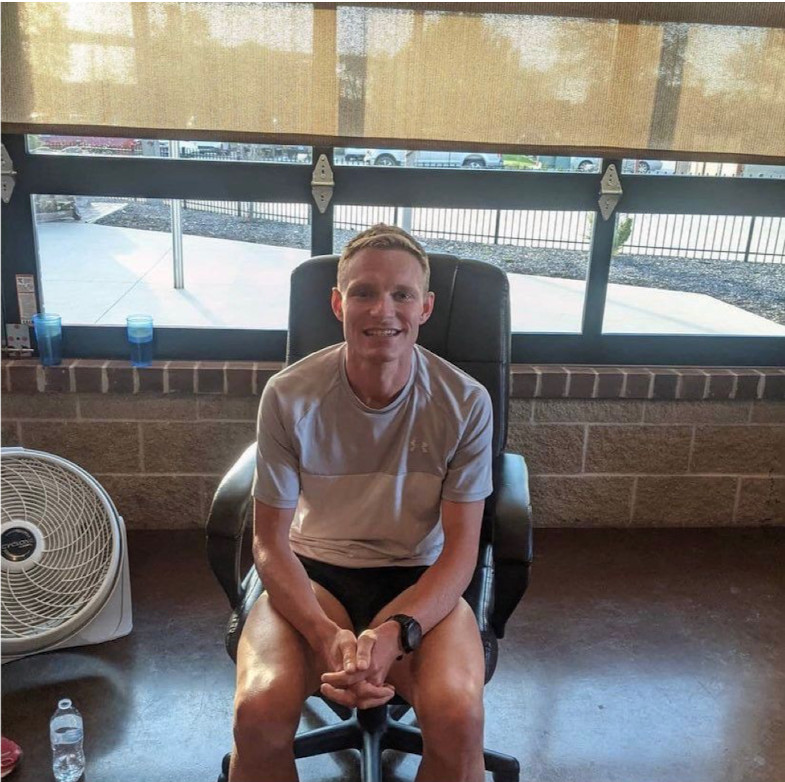
Taggart VanEtten, 25, of Morton, Illinois, smashed Bitter’s 100-mile treadmill world record with a time of 11:32:05. VanEtten’s average pace was 6:55 per mile, and he beat Bitter’s record by nearly 40 minutes.
That’s quite the accomplishment for only his second 100-mile run ever.
“I am so thankful that I am able to do this,” VanEtten told Runner’s World. “Every day, I wake up before 4 a.m. and do my first of two runs a day. ... I’m grateful to [have the time] to train, and I want to keep improving and go for the overall 100-mile world record.”
VanEtten, a PE teacher at Bartonville Grade School, is relatively new to the ultra scene. In college, he ran for Illinois Central College and competed in triathlons. But in November 2019, on only 23 miles of training a week, he ran the Indianapolis Marathon in 2:37:36. It was about 20 minutes off the men’s Olympic Marathon Trials qualifying times, so VanEtten pondered if he could run that mark with higher mileage and focused marathon training. But at that point, the 2020 Trials were less than four months away, so he decided to focus on making the 2024 Trials.
Last summer, he built his mileage all the way up to 200-mile weeks. However, he wasn’t able to put this fitness to the test with almost all marathons canceled because of the pandemic.
To fill that void, he chose an ambitious goal for November: a 100-miler.
“Well, I could sign up for this Tunnel Hill 100 miler, finish it, and never do another 100-miler again like many people say,” VanEtten said. “I had to beg the race director to let me in since there were a limited number of spots, and I was late signing up. 12:19:54 later, I crossed the finish line.”
That time is incredible for any 100-mile runner; in fact, it made him the fifth fastest American in history for the distance. It came after an intense training block where he ran three weeks on, one week off, peaking at a 258-mile week.
His newfound talent got him thinking about a new goal: What if he attempted the 100-mile treadmill record?
“I decided on January 2, when COVID-19 numbers were skyrocketing again,” he said, knowing that traveling to in-person races would still be risky. “I can’t get days off during the school year as a teacher, and I couldn’t fly anywhere, so why not train and promote this treadmill run?”
With that goal in mind, VanEtten spent every morning before school this winter and early spring on the treadmill. He completed additional runs after school and double long runs on the weekends, building up again to 200-plus mile weeks.
On May 1, he set up two treadmills, which he borrowed from a local gym, and a Zwift monitor in Seasons Gastropub, a local restaurant in Morton. There was also a space for his small supporters section, to keep him motivated for 11 hours and change.
VanEtten chose to run in the Hoka Carbon X 2 shoes, with Compress Sport pro marathon socks, Run Rabbit Fly Ease 2 shorts, and a few Amazon headbands to keep sweat out of his eyes.
Every three miles, VanEtten increased the incline to 0.5 and 1.0 for a quarter-mile each to switch up the muscles being used. Being on a treadmill for so long with the same motion can lead to problems in the legs and hips.
After smooth sailing for most of the day, VanEtten considered increasing his pace around mile 75, but he said he was luckily talked out of it by his crew. He said the building was heating up later in the day, and he could’ve paid the price.
“After that, I kept a mindset of telling myself, ‘How many times have you run 25 miles at a 7-minute pace? Or 20 miles?’’ VanEtten said. “It’s gonna hurt bad, but as long as I keep up nutrition, I should be done in three hours.”
When the final miles arrived, it became clear that VanEtten would get the record. From miles 89 to 99, his mentor and fellow local P.E. teacher ran on the treadmill beside him.
The final mile was just VanEtten. As the crowd counted down to 100, VanEtten patted his purple ribbon tattoo on his back—a tribute to his dad who passed away six years prior on April 20, 2015. The anniversary was the day before his run.
“My dad, man, he was a five-minute miler in 8th grade,” VanEtten said. “When I was in high school, he came to all of my meets and he thought I was nuts then. He passed away before I started my triathlons, but I just hope I’m making him proud. I’m working a job I love, I just bought my first house a month ago, and I’m pursuing my dream in running. I hope he’s looking down proudly.”
When he finally hit 100 miles and the record, VanEtten jumped off the treadmill and embraced his mom in an emotional hug.
“She said something to me. That I needed to finish this for my dad,” VanEtten said. “It was a moment I will never forget.”
After a brief champagne celebration and mingling with his fans, he made his way home to enjoy a shower and eat an entire medium-size pizza. He was off work Monday to recover, but was back in school on May 4 to see his students and the running team he coaches.
So, what’s next for VanEtten? He’ll race at Six Days in the Dome on June 18, chasing the overall 100-mile record of 11:14:56, which was set on April 26 by Lithuanian runner Sania Sorokin. The indoor track will be the third different surface VanEtten will run on in three 100-mile attempts.
“I’m not gonna be upset if I go out fast,” VanEtten said. “I want to go out like Steve Prefontaine at suicide pace because it’ll be a good day to die. That’s what I did at Tunnel Hill, and that’s what I want to do there. After I do that, I plan to enjoy my summer.”
(05/09/2021) ⚡AMPby Runners World
Court of Arbitration for Sport rejects Dazza and Marimuthu appeals against four-year doping bans
The Court of Arbitration for Sport (CAS) has rejected appeals from El Mahjoub Dazza and Gomathi Marimuthu against their respective four-year doping suspensions.
Morocco's Dazza and Indian athlete Marimuthu were both banned in 2020 by the Athletics Integrity Unit (AIU), but appealed against their sanctions to the CAS.
Dazza was eighth in the men's marathon world rankings before being provisionally suspended in January last year following the detection of anomalies in his athlete biological passport.

Subsequently, Dazza was given a four-year period of ineligibility.
Appealing to the CAS, Dazza argued that procedural infringements had been committed and that altitude training, combined with high air temperatures, were responsible for his haemoglobin level rising and reticulocytes concentration falling.
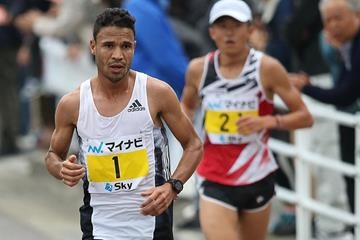
The manner in which samples were handled was questionable, it was also claimed, and Dazza argued that even if he had committed an anti-doping rule violation, a four-year ban was not the appropriate punishment.
The CAS rejected these arguments, upholding the four-year sanction, and also ordered Dazza to pay CHF4,000 (£3,170/$4,440/€3.560) - CHF1,000 (£790/$1,110/€912) to the CAS and CHF3,000 (£2,380/$3,330/€2,740) towards World Athletics' legal fees.
Dazza remains banned until January 10 2024, two months before he turns 33.
The Moroccan's results from May 4 2019 onwards - which includes winning both the Prague Marathon and Fukuoka Marathon - were also disqualified.
Marimuthu, who had won the Asian women's 800 metres title in 2019, tested positive for the anabolic steroid nandrolone in four separate samples.
This led to a four-year ban and the disqualification of results including at the Asian Athletics Championships in Doha.
Marimuthu appealed the decision to the CAS, arguing that the samples in question were unreliable as they has been handled incorrectly.
It was also claimed that Marimuthu had suffered a "spontaneous" miscarriage in January 2019 and that this, combined with having polycystic ovary syndrome, was the likely cause of abnormally high endogenous 19-norandrosterone.
The CAS rejected the appeal and upheld the four-year ban, with Marimuthu ordered to pay the CHF1,000 court office fee and stripped of the Asian 800m crown.
(05/08/2021) ⚡AMPby Ali Iveson
The first lady of Polish sport, Irena Szewinska
Only one athlete in history has set world records at 100m, 200m and 400m: Irena Szewinska – the brightest star of Polish athletics.
The first lady of Polish sport, as she was called by Poland’s president Andrzej Duda, is a five-time Olympian and seven-time Olympic medallist, with her achievements including three gold, two silver and two bronze medals.

Her Olympic journey
Szewinska was born in Leningrad in 1947 to a Ukrainian mother and Polish father. She moved with her parents to Warsaw when she was still a child.

At the age of 14 she started athletics at her school in Warsaw, where she was coached by Jan Kopyto, a former javelin thrower who competed at the Melbourne 1956 Olympic Games.
"I ran so fast in the school trials that the teacher requested a re-run because she thought she'd made a mistake in measuring the time,” Szewinska said in an interview with the Polish Press Agency.
The Polish sprinter made her Olympic debut at the Tokyo 1964 Olympic Games at only 18 years of age. Competing under her maiden name of Kirszenstein, she won silver medals in the long jump (6.60m) and the 200m (23.1).
She went on to win her first Olympic gold medal in the 4x100m – Poland’s second Olympic medal in that event after their bronze in Rome in 1960 and their first ever relay gold medal at the Games.
In 1965, she snatched the 100m world record (11.1) from USA’s Wyomia Tyus, who remained one of her strongest competitors over this distance for the next three years. That same season, Szewinska broke the 200m world record for the first time, running 22.7 in the Polish capital.
After earning a degree in economics from the University of Warsaw, Szewinska’s second Olympic appearance was in Mexico City in 1968.
“Things started badly for me in Mexico City,” she said. “I didn’t qualify for the long jump final, and my second event was the 100m which wasn’t my favorite event. Because of my height, I always start poorly, and by the time I was in full stride the race was over.”
She finished third in the 100m (11.18) behind the US one-two of Tyus and Barbara Ferrell. Szewinska then qualified for the 200m final after finishing third in her semifinal and lined up against a strong field.
In 1974, only two years after her first attempt at the 400m, Szewinska became the first woman to break 50 seconds with a hand-timed performance of 49.9 in Warsaw. The 400m women’s world records were recognised from 1957 but from 1975 onwards they had to be electronically timed.
The first electronically timed world record was set by Finland’s Riitta Salin, who ran 50.14. The first woman to run a sub-50-second electronic time was Christina Brehmer from East Germany who ran 49.77 in May 1976. This record only stood a month before Szewinska ran 49.75 on home soil.
Her Olympic and world record performance in the 400m remains the Polish record. She added a third Olympic gold medal to her collection, equalling Australian Shirley Strickland's record at that time of the most Olympic athletics medals won by a woman.
The spikes that she wore at the 1976 Games are now on display in the Museum of World Athletics™ – the world’s first 3D virtual sports museum.
In 1977, at 31 years of age, Szewinska was up for another challenge: lining up against Marita Koch at the inaugural IAAF World Cup in Dusseldorf.
Koch dominated the race but Szewinska, a renowned strong finisher, fought to the end to overtake Koch in the last 30 metres, winning in 49.52, her second best ever time.
Szewinska’s long athletics career ended after her fifth Olympic participation in Moscow in 1980. She pulled a muscle during the semifinals of the 400m which forced her to put an end to her Olympic journey. She retired from the sport soon after and gave birth to her second son in 1981.
Career transition
After a 16-year career in athletics, Poland’s most decorated Olympian transitioned to become a respected administrator in sports, giving back to the sport that she loved since her school days.
In 2012, she was inducted into the IAAF Hall of Fame. Four years later, she received the Order of the White Eagle, Poland’s highest award.
"Sport was a great adventure of my life, when I was an athlete and my fate was that I am still connected with sport. I am passionate about it, this is my hobby," she said.
On Friday 29 June 2018, Szewinska lost her long battle with cancer aged 72.
(05/08/2021) ⚡AMPby World Athletics
Saucony salutes moms in Mother's Day film
The past year has been a roller coaster, and no one has felt the brunt of this more than parents. Forced to play the roles of parent, teacher, employee and more, moms in particular have been pushed to their mental, physical and emotional limits. This Mother’s Day, Saucony is raising awareness of the strain that has been placed on mothers in their short film, The Marathon that Never Ends.
Saucony: The Marathon that Never Ends

https://www.youtube.com/embed/dn2Uu98XqbM?feature=oembed
According to a study conducted by Saucony’s consumer insight team, 57 per cent of mothers reported their well-being had gotten worse, 89 per cent said they are at least somewhat (if not extremely) burnt out and 77 per cent acknowledged their mental health has been the top contributor to burnout since the start of the pandemic. The film draws parallels between marathon running and motherhood, paying homage to all the moms who went the extra miles this past year, and explains how during the pandemic, many moms have faced more challenges and are bearing the brunt of childcare, housework and home-schooling.
One thing is for certain — mothers (and fathers, too!) deserve a badge of honour for the extra work they’ve put in this year. So this mother’s day, let’s join Saucony in thanking the mother and mother figures in our lives for everything they do.
(05/08/2021) ⚡AMPLauren Fleshman and Stephanie Bruce sell Picky Bars for $12 million
Picky Bars was founded in Bend, Oregon in 2011, and Laird Superfood began just down the road in Sisters, Ore. in 2015. The company was started by pro-big wave surfer Laird Hamilton, former pro-volleyball player Gabby Reece, and entrepreneur Paul Hodge. According to the announcement on Picky Bar’s website, Laird Superfood has a mission to “provide great-tasting, high-quality, plant-based products that are healthy, convenient, affordable and available to all.” Thomas said in a statement that the company is “beyond stoked” to be partnering with Laird, adding that they expect this acquisition to accelerate the company’s growth, expand their distribution, enhance their product development and create more jobs in their local community.
“Overall, coming together with LSF will increase the positive impact we can have on our communities and the world at large,” said Thomas. “We feel incredibly lucky to have found such an amazing fit for our team and brand.”

In an interview with Forbes, Hodge, the current CEO of Laird Superfood, said they believe Picky Bars produces the best, whole food bars in the world, and that the acquisition will round out their product lineup. It will also allow Picky Bars to expand their own distribution, getting the product into more stores across the U.S.
“Together, we can get nutritionally balanced options more geographically available, whether it’s experiencing a Laird product for the first time in a Picky Club box or tasting your first Ah, Fudge Nuts! Picky bar from a retailer distributing Laird products,” said Bruce.
For now, Fleshman, Thomas and Bruce will continue to lead the Picky Bars brand underneath the Laird umbrella. According to Forbes, the U.S. nutrition bar market is worth $10 billion, and the sports nutrition sector overall is expected to reach $33.03 billion in sales by 2028.
(05/08/2021) ⚡AMPby Running Magazine
After waking up in a pile of vomit right before XMAS, Irish 2:09 marathoner Stephen Scullion hasn't drank alcohol since
‘I didn’t even stay home for Christmas because I pretty much didn’t trust myself to stay and not drink again’
Olympics-bound Scullion opens up on ‘wise’ decision to bin booze as he continues pursuit of happiness

Stephen Scullion woke up in a pile of his own sick a few days before Christmas.
The Tokyo-bound marathoner was back home on holiday in Belfast.
“I had drunk way too heavily and had thrown up on the bed.
“I ended up booking a flight back to England the next day. So, I didn’t even stay home for Christmas because I pretty much didn’t trust myself to stay and not drink again.”
Scullion hasn’t touched alcohol since. His decision to quit was also influenced by a tweet posted by recent Oscar-winning Welsh actor Anthony Hopkins. “With gratitude, I celebrate 45 years of sobriety,” wrote Hopkins on December 29.
“I know how much it (alcohol) messes with my psychology, and I know it doesn’t help my running. I’m always running away from situations that probably I could end up being in where I would drink too much, go over the top.
“I tried to think of one time in my life where alcohol has actually done something good for my life, and I couldn’t think of one thing. I think I used to not drink because of running.
“Whereas this time, before Christmas, I made the decision I was going to do this for me. I do all this work to try (and) improve my mental health, try to be happy, and then to go ruin it, just by being greedy with alcohol. I just decided I don’t want to do this anymore.”
“Honestly, it’s not like I had a drink problem. The problem was I’m greedy. It’s not like I’m borderline alcoholic or anything like this.”
It was what happened after he drank that was the issue.
“I could drink and drink and drink and everyone thought I’m fine and in a great mood. And then my body decides I can’t process all this alcohol, because I normally live up a mountain like a saint.
“And here you are hammering 10 pints or 12 pints and shots, and yeah, then my body just rejects it, and I’d be incredibly low.”
Occasionally there were days when he couldn’t get out of bed because his “body was so broken from boozing”.
“It has just been a wise decision on my part. But I miss going and having a pint with my dad. I miss things like this because they are safe, and they are good.
“But the way I see it if I can’t handle it all then it is not worth it. I don’t want to go for a pint with my dad five times and think, ‘Oh, I’ve changed, oh, I’m better now, oh, I’m not greedy anymore’ because I know it will always be there.”
Scullion, who ran a career-best marathon time of 2:09.49 when finishing 11th in last October’s elite London, did seek professional help last year to cope with mental health issues.
“In September (2020) I reached out to the Sports Institute in Northern Ireland and said I wasn’t doing well. I was doing brilliant at running, that’s the easy part for me.
“I said I needed some help and they set me up with a sports psychiatrist in London. I spoke to the sports psychiatrist for three months and I started anti-depression medication after the London Marathon.
“If you take a hay fever tablet and run off into a field where there’s grass, you’re still probably going to have hay fever, and an anti-depressant medication tablet cannot fix everything. But I had to fix a lot of things in my life that gave me a chance to be happier. Sport is really tough and there’s a lot of pressure and you can put pressure on yourself, get a bit obsessed. I tweeted not long ago: ‘Do you exist, or do you live?’
“Part of being a really good professional is there are periods of time where you have to probably just exist. That means getting up early, doing your training, sleeping, resting, focusing on all the little details, because other people will do that.
“Other people are willing to go to places where they are probably not mentally stable or happy.
“If you want to be competitive, your life might not always be in balance. But in order for me to protect the longevity of Stephen Scullion and so that Stephen Scullion’s career flourishes in three or four or five years’ time, when I can be the best possible athlete I can be, I need to move away from that existence every now and again and live.”
For Scullion, ‘living’ is going to visit his parents’ allotment in Belfast where they raise chickens and grow potatoes and onions.
“That, to me, is living,” he says.
Running-wise, Scullion is performing better since undergoing surgery to correct a breathing issue which was diagnosed as asthma 15 years ago.
A London-based specialist, Dr James Hull, suggested he had a condition called exercise-induced larynx obstructions (EILO).
“The condition means your vocal cords are working against you almost, as you breathe, closing your airways and creating the wheezing effect. Asthma is supposedly wheezing on the exhale, whereas I wheeze on the inhale.”
The surgery in London was a success. So much so that in terms of his running he feels he has been set free.
Now his focus is on the Olympic marathon in Sapporo on August 8.
(05/08/2021) ⚡AMPObiri and Gidey ready for 3000m showdown in Doha
Two-time world 5000m champion Hellen Obiri and world record holder Letesenbet Gidey will resume their rivalry when they line up over 3000m at the Wanda Doha Diamond League on Friday 28 May.
Obiri, the world cross-country champion, set a Kenyan 3000m record of 8:20.68 in Doha in 2014. She also won over the same distance at the Doha Diamond League in 2019 and 2020.

Gidey smashed the world 5000m record in Valencia last year, clocking 14:06.62. Although Obiri leads their career head-to-head record at 9-5, Gidey has finished ahead of Obiri twice in Doha: at the 2018 Diamond League meeting and at the 2019 World Championships over 10,000m.
“I’m happy to start my season in Doha,” said Gidey, who in 2019 broke Obiri’s African 3000m record with 8:20.27. “It will be my first race as a world record-holder and I feel excited to see where I am in terms of condition. It will be a very important stepping stone towards the Olympic Games later in the season.”
Obiri, who defeated Gidey in their most recent clash over 5000m at the 2020 Monaco Diamond League, said: “After my half marathon debut in April (she ran 1:04:51 in Istanbul) I’m looking forward to getting back on the track, especially at the Doha Diamond League meeting where I will be going for my fourth 3000m win. I ran the Kenyan record there in 2014 (8:20) and the second-fastest 3000m in my career there last September (8:22).
“Doha is also the place where I won my last world title in 2019, but this year it is all about the Olympic Games as that is the only major gold medal that I’m missing and I’m working hard to change that this year. The 3000m and 5000m races are very competitive at the moment and I expect we will see some fast times in the next few months and in Tokyo.”
The 2021 Wanda Diamond League comprises 14 meetings – starting with Gateshead (replacing Rabat as the first host city on this year’s circuit) on Sunday 23 May – leading to a single final across two days in Zurich at the end of the season. Each meeting will be broadcast globally in a live two-hour programme.
The 2021 calendar remains subject to change depending on the global health situation in the coming months.
(05/08/2021) ⚡AMPby World Athletics
The International Olympic Committee and Pfizer to donate vaccines to Olympic athletes
Earlier this year, the International Olympic Committee (IOC) and Olympic officials in China announced their agreement to buy and distribute Chinese vaccines to athletes ahead of the Tokyo Games and the 2022 Beijing Winter Olympics. This week, vaccine developers Pfizer and BioNTech have announced they will be donating doses to athletes and officials preparing for the Games to add an extra layer of safety to what many are calling a potential “super spreader event.”
This new deal with Pfizer will give the IOC greater worldwide coverage to have athletes vaccinated, since many countries have not yet authorized the Chinese vaccines for use. Doses will start being delivered this month in hopes that there will be enough time for athletes and officials to receive two doses before arriving in Tokyo. Vaccination will not be mandatory for anyone attending the Games, but IOC president Thomas Bach is encouraging all delegations to take part in the rollout.
“We are inviting the athletes and participating delegations of the upcoming Olympic and Paralympic Games to lead by example and accept the vaccine where and when possible,” he said in a statement.

Canadian Olympic Committee (COC) CEO David Shoemaker has also voiced his approval of the decision, saying that this will provide an “important layer of protection for Canadian athletes in the lead up to and during the Games.” The Canadian Olympic team and its constituents are expected to make up approximately 1,100 people.
“The Olympic Games hold special meaning for the millions of Canadians who will be inspired by the resilience and determination of Canadian athletes this summer in Tokyo. As most provinces begin vaccination of the general population, this announcement will help more Canadians receive vaccinations quicker,” Shoemaker said.
Until now, the COC had maintained that Canadian athletes would not be jumping the queue in Canada’s vaccination rollout, but according to The Guardian, the IOC has made it clear that vaccines going to athletes and staff would not be taken from existing programs, but would “be in addition to existing quotas and planned deliveries around the world.”

With the vaccine rollout in Canada beginning to pick up steam, many Canadian athletes are already receiving their first doses without the Pfizer donation. In fact, the COC’s chief medical officer, Dr. Mike Wilkinson, has already told the Canadian Press he expects the entire team to have received at least their first dose before Tokyo.
Many people around the world have criticized the decision, arguing that vaccine donations should be sent to places like India, where COVID-19 infections have risen dramatically, but others have said that vaccinating athletes will prevent them from bringing the virus home to their communities.
“Anybody who says they should donate them to India or teachers, I get it, I would not argue with that. I understand, it’s very personal,” said Athletics Canada’s CEO David Bedford. “But I also believe that these athletes and the support staff are protected. And fortunately, the good news is that Pfizer and BioNTech have said this isn’t coming out of any allocations to countries.”
As the Games get closer, there is still a lot of opposition from the Japanese public, many of whom wish to have them cancelled. As of now, however, it seems that the Olympics will be going ahead, and having as many athletes as possible vaccinated may be the best way to ensure they can happen safely.
(05/07/2021) ⚡AMPby Brittany Hambleton
Tokyo 2020 Olympic Games
Fifty-six years after having organized the Olympic Games, the Japanese capital will be hosting a Summer edition for the second time, originally scheduled from July 24 to August 9, 2020, the games were postponed due to coronavirus outbreak, the postponed Tokyo Olympics will be held from July 23 to August 8 in 2021, according to the International Olympic Committee decision. ...
more...Ryan Polawski raises $34,000 for rehab center after 100-mile run to Toronto and back
Hamilton’s Ryan Polawski set out on a 100-mile journey on April 30, running to Toronto and back home, where he crossed his finish line on May 1. Polawski organized this event, which he dubbed Ryan’s Run for Hope, to raise money for Teen Challenge, a rehabilitation organization that has helped him and countless other individuals overcome addiction. He completed the run, which ended up being about 168K, in 23 hours, and his fundraiser (which is still live now) currently sits at more than $34,000.
The three biggest challenges on the run, Polawski says, were created by wind, pavement and nutrition concerns. “I had a tailwind of 70 or 80 clicks for about that first 50K,” he says. “It made that stretch feel super easy, but it was tough at the same time, because the wind pushed me to increase my cadence.” When he changed directions and hit the headwind, Polawski says it was “like running into a brick wall.”

Next up was the pavement, which took its toll on Polawski’s body. The farthest he had run before this was 50K, so his legs were already due for a beating as he prepared to travel more than 100K farther. Running on hard pavement for 100 miles, though, made things even more difficult. “The pavement killed my IT bands,” he says. Fortunately, he had the support of a Dr. Anthony Lombardi, a chiropractor from the Hamilton Back Clinic who met up with Polawski along the route to and from Toronto to treat him and work out any kinks.
Finally, there was the matter of nutrition. Polawski did really well with his nutrition plan for the run, and he says he felt great in terms of energy until about the 130K mark. “I ate food up until about two hours before the run,” he says. “I was so bloated when I started, but I knew I had to load up so I wouldn’t bonk.” While out on the run, he continued to fuel, even though eating was the last thing he wanted to do.

“You’re not hungry, but you have to eat,” he says. “I had at least two gels an hour, some protein bars and bananas.” He also drank pickle juice to keep his sodium levels up, and there were a few pitstops where he forced down multiple doughnuts. Eating this much was extremely difficult, Polawski says, but it worked out well, and he didn’t feel low on energy until he was into the final quarter of the run.
Up until that point, he had made a point not to drink any coffee or Red Bull, noting that he “stayed away from caffeine until it was absolutely necessary.” After 130K, he knew it was time to add those drinks to his nutrition plan, and they gave him enough of a boost to carry him to the finish line at Hamilton City Hall.
After 168K and 23 hours of running, Polawski made it to the finish, at which point he had raised more than $20,000 for the Teen Challenge. That number keeps climbing, and by Monday, just a couple of days after his run, his fundraiser had hit $30,000. It’s now well over $34,000 and still growing, which is why Polawski plans to keep the fundraiser open for donations through the entire month of May.
(05/07/2021) ⚡AMPby Ben Snider-McGrath
Joshua Cheptegei and Monto Duplatis are set to make Czech debut in World Athletics Continental Tour Gold meeting, in Ostrava on May 19
World record-holders Monto Duplantis and Joshua Cheptegei, along with world U20 record-holder Sha’Carri Richardson, will compete in the Czech Republic for the first time in their careers when they line up at the Golden Spike, a World Athletics Continental Tour Gold meeting, in Ostrava on May 19.
This year’s Golden Spike will be the 60th edition and the line-up of top names already announced for the competition will ensure that the meeting will be a memorable one.
Duplantis, the Male World Athlete of the Year, will have one eye on breaking the meeting record in the pole vault.
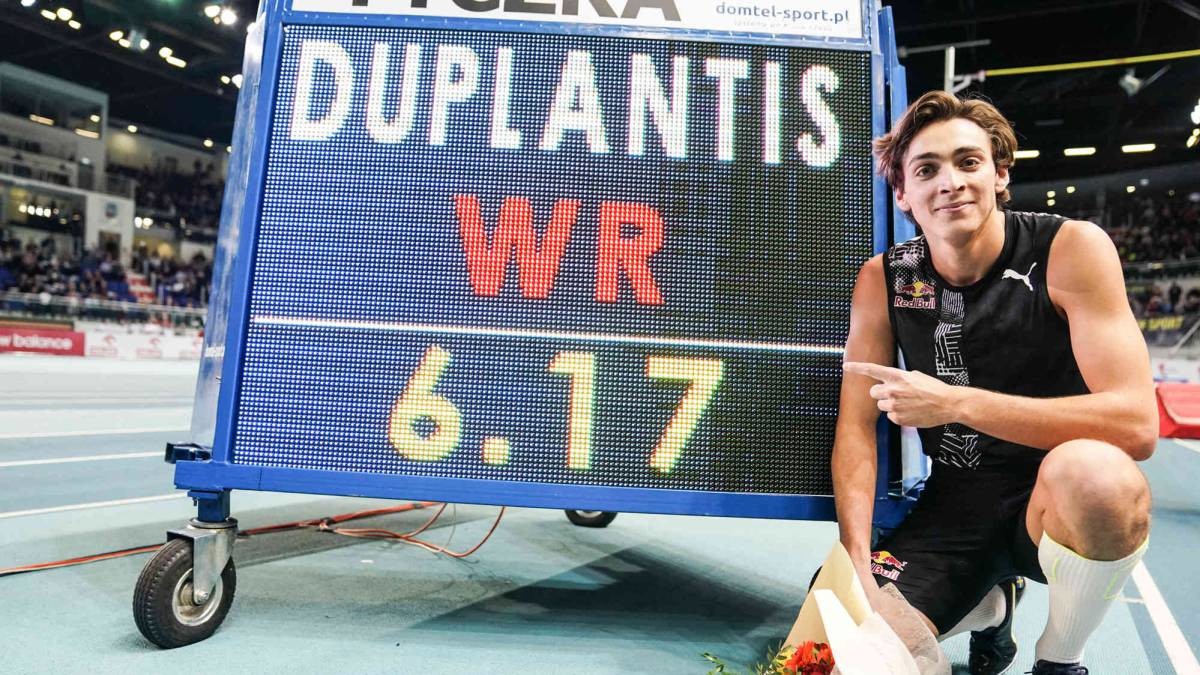
“Ostrava will be my first outdoor competition in Europe and I am really looking forward to jumping for the first time in the Czech Republic,” said Duplantis, who will compete against two-time world champion Sam Kendricks in Ostrava. “My training and preparation back home in Louisiana has gone very well so I feel confident and hope for good conditions.”

Cheptegei, who last year set world records over 5000m and 10,000m, will step down to the 3000m in Ostrava. His best for that distance is 7:33.26, but the meeting record of 7:31.66 looks to be within reach for the world 10,000m and cross country champion from Uganda.
Richardson has already started her year in fine form. She sped to a lifetime best of 10.72 over 100m in Miramar last month, then clocked a season’s best of 22.11 over 200m one week later, just 0.11 shy of the PB she set last year.
The 21-year-old will contest the 200m in Ostrava and will face multiple world and Olympic 100m champion Shelly-Ann Fraser-Pryce and two-time world champion Dafne Schippers.
Canada’s world and Olympic medallist Andre De Grasse is confirmed for the men’s 100m, while three-time world indoor champion Pavel Maslak will go in the 400m.
World record-holder Barbora Spotakova and European indoor shot put champion Tomas Stanek are among the other leading Czech athletes who’ll be in action on 19 May. Spotakova will take on fellow Czech javelin thrower Nikola Ogrodnikova, while 2017 Diamond League winner Jakub Vadlejch will contest the men’s event.
Other confirmed Czech stars include two-time world 400m hurdles champion Zuzana Hejnova, long jumper Radek Juska, middle-distance runners Jakub Holusa and Filip Sasinek, and decathlon specialist Adam Sebastian Helcelet.
As was announced last week, world hammer record-holder Anita Wlodarczyk and 2017 world javelin champion Johannes Vetter are also confirmed to compete in Ostrava.
The Golden Spike was granted an exemption from the Czech Republic’s ban on holding mass events, and the meeting is permitted to welcome 1500 fans into the stadium.
(05/07/2021) ⚡AMPby World Athletics
2021 Grandma's Marathon receives green light for 45th annual marathon plus half marathon and 5K, races will be held as scheduled
The 45th annual Grandma’s Marathon weekend has received the green light for June, which comes as Minnesota Gov. Tim Walz announced Thursday a loosening of the state’s public health guidelines.
“This is a great day not just for Grandma’s Marathon but for our community as well,” Executive Director Shane Bauer said. “So many people had a hand in making this event a reality this year, and to be here today with the final approval is a testament to the effort everyone’s put in. Our staff can’t thank our state and local partners enough for their tireless work, and we look forward to once again welcoming our participants to the unofficial kickoff to summer in Duluth.”

Grandma’s Marathon and the Garry Bjorklund Half Marathon are scheduled for Saturday, June 19, with the William A. Irvin 5K being run the night before.

“I am so excited to welcome Grandma’s Marathon back to the streets of Duluth,” Duluth Mayor Emily Larson added. “Last year many of us participated in Grandma’s virtual races — I loved the flexibility Grandma’s awarded us as runners, but it’s just not the same as the Canal Park finish. It’s truly one of my favorite days in the year. We are thrilled to welcome runners back to Duluth and participate in a safe and well-planned event.”
While the updated state guidelines provide a clear path forward for the 2021 Grandma’s Marathon, organizers say more specific updates as to how they will change the current race weekend plan will be announced in the coming days.
(05/07/2021) ⚡AMPby News Tribune
Grandmas Marathon
Grandma's Marathon began in 1977 when a group of local runners planned a scenic road race from Two Harbors to Duluth, Minnesota. There were just 150 participants that year, but organizers knew they had discovered something special. The marathon received its name from the Duluth-based group of famous Grandma's restaurants, its first major sponsor. The level of sponsorship with the...
more...World Marathon champ Ruth Chepng'etich eyes stellar Olympics show
Last month, Chepng'etich tore the field apart to win the Instanbul Half Marathon in one hour, four minutes and one second (1:04:02), smashing the previous world record held by Ethiopian Ababel Yeshaneh by 29 seconds.
Speaking Thursday at the Athletics Kenya offices, Nairobi after receiving the LG/Sports Journalist Association of Kenya (SJAK) Sports Personality of the Month Award for April, Chepng'etich is confident of a good outing at the Summer Games.
"I resumed training last week with focus on Olympics and so far I'm doing great. I really don't want to look at who I will be competing against, but I'm focusing on myself. With hardwork, discipline and dedication, everything is possible.It's always such a great feeling when your efforts are recognised. This award is timely and a great motivation ahead of the Olympics," a visibly jubilant Chepng'etich said.

The 26-year-old received a state-of-the-art LG Artificial Intelligence (AI) DD washing machine worth Sh92,000.
Veteeran coach Julius Kirwa said that he was closely following Chepng'etich's training program and remained optimistic of good results in Tokyo.

Chepng’etich beat Equator Rally winner Carl "Flash" Tundo, Eliud Kipchoge, who won the NN Mission Marathon in Enschede, Holland in 2:04.30 and Kenya Ports Authority Libero Sam Juma to the award.
Other nominees were Meldine Sande, who led Kenya Prisons women's volleyball team to third position at the African Clubs Championship in Tunisia and rugby star Daniel Taabu, who scored 7 tries for Kenya Sevens at the Emirates Invitational in Dubai.
Chepng’etich joins the growing list of sportsmen and women to have won the coveted title this season.
Other winners are tennis superstar Angela Okutoyi (January), basketballer Tylor Okari Ongwae of Kenya Moran's (February) and boxer Elly Ajowi (March).
LG Electronics Corporate Communications manager Maureen Kemunto noted that the company is proud to be a part of an initiative which rewards excellence.
"Our partnership with SJAK goes a long way in bolstering athletes talent and empowering them to be the backbone of sports in the country. Being an Olympic year, sports personalities are giving their all to uphold higher standards hence the need to motivate their efforts"
SJAK President Chris Mbaisi, on his part, thanked LG Electronics for their unswerving support, saying the partnership continues to make a gigantic difference in the promotion of sporting activities across the country.
(05/06/2021) ⚡AMPTokyo 2020 Olympic Games
Fifty-six years after having organized the Olympic Games, the Japanese capital will be hosting a Summer edition for the second time, originally scheduled from July 24 to August 9, 2020, the games were postponed due to coronavirus outbreak, the postponed Tokyo Olympics will be held from July 23 to August 8 in 2021, according to the International Olympic Committee decision. ...
more...Don’t let blisters ruin your run
We’ve all been there: a couple miles into what was supposed to be a long outing on the trail, you feel the hot spot burning inside your shoe. A damn blister. Maybe you’re in ill-fitting new shoes or bunchy socks that caused your feet to sweat. Maybe you just have blister-prone feet. Either way, a skin bubble can put an end to an otherwise great day—or lead to some serious discomfort.
Vonhof is a former paramedic and an ultrarunner who now works the medical tents at races like California’s 100-mile Western States Endurance Run and the Badwater 135, as well as Decaman, a series of ten back-to-back Ironmans in New Orleans. He gave us his best advice on blister prevention and treatment.

Take Blisters Seriously

They always seem tiny and innocuous, but they can be day enders. “Even a blister the size of a pea in the wrong spot—at the base of the toe or ball of the foot—can disrupt your gait, meaning pain could go up into your knees or your back,” says Vonhof. “Blisters can seem very minor, but if you don’t take care of them, they can get larger.” He has seen instances where a runner pushed on through a hot spot, not bothering to stop and treat it, and instead of a quarter-inch inflammation, the runner was left with a two-inch bulge covering the whole arch of their foot. Once ripped, a blister leaves a huge patch of raw, exposed skin rubbing the inside of the shoe—not a comfortable situation.
Know the Causes
It’s generally understood that pressure, friction, heat, or moisture can cause blisters to form. When layers of skin and bones move against each other, the inner connections can break down, and a fluid-filled cavity forms. There are a few simple rules to help avoid blister-causing situations. “The most important thing is fit,” Vonhof says. Not enough room in the toe box or too much space in the heel can cause pinching or shifting. Also, Vonhof says, “Skip the cotton socks.” Technical, breathable wicking blends that stay in place are key. We can recommend a few: Balega Blister Resist socks prevent clamminess and eliminate friction, Drymax makes a collection of socks for runners that keep your feet moisture-free, and Injinji’s toe socks keep your digits from rubbing. Mileage matters, too. If you try to run 50 miles off the couch, you’ll probably wind up with blisters. But steadily add distance with a training plan and your feet will thank you.
Prep Your Feet
Proper foot care means good preparation, according to Vonhof. Before a big run or hike, he recommends reducing calluses, trimming and filing toenails, and getting proper insoles for your shoes. If you’re racing long distances, plan to change your socks often, air your feet out at regular rest stations, and carry a foot-care kit (Trail Toes makes a prepackaged blister kit). If you clench your toes, work to relax your feet while running. If you’re prone to blisters or are running ultramarathons, taping problem areas in advance might be a good idea. At Badwater, Vonhof regularly pretapes the entire bottom of a runner’s foot, and he recommends Leukotape K Kinesiology tape since it stays put and molds easily. If you’re running in wet conditions or your dogs tend to sweat, apply a layer of protective, moisture-managing cream, like RunGoo, before putting on your socks. Vonhof likes Squirrel’s Nut Butter Anti-Chafe salve for slathering between toes or on heels to prevent irritation.
Ditch the Moleskin
People used to rub Vaseline on a blister, then cover it with a doughnut-shaped piece of moleskin. These days, Vonhof prescribes lancing. “It’s a debate. Should you lance the blister and get the fluid out or leave it?” Vonhof says. “Sometimes it’ll pop on its own. If it’s in an area where you’re going to continue to put pressure on it while you run or hike, you’re better off lancing it.” To do that, he recommends cleaning the skin first, then piercing it in two places with a sterile pin or needle—a safety pin, tweezers, or pocketknife sterilized with a flame or vodka will work. Gently push the fluid out. (Gravity will also help the blister drain.) Then apply an antibiotic ointment, like Neosporin, and put 2nd Skin or KT tape over the top. Standard Band-Aids don’t stick well and tend to shift.
(05/06/2021) ⚡AMPby Megan Michelson
ASICS blue jeans organized a free virtual mile race that you can run until the end of May, but run the mile event in jeans is a must
ASICS has organized a free virtual mile race that will run from now until May 31, but there’s a catch: everyone participating has to run in jeans. The ASICS Blue Jeans Mile was inspired by American middle-distance runner Johnny Gregorek, who set a world record when he ran a mile in 4:06.25 while wearing jeans in a 2020 fundraiser for the National Alliance on Mental Illness (NAMI) in the U.S.
This year, the event is open to anyone who wants to race, and while it’s free to enter, participants are encouraged to donate to mental health initiatives, including Canada’s Center for Addiction and Mental Health (CAMH).

Gregorek is one of the fastest milers in the U.S. right now, and he owns the American indoor mile record of 3:49.98, a time he set in 2019. He decided to trade his split shorts for blue jeans in 2020 to honour his late brother, Patrick, who passed away in 2019 at the age of 21 after struggles with mental illness. Gregorek set out to break the blue jean mile world record, which at the time stood at 4:11.80, and raise money (he set his fundraising goal at $2,500) for NAMI. He ended up smashing the record and his fundraising goal, as he ran 4:06.25 and raised more than $37,000.

This year, the event’s fundraising efforts have already eclipsed Gregorek’s total from 2020 thanks to a $40,625 donation from ASICS to NAMI.
ASICS donated that exact sum to represent world record result that Gregorek, an ASICS-sponsored runner, ran last year. The virtual race opened on May 1, and so far, thousands of dollars have been raised on top of the donation from ASICS, with a little over $6,500 tallied for NAMI by American participants and close to $3,000 for CAMH by Canadian runners.
Alongside Gregorek’s world record is the women’s mark of 4:58.84, which American Heather Wilson (who owns a regular mile PB of 4:29.39) set in 2017. If you think you can challenge either of these records, register for the run, toss on a pair of jeans and give it a shot. Even if you don’t think you have what it takes to become the new world record holder, it’ll be fun to run all-out in a pair of jeans. You might get some funny looks, but it’ll be worth it.
(05/06/2021) ⚡AMPby Ben Snider-McGrath
2021 Boston Marathon field with biggest time cutoff in event history
Qualifying for the Boston Marathon was harder than ever this year, as the Boston Athletic Association (B.A.A.) announced on Tuesday that runners hoping to compete in the famous race had to run seven minutes, 47 seconds faster than their age group qualifying times. This is a huge cutoff time, coming in a whopping six minutes faster than the cutoff of one minute, 39 seconds that the B.A.A. set ahead of the 2020 race.
This year’s cutoff has led to 9,215 runners receiving the unfortunate news that they have not been accepted for this year’s event despite having run under the original qualifying standard.

It’s already tough to get into the Boston Marathon, and the B.A.A. continues to lower age group qualifying times as demand for the storied race increases. In 2013, qualifying standards were lowered by five minutes per age group, and these times stood until 2019. Then, ahead of the 2020 race, the bar was lowered (or raised, seeing as qualifying got tougher), by another five minutes.
Over the previous 10 races, despite quickening qualifying times, cutoffs were still necessary, as there were thousands more qualified runners than the race capacity. From 2012 to 2017, the time cutoff wasn’t too big, and Boston hopefuls only had to run a maximum of two minutes, 28 seconds faster than their age group qualifying time. Even so, these cutoffs led to thousands of runners left out of the race each year, with more than 4,000 qualified athletes missing out in 2016.

In 2018, the cutoff jumped to three minutes, 23 seconds, and more than 5,000 runners were left off the start list. The next year, 7,200 runners missed the cutoff, which had been raised to close to five minutes. There was a dip in 2020, and the cutoff dropped to one minute, 39 seconds, but it shot right back up to seven minutes, 47 seconds, setting the bar higher than ever before for anyone hoping to race in Boston.
The pandemic is a big reason for this huge cutoff time. In the past decade, the smallest Boston field size has been 27,000 runners, and that was in 2011 and 2012. Since then, the field hasn’t been smaller than 30,000 runners. This year, due to COVID-19, the field has been reduced to just 20,000 runners — a field size the race hasn’t seen since the early 2000s. With demand for the race as high as ever, that meant the B.A.A. had to make the tough call to implement an unprecedented cutoff time, resulting in close to 10,000 runners not being accepted.
The B.A.A. accepted 14,609 runners who met the cutoff, and the additional few thousand spots will be filled by elites and invited athletes who are running as part of the Boston Marathon’s Official Charity Program and John Hancock’s Non-Profit Program.
(05/06/2021) ⚡AMPby Ben Snider-McGrath
Boston Marathon
Among the nation’s oldest athletic clubs, the B.A.A. was established in 1887, and, in 1896, more than half of the U.S. Olympic Team at the first modern games was composed of B.A.A. club members. The Olympic Games provided the inspiration for the first Boston Marathon, which culminated the B.A.A. Games on April 19, 1897. John J. McDermott emerged from a...
more...World Athletics president Sebastian Coe expects Tokyo Olympics to go ahead after test event in Japan
The World Athletics president, Sebastian Coe, says he understands the nervousness in Japan over hosting an Olympics during a pandemic – but believes the Games will go ahead safely after attending a half marathon test event in Sapporo on Wednesday.
Japan is battling a resurgence in coronavirus infections and opinion polls consistently find the majority of the public is opposed to the Games, which are due to open on 23 July.
Those concerns have been exacerbated by a slow vaccine rollout, with much of the country also under a state of emergency, and Coe said he recognised that many Japanese people had concerns.
“We take that nervousness very, very seriously,” he said. “We have Covid protocols that have been tried and tested, and I’ve witnessed them here. We take very seriously the health and wellbeing of local communities.”

“But the challenges are big. I don’t believe any Olympic Games has been delivered under more difficult circumstances. These Games have an overlay of complexity that is beyond most comprehension.”
There was a muted atmosphere during the test event as security guards stood with signs around their necks asking people to “please refrain from watching the race” to prevent infections.
However, a few onlookers ignored their pleas and clapped as Kenya’s Hillary Kipkoech won the men’s race in 1hr 46sec and Japan’s Mao Ichiyama won the women’s race in 1hr 8min 28sec.
Tokyo 2020’s deputy executive director of games operations, Yasuo Mori, said no one had tested positive for Covid-19, with the 69 athletes made to stay in hotels with no contact with the public.
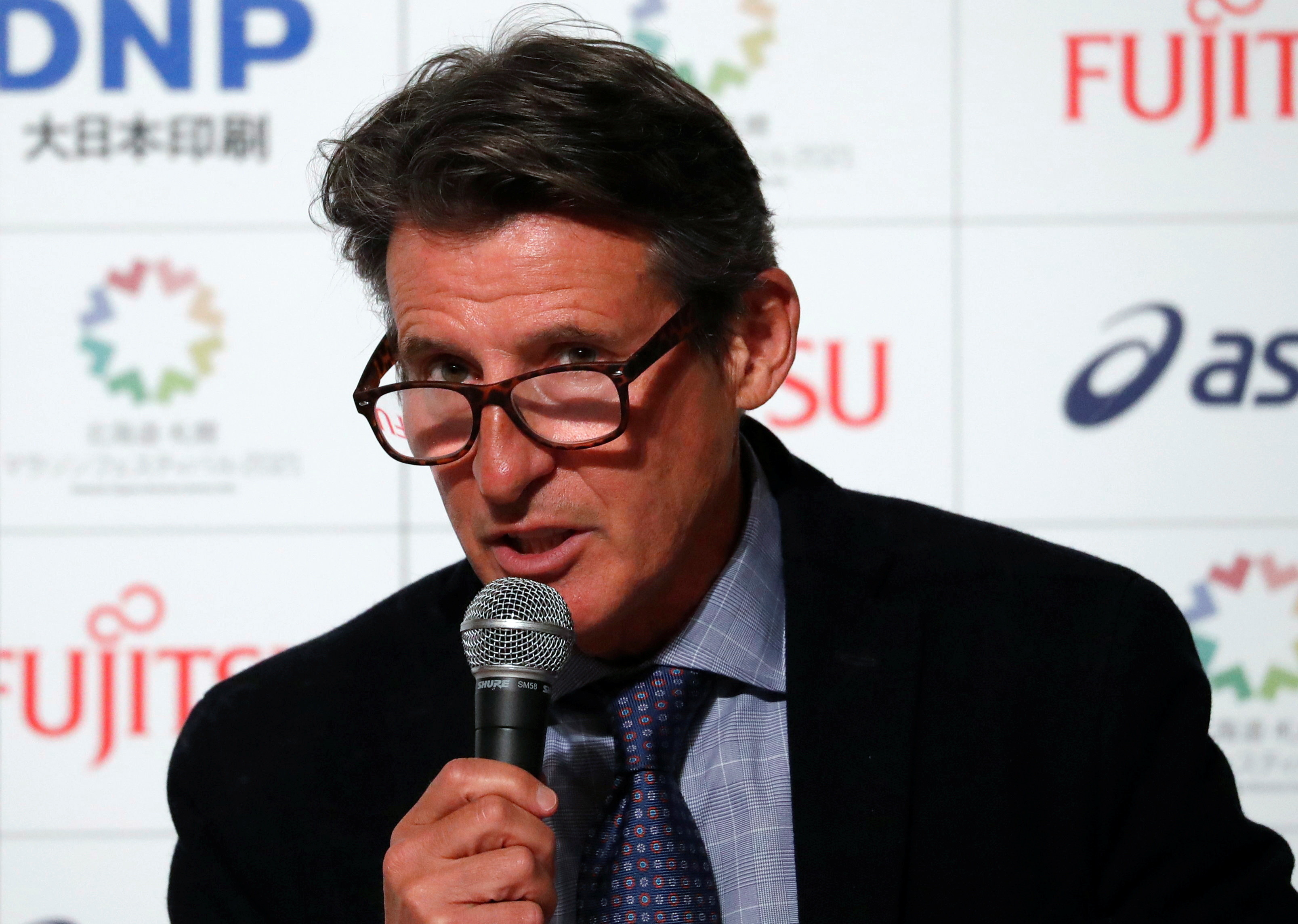
Organizers will decide next month whether fans can attend events, but supporters from abroad have already been banned. However, Coe said that even if there were no crowds in stadiums “the Games will still take place and the competition will still be extremely good”.
Coe, who was head of the 2012 London Olympics, said it was “really important that when the world looks to coming out of Covid that it can see optimism.
“ The Olympic Games and the Paralympic Games will be totemic of that optimism and hope going forward. So it is important that the Games are delivered successfully and they’re delivered safely.”
Tokyo is officially spending £11.1bn to hold the Olympics, but some estimates say it is twice that much. The IOC is pushing on with the Games, partly because 73% of its income is from selling broadcast rights.
(05/05/2021) ⚡AMPby Sean Ingle
Tokyo 2020 Olympic Games
Fifty-six years after having organized the Olympic Games, the Japanese capital will be hosting a Summer edition for the second time, originally scheduled from July 24 to August 9, 2020, the games were postponed due to coronavirus outbreak, the postponed Tokyo Olympics will be held from July 23 to August 8 in 2021, according to the International Olympic Committee decision. ...
more...Hong Kong’s Christy Yiu to take part in Milan Marathon hoping to achieve Olympic qualification
Hong Kong running star Christy Yiu Kit-ching has been thrown a lifeline in her stuttering Olympic qualifying campaign after being handed an invite to take part in next weekend’s Milan Marathon – her first marathon race in 22 months.
Yiu’s hopes to qualify for this summer’s Tokyo Olympics have been thrown in disarray since the pandemic threw the world sporting calendar upside down in 2020.
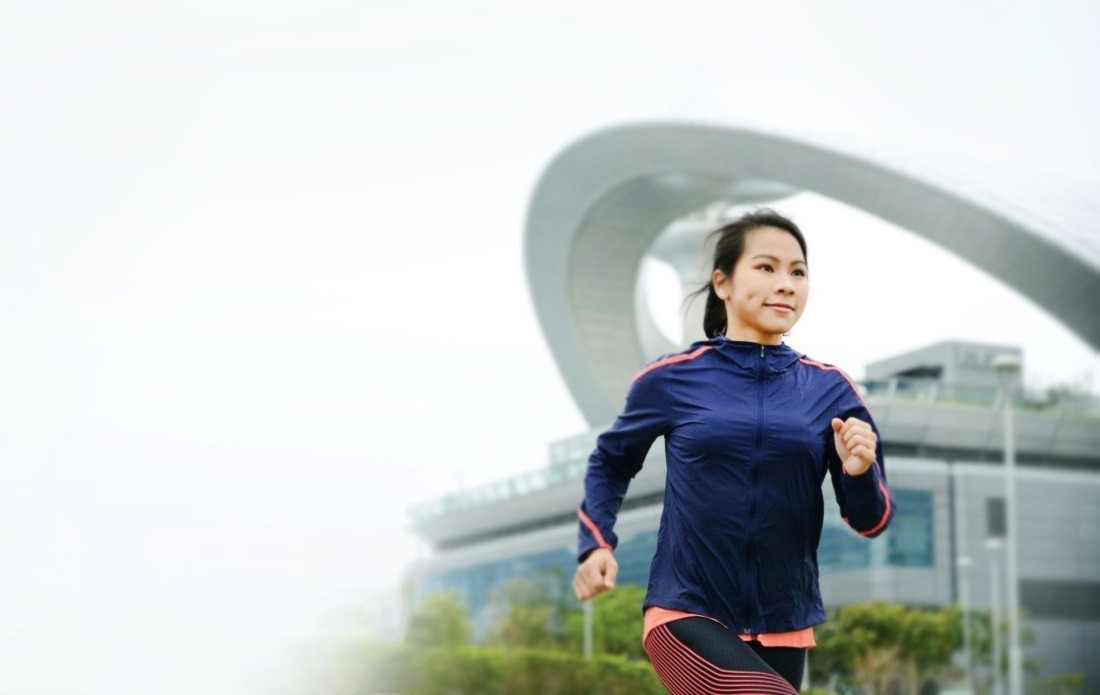
The 33-year-old long-distance runner needed assistance from the world governing body to save her Olympic qualification campaign after every race she wanted to compete was either cancelled or she was rejected because of Covid-19 restrictions.

The Rio Olympian has been struggling to get a single racing opportunity after competing in the 2019 Gold Coast Marathon and she desperately wants to compete overseas in her bid to qualify for her second Olympics.
A senior local official shared Yiu’s frustrations but said she might finally get the opportunity to compete again in the marathon after months of anxiety.
“Yiu needs to reach the [Olympics] entry mark but unfortunately she has been denied the opportunity one race after another after competing in Australia and this is mainly due to the pandemic,” said Hong Kong Association of Athletics Affiliates chairman Kwan Kee. “The event she has supposed to compete was this month’s Copenhagen Marathon in Denmark but that was called off in late April due to Covid-19 safety measures in the city.
“We have found the Milan Marathon, which is opened to invited athletes and after seeking assistance from World Athletics and the local organisers for the event, we were able to obtain a spot for her. And there is no need for her to do the quarantine when she arrives in Milan.”
The Milan Marathon, which will take place in the northern Italian city on May 16, will be run on a fast circuit of 7.5 kilometres with runners running around it five times. The hub will be Piazza del Cannone, in front of Castello Sforzesco, the famous castle that was built in the 15th century by Francesco Sforza.
(05/05/2021) ⚡AMP
by Chan Kin-wa
Milano Marathon
Passion is what allows us to go beyond our limits. It’s what makes us run when our heath is bursting in our chest, it’s whats makes our legs move even if they’re worn out. It’s passion against sacrifice, and the winner will be declared though hard training, hearth and concentration. Milano Marathon has been presented in the futuristic Generali Tower,...
more...Vaccination is key for Dublin Marathon to allow all 25,000 entries to compete
The fate of this year’s KBC Dublin Marathon will be decided next month, with race director Jim Aughney saying the chance of all 25,000 entries being allowed to take part is “slim."
Under current proposals, all participants, staff, and volunteers will be subjected to antigen testing before arriving at the race venue, and Aughney says the final field size will be decided on June 25.

“For athletes that has to be a D-day,” said Aughney. “To be fair to the runner and to ourselves you need that four-month lead-in. By the 25th (of June) we’ll be able to say whether the event is on and we’ll have X or Y participants.”

Aughney admitted “vaccination is key” for the successful staging of the event but he has little idea what size field might be possible on 24 October.
“The chances of 25,000 being allowed to run in the streets of Dublin might be slim but we’d be delighted with any number,” he said.
“With any of these events you’re going to be restricted to smaller numbers, if we can get 10,000, 15,000, it’d be great news for the city, for the runners.”
Aughney expects to run a test event in the summer to demonstrate to “the HSE, the government, and whoever needs to see” the mechanisms that will allow the event to held safely.
“We have to make sure everyone has passed a test to run the event,” he said.
The race organization has taken a huge financial hit due to its cancellation in 2020 and while the entry fee has remained the same – with last year’s entries carried forward – Aughney acknowledges it will be significantly more expensive to host.
Through Athletics Ireland, the race applied for financial assistance to Sport Ireland to alleviate the costs but “it didn’t go anywhere,” said Aughney. “We didn’t get any funding from Sport Ireland or any of the other authorities that give out funding.”
(05/05/2021) ⚡AMP
by Cathal Dennehy
KBC Dublin Marathon
The KBC Dublin Marathon, which is run through the historic Georgian streets of Dublin, Ireland's largest and capital city.The course is largely flat and is a single lap, starting and finishing close to the City Centre. Conditions formarathon running are ideal....
more...Japan’s Mao Ichiyama and Kenya’s Hillary Kipkoech storm to half marathon PBs at Olympic test event in Sapporo
Japan’s Mao Ichiyama and Kenya’s Hillary Kipkoech cruised to half marathon PBs on the grounds of Hokkaido University in Sapporo on Wednesday, at the official test event for the Tokyo Olympics road races.
The course is similar to the first half of the marathon route that will be used for this year’s Olympic Games, and the race attracted a small elite field comprising some of Japan’s leading marathon contenders along with a handful of international athletes who were keen to get a feel for the streets of Sapporo.
Ichiyama, who booked her spot on Japan’s Olympic marathon team after winning in Nagoya at the end of 2020, fellow Olympic team member Ayuko Suzuki and team reserve Matsuda Mizuki set off at a swift pace alongside three male pace makers, passing through the first 5km in 16:10.

Their pace eased slightly approaching the half-way point, having reached 10km in 32:39, but they picked it up again at the start of the second half and covered the next five-kilometer section in 15:48.
Suzuki stuck with her compatriots until the final few kilometers and, unable to match their pace, started to drift behind. With about two kilometers to go, Ichiyama opened up a gap of about 25 meters on Mizuki and still looked extremely comfortable. The gap didn’t grow significantly in the closing stages, but Ichiyama did just enough to keep her opponent at bay.

Ichiyama crossed the line in a PB of 1:08:28 with Mizuki following close behind in 1:08:32. Suzuki finished third in 1:08:53.
Honami Maeda, who won Japan’s Marathon Grand Championship race in 2019 to secure her Olympic spot, ran solo for much of the race, in between the lead trio and the main chase pack. She was overtaken by Germany’s Katharina Steinruck in the final kilometer as Steinruck finished fourth in 1:10:43, seven seconds ahead of Maeda.
Kipkoech, who clocked a world-leading 27:35 for 10km just 11 days prior, broke away from the rest of the men’s field just before the half-way point. He passed through 5km in 14:35 as part of the lead pack but then opened up some distance a few kilometres later, reaching 10km in 28:59 with a four-second lead over fellow Kenyan Simon Kariuki.
By the time Kipkoech reached 15km in 42:49, his lead over Kariuki had grown to 12 seconds, while the main chase pack was a further 44 seconds adrift.
Kipkoech went on to win in a personal best of 1:00:46 with Kariuki taking second place in 1:01:11. Shin Kimura was the top Japanese finisher, placing third in 1:01:46. Olympic team member Yuma Hattori, opting not to race flat-out and to use the event as a dress rehearsal, finished 24th in 1:02:59.
(05/05/2021) ⚡AMPby World Athletics
Tokyo 2020 Olympic Games
Fifty-six years after having organized the Olympic Games, the Japanese capital will be hosting a Summer edition for the second time, originally scheduled from July 24 to August 9, 2020, the games were postponed due to coronavirus outbreak, the postponed Tokyo Olympics will be held from July 23 to August 8 in 2021, according to the International Olympic Committee decision. ...
more...Ugandan Stephen Kiprotich picked for Olympics
Stephen Kiprotich will join a select band of athletes to compete at three straight Olympic Games after he was chosen as one of Uganda’s three representatives in Tokyo this year.
Last week, the Uganda Athletics Federation (UAF) technical committee led by Faustino Kiwa sat and chose Kiprotich for one of the three quota slots.

The 2012 champion will line up for the 42km race in Sapporo, Japan, on August 8 alongside Fred Musobo and Filex Chemonges.Kiprotich’s selection follows a heated quest for three places where nine men had beaten the 2:11:30 qualification mark over two periods.
The qualification window was open from January 1, 2019 to April 5, 2020 and upon postponement of the quadrennial Games due to the coronavirus pandemic, it reopened from December 1, 2020 to May 31, 2021.
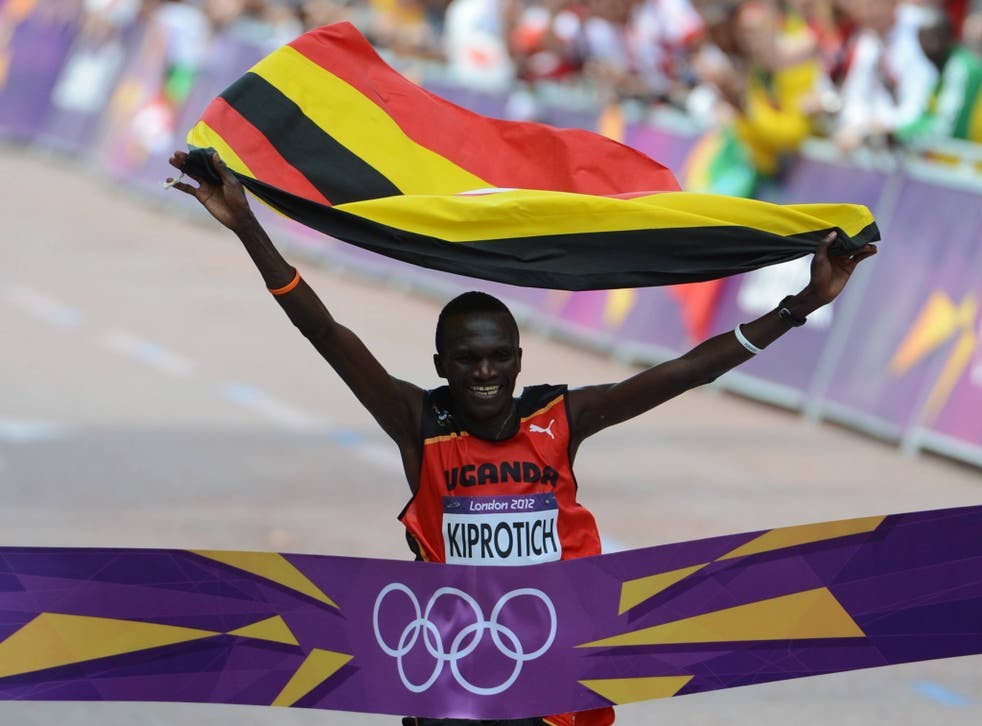
However, Kiprotich was still fourth in terms of best time behind Chemonges, Musobo and Solomon Mutai before Covid-19 pandemic. But UAF chose the 2013 world marathon champion thanks to a respectable show where he finished fifth with 2:09:04 at the NN Mission Marathon in Enschede, Netherlands on April 18.
“There was a comparison of performances before and after (the pandemic),” explained UAF’s secretary general Beatrice Ayikoru.
Before Covid-19, Chemonges had produced a national record of 2:05:12 in third place at the Toronto Marathon in Canada on October 20, 2019. Musobo, too, had a personal best of 2:06:56 in second place at the Daegu Marathon in South Korea on April 7, 2019.
On the same day, Mutai posted a PB as well, in third place at the Vienna Marathon in Austria yet Kiprotich’s best time was 2:08:31 at the Hamburg Marathon in Germany on April 28, 2019.“We had made it clear that those who qualified in 2019, we could not start selecting the team with 2019 qualification,” Kiwa said.
“We made it clear to all of them that they had to run afresh. So we used that for selecting. 2019 is long past, you can’t tell if one is still fit or not,” he added.
Post-pandemic, Kiprotich delivered a controlled race in Enschede ahead of compatriots Geoffrey Kusuro (2:09:53) and Chemonges (2:09:59), who finished sixth and eighth, respectively.
A week before Enschede, Mutai was undone by a stitch after 33km but Musobo braved the cold to post 2:08:04 in Siena, Italy.Kiprotich will become the first Ugandan to compete at three successive Olympic editions but his inclusion also means that 2015 world bronze medalist Mutai will miss a seventh straight 42km championship race.
(05/04/2021) ⚡AMPby Allan Darren Kyeyune
Tokyo 2020 Olympic Games
Fifty-six years after having organized the Olympic Games, the Japanese capital will be hosting a Summer edition for the second time, originally scheduled from July 24 to August 9, 2020, the games were postponed due to coronavirus outbreak, the postponed Tokyo Olympics will be held from July 23 to August 8 in 2021, according to the International Olympic Committee decision. ...
more...One of the fastest players in football star DK Metcalf eyes U.S. Olympic Trials with 100m race in California
NFL wide receiver DK Metcalf will race the 100m at Sunday’s USATF Golden Games and Distance Open at Mt. SAC in Walnut, Calif. Metcalf, who plays for the Seattle Seahawks, is currently one of the fastest players in the NFL, and although he has not released any info or statements on the race, many believe he has his eyes on a qualifying time for the U.S. Olympic Trials. Metcalf reportedly competed as a hurdler in high school, but, now 23, he hasn’t raced on the track in years.
To earn a spot on the 100m start line at the U.S. Trials, Metcalf will have to run the qualifying standard of 10.05 seconds. For context, only 104 men in U.S. history have run that fast (or faster) over 100m. That may sound like a lot, but consider the fact that the World Athletics all-time American 100m rankings features thousands of runners, all of whom have run at least 10.55 seconds (which was the minimum time required to make this list). Of the thousands of men listed and even more who didn’t even break 10.55, only about 100 have hit the Olympic standard of 10.05.
To be fair, Metcalf is certainly fast. In a game last October versus the Arizona Cardinals, he chased down a runaway opponent, making a tackle after sprinting just under 115 yards (about 105m) and preventing what in most cases would have been an unstoppable touchdown.

On this play, Metcalf reached a max speed of 36.4 kilometres per hour. If he could run 36.4 kilometres per hour for a full 100m, he would be well on his way to a career in sprinting, as this would work out to a 9.88 finish. To hit Olympic standard, he will have to average 35.8 kilometers per hour over the course of the full 100m. The thing is, Metcalf didn’t average that speed in his full-field chase-down last fall, he merely reached that speed. It doesn’t make his accomplishment any less impressive (few people can run that quickly), but it does suggest that he won’t hit standard on Sunday.

meterIf it takes him that long to hit that pace in a race, the rest of the field will be well ahead of him by the halfway mark of the sprint. It’s also important to note that Metcalf started his sprint while on his feet and already moving, but on Sunday he and his competitors will be at rest on blocks at the start of the race. Metcalf has likely been practicing his race starts in preparation for this event, but he will be racing athletes much more comfortable with this technique.
We’re sorry to upset any NFL fans who really think Metcalf has what it takes to run 10.05 seconds (and we’re also sorry to Metcalf if he isn’t aiming to run Olympic standard and is instead just looking to have some fun on the track). Maybe he has been training hard for months and will manage to run well. After all, he’s a phenomenal athlete and one of the best sprinters in football. Numbers don’t lie, though, and based on the stats we can find, it shouldn’t be a surprise if he doesn’t run an earth-shattering time on Sunday.
(05/04/2021) ⚡AMPby Ben Snider-McGrath
Canada´s Aaron Brown not worried about relay team’s Olympic chances
The Olympic bronze medalist liked what he saw in Louisana last weekend, and believes the team will be competitive.
Last weekend Athletics Canada made the unfortunate announcement that they’d decided to withdraw the Canadian team from the World Athletics Relays taking place in Poland this weekend. The decision was made in light of the COVID-19 situation around the world. Most of the athletes supported AC’s decision, and 2016 Olympian Aaron Brown told the CBC he isn’t worried about his relay team’s chances of making Canada’s Olympic roster.
Brown was a member of the 4x100m team that won the bronze medal at the 2016 Olympics in Rio. So far, however, the only Canadian team that has already qualified for the Olympics is the women’s 4x400m squad, after their eighth-place finish at the World Championships in Doha in 2019. Brown’s 4x100m team with Gavin Smellie, Brendon Rodney and Andre De Grasse finished sixth in their heat and missed out on qualifying for the final by five 1000ths of a second. This means they have yet to qualify for the Games, and the World Relays would have been their best opportunity to do so.

Currently, the men’s 4x100m relay team is sitting in ninth in the world rankings, but after a solid performance in Louisiana last weekend, Brown told the CBC he feels confident his team will make it to Tokyo. The team last weekend consisted of Brown, Bismark Boateng, Jerome Blake, and EJ Floreal.
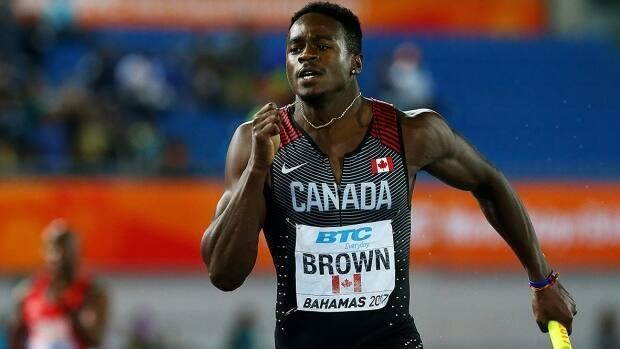
“To go 38.49 at this time of the season with people at different legs is encouraging,” Brown said.
He added that though it’s tough to say how the team would have done in Poland, he believes they would have been competitive with this squad. Without the WA Relays, the team won’t be competing for another month, and Brown is hopeful they’ll be able to run at a meet early in the Diamond League season, which begins on May 23 in Gateshead, England.
(05/04/2021) ⚡AMPby Brittany Hambleton
Dave McGillivray shares his expertise as Massachusetts brings back road races
As Massachusetts approaches the resumption of road races, a longtime race director for the Boston Marathon says there's a lot for organizers and health officials to consider.
Gov. Charlie Baker announced last week that road races and other large, outdoor organized amateur or professional group athletic events will be permitted to take place starting on May 10. Requirements include staggered starts and the submission of safety plans to a local board of health or the DPH.
Dave McGillivray, who has been race director of the Boston Marathon for the past 34 years, says planning will need to be a cooperative, local effort.

"Instead of just making a blanket policy for everyone, that each individual community assesses for themselves their tolerance for something like this," he said.

Organizers and communities need to decide on the proper size of the event and who may be eligible to take part.
For example, McGillivray said, "Do you want runners coming in from outside of the state, from outside of New England, from outside of the country?"
He says race organizers will be trying to strike a balance between the appropriate space, time and budget for their event.
"Nothing can be more important now, given the virus situation and the mitigation process, than space and time," McGillivray said.
For its part, the Boston Marathon was postponed until Oct. 11, and the field will be limited to about 20,000. That's reduced from the 30,000 entrants allowed to race in 2019.
During the pandemic, McGillivray and his business were hired by CIC Health to run logistics for COVID-19 mass vaccination sites.
(05/04/2021) ⚡AMPby Doug Meehan
Boston Marathon
Among the nation’s oldest athletic clubs, the B.A.A. was established in 1887, and, in 1896, more than half of the U.S. Olympic Team at the first modern games was composed of B.A.A. club members. The Olympic Games provided the inspiration for the first Boston Marathon, which culminated the B.A.A. Games on April 19, 1897. John J. McDermott emerged from a...
more...Lincoln Marathon and Half Marathon was a success
Thousands of people, some from across the world, flocked to Lincoln on Sunday for the 44th annual Lincoln Marathon and Half Marathon.
The race went on in-person this year after it went virtual due to COVID in 2019, making this event extra special.
"Today is outstanding," Ryan Regnier, the Marathon Director said. "I just think the community, the runners, the city, we just needed this event."
The Lincoln Marathon and Half Marathon was one of only a handful of other races that are happening this year despite the pandemic. Because of that, this event grabbed international attention.
Dominic Korir, who won 1st place in the Half Marathon, and Iveen Chepkemoi, the female 1st place Half Marathon winner, made the trip to Lincoln all the way from Kenya. Alex Ekesa, the male winner of the Marathon, also traveled all the way from Kenya, while Lincoln native Amy Dulng was the first female to cross the finish line in the Marathon.
"Feels good to win it, I grew up here, so it's exciting to be able to win it today," Dulng said.
But not everyone there was running because it's their passion. For Chris Maxwell of South Dakota, this race meant much more.
"Two years ago I was laying in Madonna Rehab Hospital completely paralyzed, having my wife and mom have to blink for me," Maxwell said. "I had a friend come down and they were going to run this race and they encouraged me and I encouraged them and about three months ago I said, what the heck, lets do a victory lap."
Maxwell was diagnosed with Gullain-Barre Syndrome several years ago, fighting for his life. But now, a miracle, Maxwell ran the Half Marathon Sunday with the biggest smile on his face.
(05/03/2021) ⚡AMPLincoln Marathon
The Lincoln National Guard Marathon and Half-Marathon is run on a citywide course that starts and finishes on the campus of the University of Nebraska-Lincoln. Runners in both races share a common start and run a loop route past the Nebraska State Capitol, along Sheridan Boulevard, past Union College, along the Highway 2 bike path, past the Lincoln County-City Building...
more...Remedies to common joint and muscles ailments
People can only ever be happy when they are healthy. Amongst the most common issues that affect people’s well being and, in turn, their happiness, are joint and muscle pains. The aches that people feel in their muscles and joints can vary in severity depending on their main cause and on each person’s overall health conditions. Once you start feeling pain in your muscles or joints, it is important that you take quick action to try and get yourself treated and relieved from all the pain. Here are some interesting remedies that can help you get rid of the common joint and muscle ailments you may have been experiencing, once and for all.
Hot and Cold Packs
When your joints and muscles start aching, all you would be thinking about is how to stop the pain, especially if it gets too severe as a result of previous injuries. One of the quickest home remedies you can resort to in such cases is hot and cold packs. All you need to do is warm up the pack or place it in the freezer for a little while, depending on your injury, then place the pack over the affected area. You should alternate between hot and cold treatments so that you can get more effective long-term relief. Hot and cold packs work pretty quickly, and you should start feeling the difference after a couple of minutes of using them on the muscles or joints that hurt.

Magnetic Bracelets
Those who struggle with muscle and joint pain often want a quick relief that can have strong long-term effects. Nowadays, many patients have been using magnetic bracelets for their quick and effective powers when it comes to treating common joint and muscle issues like arthritis or joint injuries. All you need to do is wear your arthritis bracelet around your arm wherever you go and relax as the pain will start fading away bit by bit. The magnetic bracelets can be a great remedy for those who are trying to avoid the constant consumption of painkillers, yet need effective results.
Compression Bandages
The pain that results from muscle or joint ailments can often leave the patients suffering from swelling around the areas affected which can cause even more pain. An effective way to treat that swelling and reduce the pain a little is by using compression bandages and wrapping them around the painful areas. You may need to consult with your physician before taking this step because if you have any blood circulation problems, you would end up harming yourself even more. Make sure you use the compression bandages for only a set period of time and keep your doctor updated so that you can get relief without harming your muscles any further.
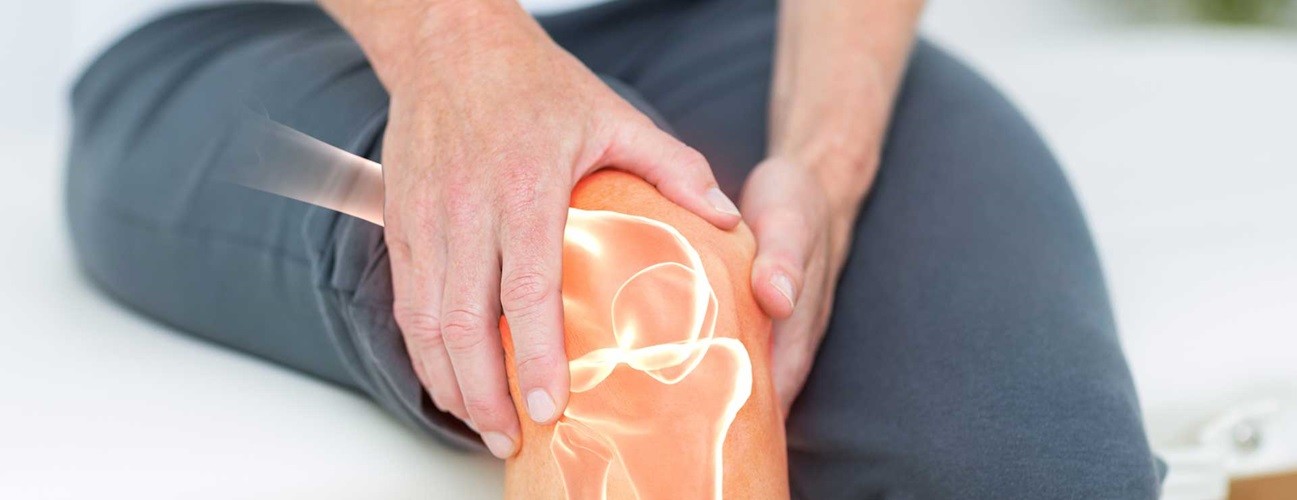
Moderate Exercise
Many people tend to avoid getting active altogether when they start feeling the slightest pain in their joints or muscles. However, sometimes moderate exercises can prove to be helpful in such cases as they get the blood flowing in the affected areas and help them recover quickly. The key is consulting with your physician before getting too active just so you know how moderate your exercises should be which allows your muscles to heal without getting harmed. If you are not sure where to start with your training, it can be a good idea to find a personal trainer to work with you on finding a suitable exercise routine for your specific case.
Health Supplements
Sometimes the main cause of muscle and joint problems is lack of good nutrition and essential vitamins in the body. If that is the case for you, then it can be a good idea to try consuming more health supplements to boost your overall well-being and treat your ailments. Most essential health supplements can be found on sale in supermarkets and over the counter at most drug stores, so you should not face any issues when it comes to getting the nutrients you need. If you are taking any other medications, make sure you check with your doctor to see what dosage would be best for you so that you get the full benefits of the supplements.
Suffering from joint or muscle problems can be quite challenging, especially if the cause of your pain is an injury or a result of old age. The best way to treat such ailments is by following your doctor’s orders and getting the necessary nutrients and staying moderately active so that your body can heal properly. Try to stick to a routine with your home remedies so that you notice effective results quickly and get rid of the pain once and for all.
(05/03/2021) ⚡AMPby Colorado Runner
American ultrarunner Taggart VanEtten smashes 100-mile treadmill world record with 11:32:05 run
American ultrarunner Taggart VanEtten crushed the 100-mile (160K) treadmill world record on Saturday, running a mind-boggling 11:32:05 at an event in Morton, Ill. VanEtten’s run lowered the previous world record significantly, shaving 37 whole minutes off the 12:09:15 result that Zach Bitter set last May. His result works out to an incredible average pace of 4:18 per kilometer.
It has been a tough couple of weeks for Bitter’s resume, as he has had his name erased from three ultrarunning world records in that time. First, Lithuania’s Aleksandr Sorokin beat Bitter’s 100-mile and 12-hour world records at an event in the U.K., lowering the two results to 11:14:56 and 170.309K, and now VanEtten has beaten Bitter’s 100-mile treadmill best.
When Bitter set the 100-mile treadmill world record last year (beating Canadian Dave Proctor‘s record of 12:32:26), it was hard to imagine anyone running faster. He averaged 4:32 per kilometre over the course of 12 hours, and it seemed unlikely that someone else would come even close to that (or want to spend that long on a treadmill) for a while. Just under one year later, though, VanEtten decided to give the record a shot, and he produced an even more amazing result.

VanEtten announced his plans to run the treadmill 100-miler in January, writing about the record attempt on Instagram. “For years now I have been anti-treadmill,” he wrote. “However, for the sake of longevity in my running career I must utilize one for regular use.” At the time, he said he hoped to run under 12 hours — a goal that he ultimately shattered.
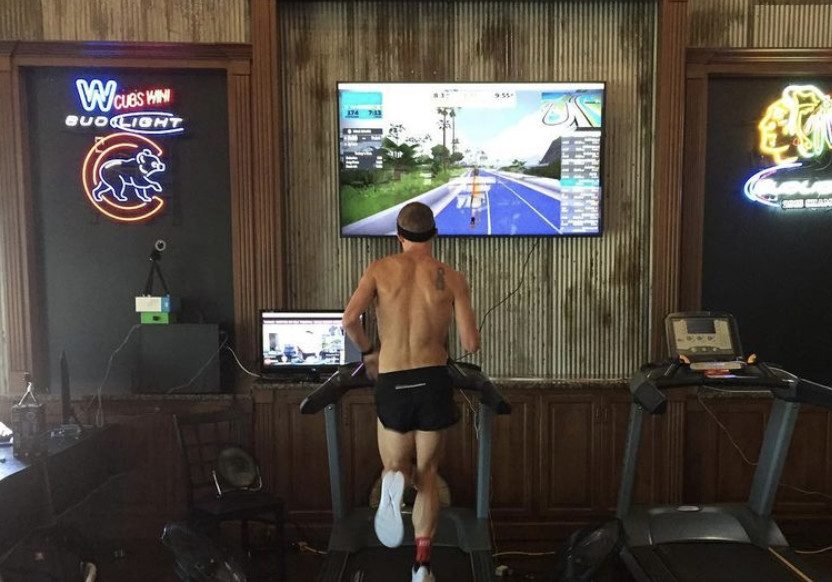
Running on a treadmill in a pub in Morton and keeping track of his progress on Zwift, VanEtten ran an impressively steady pace throughout. For the most part, he hovered between 4:10 and 4:20 per kilometre, and he never ran a kilometre slower than 4:58.
At 116K into the run, he posted one of his slowest kilometres of the day at 4:36, but he immediately made up for it by running 10K at sub-4:10 pace, including three sub-four-minute kilometres. His slowest kilometre of the day came at the 139K mark, but he regained his composure and remained steady in the 4:20s for the rest of the run. For context, his average speed of 4:18 per kilometre works out to a 43-minute 10K. Many people would be happy to run one 10K this quickly, but VanEtten ran 16 in a row at this pace.
To make the feat even more impressive, this record attempt was only VanEtten’s second official ultramarathon event. His first came in November 2020, when he won the Tunnel Hill 100-miler in Illinois. Despite the fact that it was his first ultramarathon ever, VanEtten not only won the race, but he posted the second-fastest result in the event’s history. His 12:19:55 finish was only 11 minutes slower than none other than Bitter, who owns the Tunnel Hill 100 record of 12:08:36.
VanEtten’s still a rookie when it comes to ultrarunning, but based on his two results so far in the sport, it’s safe to say his name is one that fans will get used to hearing in the coming years.
(05/03/2021) ⚡AMPby Ben Snider-McGrath
After about a day of running, medical concerns force Dave Proctor to stop short of TransAlberta FKT
Mid-run medical concerns have forced Dave Proctor to call off his TransAlberta FKT (fastest known time) attempt. Around a day into what he hoped would be a 72-hour run across Alberta, Proctor decided it was in his best interest to get picked up and receive medical attention. He was taken to Foothills Medical Center in Calgary on Saturday, and after a round of tests, he has returned home.
Before his run, Proctor said he hoped to complete the 537K TransAlberta FKT in 72 hours or less. This would set two records, as it would be the fastest run across Proctor’s home province of Alberta and it would better his own Canadian 72-hour record, which currently sits at 500K. Pushing a stroller that contained all of his gear, food and water, Proctor set out on the Trans-Canada Highway on Friday morning, kicking the challenge off at the B.C.-Alberta border.

Proctor’s goal for the opening 100 miles of the FKT attempt was to run somewhere between 14 and 16 hours. He hit that with time to spare, passing through 100 miles in 15 hours, 30 minutes. He then continued on through Calgary and powered toward the remaining two thirds of the run. Unfortunately, Proctor didn’t get much farther, and when things didn’t feel right on the other side of Calgary, he decided to call for a ride to take him to the hospital.
Posting on Proctor’s behalf on Instagram, Stephanie Gillis-Paulgaard of Take Roots Consulting wrote, “Dave had to make a very tough call to end his TransAlberta run. He had some concerns and is now being cared for by our amazing healthcare workers. Of course there is disappointment but he’s happy with his effort.”
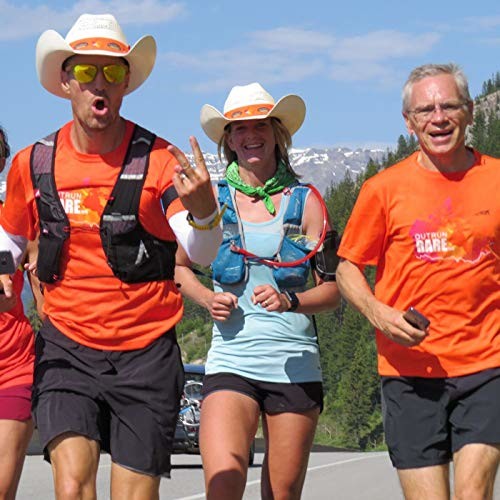
Before his run, Proctor said all he had in his mind as a set goal was to hit the first 100 miles between 14 and 16 hours. After that, he said, it was impossible to know how his body would react to the run. He averaged about 5:47 per-kilometer pace for the opening 100 miles, and he decided that carrying on for another 200 wouldn’t have ended well.
“These decisions are never easy to make,” Gillis-Paulgaard said after Proctor returned home. “When you have concerns — any concerns — you leave it to the professionals.” Gillis-Paulgaard noted that Proctor’s tests at the hospital came back normal, but he’s at peace with the decision he made on the route.
“The reality of completing the TransAlberta in the intended timeframe was not in the cards,” she said. “For now, Dave will rest and assess.”
(05/03/2021) ⚡AMPby Ben Snider-McGrath
About six foreign athletes will participate in Olympic marathon test event in Sapporo
Six overseas athletes who have booked their spots in this summer’s Tokyo Olympic marathon will take part in the half-marathon race of the upcoming Sapporo Marathon Festival, the event’s organizers said Sunday.
Bart van Nunen of the Netherlands will run in the men’s race while Germany’s Katharina Steinruck will take part in the women’s event. They are among the six already in Sapporo to run in Wednesday’s Tokyo Olympic test event.
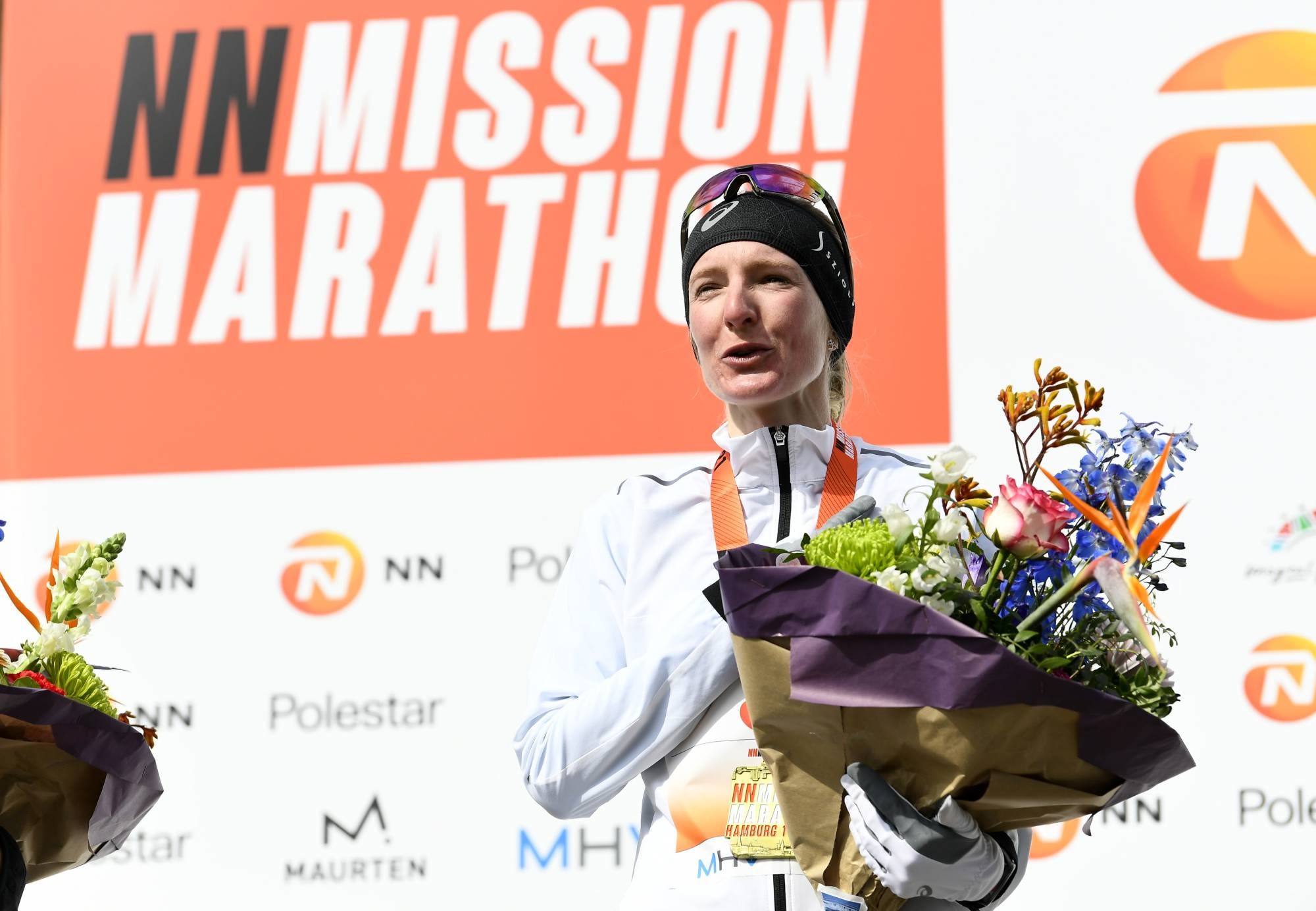
The organizers revealed the guidelines for virus countermeasures, which include daily coronavirus testing for athletes.

The event originally included races for the general public, but those have been cancelled, while the public has been asked to refrain from cheering runners from the roadside.
Honami Maeda, who will represent Japan in this summer’s Tokyo Olympic women’s marathon, will also run on Wednesday.
(05/03/2021) ⚡AMPby The Japan Times
Tokyo 2020 Olympic Games
Fifty-six years after having organized the Olympic Games, the Japanese capital will be hosting a Summer edition for the second time, originally scheduled from July 24 to August 9, 2020, the games were postponed due to coronavirus outbreak, the postponed Tokyo Olympics will be held from July 23 to August 8 in 2021, according to the International Olympic Committee decision. ...
more...Fitness tips for dedicated runners
Sometimes, running is about winning a marathon or being fast. For some runners who run every week, it can become a little bit of a chore that their main goal is to make their runs more tolerable instead of faster. Their goal is to increase their fitness and passion for the sport, not just to finish first. While it’s not the hardest exercise out there, running can be a little difficult if you don’t take care of a few essential factors that go a long way. This includes following a healthy diet, waking up early, taking breaks, and most importantly, listening to your body. After all, your goal should be to improve your overall health and increase your fitness. Maybe lose a few pounds along the way. If you’re really dedicated to your goals and want to enjoy every minute of your daily running routine, we’ve got something for you. Here are some of the best tips that will help you achieve your running goals and keep you motivated throughout your exercises.
Run Early in the Morning
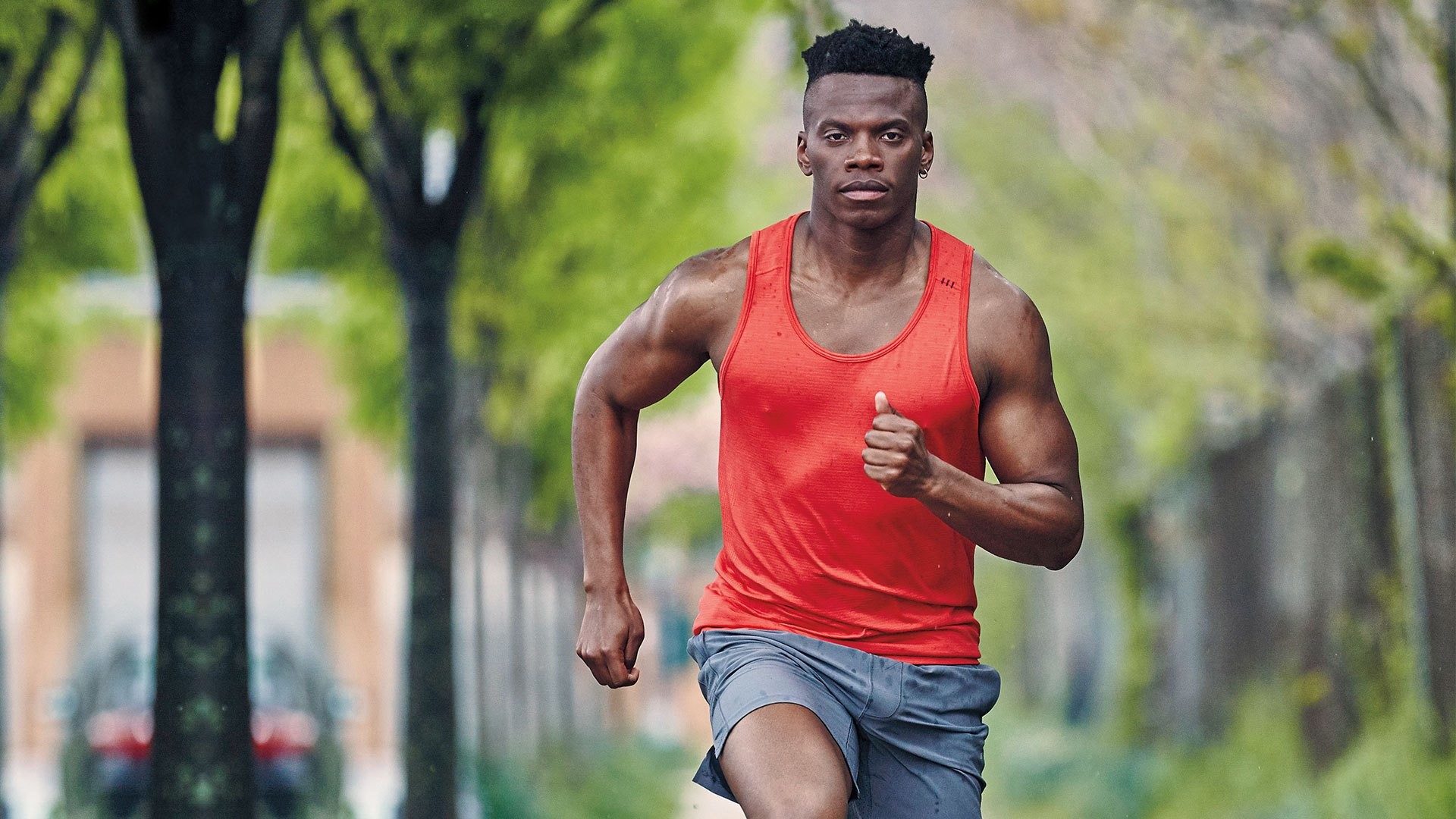
This one may be easier said than done but accomplishing your running goals in the morning before breakfast can have a huge impact on your mood. Imagine getting that chore out of the way and still having the rest of the day to do anything else you want. You won’t have to worry about your workout all day, neither will you worry about the last meal you ate before your run. Getting up early in the morning may be difficult, but it’s worth it when you discover all the benefits of running at the break of dawn.
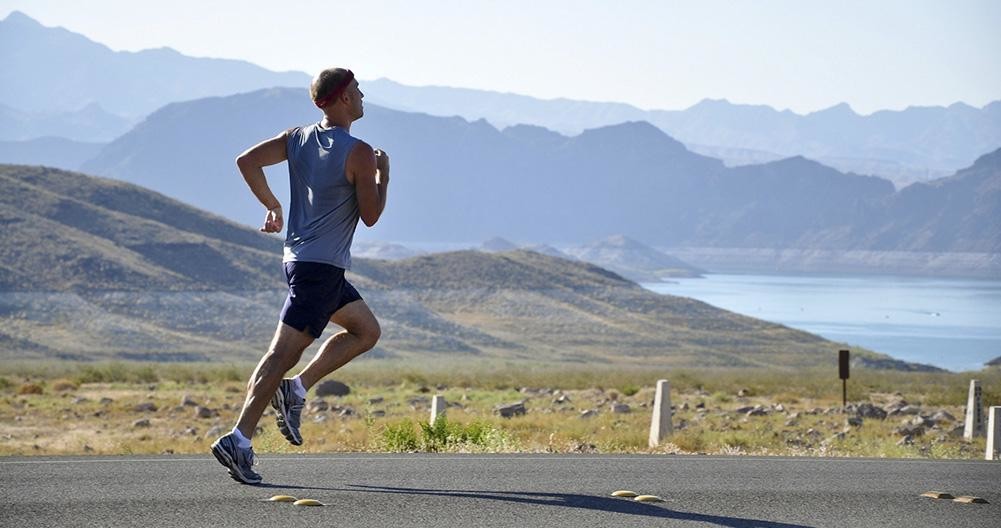
Learn to Do Negative Splits
Negative splits is a technique applied by most runners to save energy and maintain their speed until the end of their races or runs. While it can be simple to explain, it takes a lot of time and practice to master. This long-distance running technique focuses on conserving energy and running at a slightly slower pace for the first half of the run so that the body can feel well enough to run at high speeds for the second half. This eliminates fatigue and helps runners gain more focus during their runs. Start adding negative splits to your next run, and you’ll be seeing amazing results in no time.
Take Care of Hydration and Nutrition
Drinking enough water throughout your day and consuming foods that are high on carbohydrates is the key to continuously providing your body with the energy it needs for the longest runs. You can try oatmeal which is one of the best food for runners as it contains a lot of carbs and protein and is easy on the stomach, so you can increase your portions without worrying about feeling full during your runs. Nutritionists at thesupplementreviews.org/best-greens-powder/best-greens-powders suggest that the carb intake and requirements for runners vary based on how long they run. They recommend trying different portions and experimenting to find out the suitable carb portion for every runner.
Refuel in the Middle of Your Runs
It’s recommended to take on a few calories in the middle of your runs if you are running for more than an hour to help your body maintain its energy. You can stop in the middle to add some calories through powders, gels, chews, or even dried fruit and nuts. However, what works for other runners’ stomachs may not work for yours, so you’ll need to keep experimenting with different foods until you find your go-to food that doesn’t upset your stomach as you keep running. Water is also as important, you should aim to keep a bottle or a hydration backpack with you so that you can refuel on water every 20 minutes. While the recommended duration is 40 minutes before you take on any calories during running, and 20 minutes for hydration, you should experiment at your own pace and practice how you’re going to refuel in the middle of your runs.
Post-Run Recovery Is Important
A good recovery plan goes a long way in helping your body recover faster and preparing you for your next run. This is why you should make sure to eat a post-workout meal to provide your body with the needed nutrition. This meal should be rich in proteins, carbs, and fats. You may also want to include electrolytes if you’ve worked up a good sweat during your run. This can be done by consuming non-alcoholic beer or adding some salt to your post-run meal.
Running is a great exercise for increasing fitness, but it can be a little difficult to stay motivated and commit to a running routine. Especially for runners who practice this exercise daily. These tips will help you enjoy every minute of your runs as well as improve your health and keep your body prepared for long strenuous runs.
(05/03/2021) ⚡AMPby Colorado Runner
Thousands of people, some from across the world, flocked to Lincoln on Sunday for the 44th annual Lincoln Marathon and Half Marathon.
The race went on in-person this year after it went virtual due to COVID in 2019, making this event extra special.
“Today is outstanding,†Ryan Regnier, the Marathon Director said. “I just think the community, the runners, the city, we just needed this event.â€
The Lincoln Marathon and Half Marathon was one of only a handful of other races that are happening this year despite the pandemic. Because of that, this event grabbed international attention.
Dominic Korir, who won 1st place in the Half Marathon, and Iveen Chepkemoi, the female 1st place Half Marathon winner, made the trip to Lincoln all the way from Kenya. Alex Ekesa, the male winner of the Marathon, also traveled all the way from Kenya, while Lincoln native Amy Dulng was the first female to cross the finish line in the Marathon.
“Feels good to win it, I grew up here, so it’s exciting to be able to win it today,†Dulng said.
But not everyone there was running because it’s their passion. For Chris Maxwell of South Dakota, this race meant much more.
“Two years ago I was laying in Madonna Rehab Hospital completely paralyzed, having my wife and mom have to blink for me,†Maxwell said. “I had a friend come down and they were going to run this race and they encouraged me and I encouraged them and about three months ago I said, what the heck, lets do a victory lap.â€
Maxwell was diagnosed with Gullain-Barre Syndrome several years ago, fighting for his life. But now, a miracle, Maxwell ran the Half Marathon Sunday with the biggest smile on his face.
(05/03/2021) ⚡AMPThe 44th annual Lincoln marathon and half in-person races were a success
Thousands of people, some from across the world, flocked to Lincoln on Sunday for the 44th annual Lincoln Marathon and Half Marathon.
The race went on in-person this year after it went virtual due to COVID in 2019, making this event extra special.
“Today is outstanding,†Ryan Regnier, the Marathon Director said. “I just think the community, the runners, the city, we just needed this event.â€
The Lincoln Marathon and Half Marathon was one of only a handful of other races that are happening this year despite the pandemic. Because of that, this event grabbed international attention.
Dominic Korir, who won 1st place in the Half Marathon, and Iveen Chepkemoi, the female 1st place Half Marathon winner, made the trip to Lincoln all the way from Kenya. Alex Ekesa, the male winner of the Marathon, also traveled all the way from Kenya, while Lincoln native Amy Dulng was the first female to cross the finish line in the Marathon.
“Feels good to win it, I grew up here, so it’s exciting to be able to win it today,†Dulng said.
But not everyone there was running because it’s their passion. For Chris Maxwell of South Dakota, this race meant much more.
“Two years ago I was laying in Madonna Rehab Hospital completely paralyzed, having my wife and mom have to blink for me,†Maxwell said. “I had a friend come down and they were going to run this race and they encouraged me and I encouraged them and about three months ago I said, what the heck, lets do a victory lap.â€
Maxwell was diagnosed with Gullain-Barre Syndrome several years ago, fighting for his life. But now, a miracle, Maxwell ran the Half Marathon Sunday with the biggest smile on his face.
(05/03/2021) ⚡AMPEndurance Athletes Have an Increased Risk for Iron Deficiency
Poor performances and feelings of fatigue may signal a need to get your levels checked.
It’s common to associate a poor performance with low iron. “I had a bad race, maybe I should check my iron?” “I’m feeling fatigued during workouts—could it be my iron levels?” I get these questions from the athletes I work with a lot.
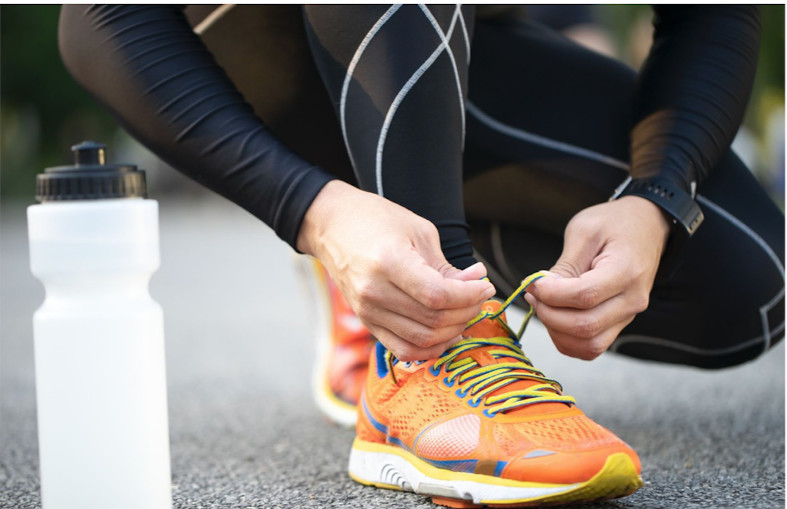
And while there are countless variables that can contribute to poor performances or fatigue, one thing we do know is that iron is important for runners. If your iron levels are low and you don’t do anything about it, you will eventually feel the negative impact on performance. Here’s what you need to know about both iron and ferritin levels.
What is iron and why is it important for athletes?
Iron is an essential mineral found in red blood cells that is important for oxygen transport in the blood and to muscles, energy production, cognition, and immunity. The reason many of us worry about our levels is that iron is lost in many ways: in the urine, through the menstrual cycle, blood loss in the gastrointestinal (GI) tract, sweat loss, and the breakdown of red blood cells via the impact of our foot strikes. Plus, chronic use of nonsteroidal anti-inflammatory drugs (e.g. ibuprofen, naproxen)—ones often used by athletes—and antacids can also lead to iron deficiency. 
​
Iron levels are especially important for female athletes: According to a paper in the European Journal of Applied Physiology, the prevalence of iron deficiency is around 15 to 35 percent in female athletes and 3 to 11 percent in males. Females, endurance runners, vegans, vegetarians, and athletes with low energy availability are at an increased risk for iron deficiency.

What are some key symptoms of low iron?

The classic signs of iron deficiency, with or without anemia, include lethargy, fatigue, negative mood state, and difficulty concentrating. However, runners may notice symptoms that mimic overtraining, reduced work capacity during training, impaired responses to training, and ultimately poor performance. The only way to determine if low iron is the culprit is to have a blood test.
What about anemia?
Anemia is a condition in which the blood doesn’t have enough healthy red blood cells. Although iron deficiency anemia is the most common type of anemia, it is one of many different types. It is possible to have iron deficiency prior to developing a diagnosis of iron deficiency anemia. Over time, iron deficiency will lead to anemia if no action is taken because the body will exhaust its iron stores, known as ferritin.
So what’s the deal with ferritin levels?
Ferritin, as mentioned above, is an important blood marker that indicates iron storage. There is a wide range for what is considered to be a “normal ferritin level,” ranging from 12 to 300 nanograms per milliliter (ng/mL).
“However, linking ferritin levels (e.g. levels greater than 35ng/ml) directly to performance is very challenging, as there are so many things that impact performance,” Trent Stellingwerff, PhD, Senior Advisor for the Canadian Sport Institute Pacific tells Runner’s World.
In fact, high iron levels can be very toxic for the liver and heart. “We aim for ferritin greater than 35ng/ml and clinically normal hemoglobin, but appreciate individual athlete norms as well,” says Stellingwerff.
Thus, a current routine assessment of iron deficiency should include the following blood markers: ferritin, hemoglobin, and transferrin saturation. Iron deficiency occurs in three stages using the following ferritin levels proposed in a recent paper in athletes:
Stage1 - Iron deficiency/depletion: ferritin less than 35 ng/mL, hemoglobin and transferrin levels will still be normal. There is little evidence to suggest you will notice any fatigue at this point, but it’s important to correct and prevent iron deficiency anemia.
Stage 2 - Iron deficient non-anemia: ferritin less than 20ng/mL, low transferrin, and normal hemoglobin. You may start to feel some of the symptoms above and performance may be negatively impacted.
Stage 3 - Iron deficiency anemia: ferritin less than 12 ng/mL, low transferrin and hemoglobin. You will notice key symptoms above including impaired endurance performance.
How often should I have my iron levels checked?
As suggested in a recent 2019 article published in a European Journal of Applied Physiology, high-risk runners should be screened regularly and considerations for the frequency of iron blood screening are based on the athlete’s past history. Although not comprehensive, some guidelines are listed below:
Annually: runners with no history of iron deficiency, no fatigue after an extended rest period
Biannually: previous history or low ferritin (iron depletion stage 1), female, intention to increase training volume or training at altitude within the next 12 months
Quarterly: any recent history of iron depletion/deficiency, vegetarian/vegan, individuals with any evidence of low energy availability, high training volume, and fatigue/lethargy, plans to train at altitude within the next 6 months.
Ferritin, an acute phase reactant protein, can be falsely elevated with inflammation after intense exercise. Thus, it’s important to avoid any muscle-damaging or intense exercise about two to three days prior to your routine blood test. Other suggestions for standardization include testing first thing in the morning and in a well-hydrated state.
Work with your doctor to determine the best course of action and figure out if supplementation is right for you.
Should runners traveling to altitude be concerned about levels?
Training at low to moderate altitudes provides an environmental stimulus to increase red blood cells with the goal of improving performance at sea level. With this increase in red blood cell production, comes an additional need for iron. A review paper by Stellingwerff et al. (2019) suggests checking iron status prior to altitude training to ensure that levels are in the optimal range prior to leaving.
“However, if a runner is just going to altitude for a race or short period of time, the impact of iron is much less,” Stellingwerff says. “Although, all endurance athletes should aim to have ferritin levels well into the healthy and normal range.”
How can runners optimize iron absorption?
You can have a solid iron-rich fueling plan, but is your nutrient-timing and combination of foods on point? Iron absorption may be impaired post-exercise due to increased levels of hepcidin, a hormone released by the liver that regulates the ability to absorb or recycle iron (e.g. increased hepcidin levels will inhibit iron absorption).
Inflammation is believed to be a strong up regulator of hepcidin. According to an article published in Sports Medicine in 2020, hepcidin increases around three to six hours post-exercise and increases towards the end of the day.

Thus, the optimal timing for iron absorption is within 30 minutes after a morning workout when hepcidin levels are low. Runners can optimize iron absorption use the following strategies:
​
Avoid dairy, coffee, and tea (which decrease absorption of iron) for an hour before or after a meal.
Cook with a cast-iron skillet or a product like a Lucky Iron Fish, which may be a cost-effective strategy for increasing the iron in conjunction with other methods according to one study.
Consume “heme iron” rich foods such as beef, eggs, tuna, lamb, and kangaroo (if available)
Improve absorption of “non-heme iron” sources (almonds, figs, apricots, kidney beans, green leafy vegetables, tofu, dark chocolate) by pairing with heme-rich sources and/or ~50 milligrams (mg) of vitamin C (1/2 cup of pineapple, strawberries, broccoli, or red peppers).
If taking an iron supplement (prescribed by a physician), take with vitamin C-rich food. Emerging evidence suggests alternate day dosing to be just as effective as daily for raising ferritin levels and better tolerated for runners with a sensitive gut.

Finally, not every bad race indicates your iron is low, but it is a good idea to get checked prior to taking any iron supplements. There is no evidence that higher ferritin levels are better (e.g. aiming for 300), and supplementation is not likely to improve performance in non-depleted runners. Iron supplementation should only occur under physician supervision.
You can have a solid iron-rich fueling plan, but is your nutrient-timing and combination of foods on point? Iron absorption may be impaired post-exercise due to increased levels of hepcidin, a hormone released by the liver that regulates the ability to absorb or recycle iron (e.g. increased hepcidin levels will inhibit iron absorption).
Inflammation is believed to be a strong up regulator of hepcidin. According to an article published in Sports Medicine in 2020, hepcidin increases around three to six hours post-exercise and increases towards the end of the day.

Thus, the optimal timing for iron absorption is within 30 minutes after a morning workout when hepcidin levels are low. Runners can optimize iron absorption use the following strategies:
​
Avoid dairy, coffee, and tea (which decrease absorption of iron) for an hour before or after a meal.
Cook with a cast-iron skillet or a product like a Lucky Iron Fish, which may be a cost-effective strategy for increasing the iron in conjunction with other methods according to one study.
Consume “heme iron” rich foods such as beef, eggs, tuna, lamb, and kangaroo (if available)
Improve absorption of “non-heme iron” sources (almonds, figs, apricots, kidney beans, green leafy vegetables, tofu, dark chocolate) by pairing with heme-rich sources and/or ~50 milligrams (mg) of vitamin C (1/2 cup of pineapple, strawberries, broccoli, or red peppers).
If taking an iron supplement (prescribed by a physician), take with vitamin C-rich food. Emerging evidence suggests alternate day dosing to be just as effective as daily for raising ferritin levels and better tolerated for runners with a sensitive gut.

Finally, not every bad race indicates your iron is low, but it is a good idea to get checked prior to taking any iron supplements. There is no evidence that higher ferritin levels are better (e.g. aiming for 300), and supplementation is not likely to improve performance in non-depleted runners. Iron supplementation should only occur under physician supervision.
(05/02/2021) ⚡AMPby Runner’s World
Ultrarunner Candice Burt saves man from burning car
Early on the morning of April 17, American ultrarunner Candice Burt happened upon a brutal one-car accident on the side of a road near Soap Lake, Wash. Jumping into action, Burt called 911 and rushed to the wreck, where she found an unconscious man still inside the burning car. Burt managed to work the man free from his vehicle before help arrived, saving his life before rescue workers arrived on scene.
Burt, the winner of many ultramarathons across the U.S., posted about the incident on Instagram, writing that she was on her way home from Arizona when she saw the crash. She had been in Arizona for an FKT (fastest known time) attempt on the 1,200-kilometre Arizona Trail. Burt was forced to abandon her self-supported run due to a dental abscess, calling off the record attempt after just a few days of running. “Disappointing, yes,” she wrote on Instagram, “but I didn’t have much of a choice.”

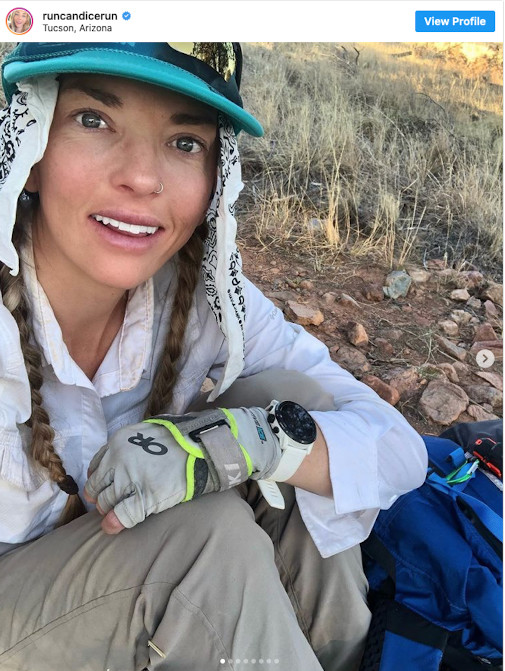
Had she carried on with her run, though, she would not have been driving through Washington on April 17, and the man in the car likely would have died, as Burt noted that there was no one else around to help or call 911. “He would’ve died this morning if we didn’t cross paths,” Burt wrote.
When she first saw the wreck, Burt said she “did a double take,” not sure what she was looking at. She assumed that someone must have already seen it and called for help, but it became clear that no one else was around. Fuelled by adrenaline, she ran to the car, only to find that the door was badly dented and wouldn’t open.
“I was kicking the windows, searching frantically for something to shatter them,” she wrote. After hammering the windows a few times, Burt said she thought she heard someone moving inside. She moved to the sunroof, thinking it could be a way in. She managed to slide her fingers under the sunroof, then yanked until it snapped off to reveal the driver of the car inside, his face covered in blood. Burt began to scream at the man, and he woke up just enough to unbuckle his seatbelt and crawl out of the car.
After she called 911, Burt says it only took four minutes for the emergency crew to get to the scene, but to her, it felt like much longer. “I don’t know how it was only four minutes,” she said. “It felt like 15.” In those four minutes, the blaze grew into “a scorching, putrid chemical bonfire” that certainly would have killed the unconscious man had he still been inside the car.
(05/02/2021) ⚡AMPby Running Magazine
New Balance Cancels Its 2021 Outdoor T&F Championship
New Balance announced on Friday the cancellation of its national high school outdoor track and field meet, New Balance Nationals Outdoor, following continued concern of COVID-19 and for the safety of those competing around the United States, the company confirmed.
This summer would have been New Balance's first venture with the new iteration of New Balance Nationals Outdoor since the company moved on from the National Scholastic Athletics Foundation in May of 2020.
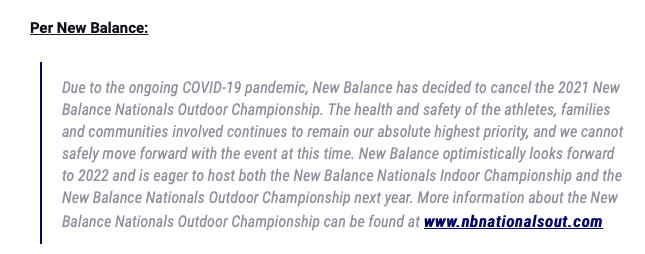
Previously, the organizations worked jointly together to hold NBNO, a national competition that featured some of the country's top athletes and saw some of the season's best performances.
After the restructuring, both organizations clarified that they would continue to hold a national meet -- New Balance would put on its new iteration with the same branding, while NSAF would continue to hold its national championships with a different title sponsor and name. NSAF has been holding national high school meets since 1991.
To be fair, it's been a confusing few months.
But all things aside, New Balance will not hold an outdoor meet in 2021.
(05/02/2021) ⚡AMPby Milesplit
Hosts Poland crowned first winners of World Athletics Relays Silesia 21
There was success for the host nation Poland on an action-packed first evening of competition at the World Athletics Relays Silesia 21, with Joanna Jozwik and Patryk Dobek teaming up to win the 2x2x400m.
It was the first of two finals at the Silesian Stadium in Chorzow on Saturday (1), with Germany winning the shuttle hurdles relay and a whole host of competitive 4x100m and 4x400m heats taking place.

Tactical victory on home soil
With two athletes taking it in turns to run their two 400m legs, the 2x2x400m is an event which favours the middle-distance athletes rather than sprinters but in Dobek the host nation had a bit of both. Previously better known as a 400m hurdler, the 27-year-old has stepped up to the 800m this year in superb style, winning the European indoor title in just his fourth competition at the distance.
In Silesia he was joined by his European Indoors teammate Jozwik, who claimed 800m silver in Torun, and together they powered to victory on home soil, clocking 3:40.92.
After a conservative start, Kenya were narrowly ahead after the first lap, with Naomi Korir handing the baton to Ferguson Cheruiyot Rotich and Jozwik passing on to Dobek, who had helped Poland to a fourth-place finish in this event at the last edition of the World Athletics Relays in Yokohama in 2019.
Slovenia is only fielding one team in Silesia and they made their presence felt in this event, with Anita Horvat and Zan Rudolf challenging Kenya on the third and final legs. Kenya had the stronger finish, however, and it saw them secure second place in 3:41.79 as Slovenia were third in 3:41.95.
Germany holds off strong Polish challenge in shuttle hurdles
All-round stronger starts and composure under pressure helped Germany to victory in the mixed shuttle hurdles relay, the final event of the night.
Monika Zapalska began well to give Germany a slight lead on the first leg. Poland’s Zuzanna Hulisz made up a bit of ground on Zapalska towards the end of her leg, but Germany’s Erik Balnuweit got off to a swift start on the second leg, opening up another metre on Poland.
Krzysztof Kiljan maintained Poland’s second-place position on the second leg as the top two teams continued to pull away from Kenya in third. The positions stayed the same on the third leg with Anne Weigold holding on to the lead for Germany as Poland’s Klaudia Wojtunik tried to give chase.
Poland saved their strongest runner, Damian Czykier, for the final leg. At first it seemed as though Gregor Traber’s lead was unassailable, but Czykier closed well in the final stages. He clattered the final barrier, though, and so was unable to catch the German before the finish.
Germany won in 56.53 with Poland taking second in 56.68. Kenya took third in 59.89.
All to race for in qualifying events
Competition was fierce in the heats for the championship events, with qualification for the Tokyo Olympic Games and World Athletics Championships Oregon22 up for grabs.
The women’s 4x400m heats were up first and hosts Poland secured a strong start as they won the event’s opening race, clocking 3:28.11.
Cuba’s quartet of Zurian Hechavarria, Rose Mary Almanza, Lisneidy Veitia and Roxana Gomez went quickest overall, leading from gun to tape to win the second heat in 3:27.90 ahead of the Netherlands with 3:28.40. It was a busy night for European indoor 400m champion Femke Bol as before lining up for the mixed 4x400m, she opened her campaign with a 49.81 anchor split for the Dutch women’s team – the fastest overall in the first round.
Like the Netherlands and Poland, who won this event in Yokohama in 2019, Belgium and Great Britain had already qualified for Tokyo as 2019 World Athletics Championships finalists. They all also made the final in Silesia where they will be joined by Germany, Italy and France on Sunday.
Belgium qualified third quickest for the final with 3:28.27, ahead of Great Britain’s 3:28.83.
There was joy for the Dutch men’s 4x400m team too as Jochem Dobber, Liemarvin Bonevacia, Ramsey Angela and Tony van Diepen combined to clock 3:03.03 and win the second heat, leading the list of qualifiers. But Poland didn’t share in the success of their female teammates as they missed out on the final by just one place. Their run did, however, gain them a spot at the World Athletics Championships in Oregon.
In that third heat, which was won by Botswana in 3:04.03, Italy’s Vladimir Aceti surged past Karol Zalewski – who was part of Poland's world indoor record-breaking team at the 2018 World Athletics Indoor Championships in Birmingham – with a split of 45.36 to finish second in 3:04.81 and pip the hosts for that place in the final.
The Japanese team ensured that they will also be heading for a home Olympics as Rikuya Ito, Kentaro Sato, Kazuma Higuchi and Kaito Kawabata clocked 3:03.31 to win the first heat.
Colombia’s Anthony Zambrano, the world 400m silver medallist, eased over the finish line in 3:04.64 to comfortably anchor his team to second place and a spot in the final along with South Africa, Belgium and France.
As expected, the mixed 4x400m heats provided some thrilling action, with Italy’s Edoardo Scotti, Giancarla Trevisan, Alice Mangione and Davide Re storming to a second heat win of 3:16.52 to lead the first round ahead of heat three winners Brazil with 3:16.53 and the Dominican Republic with 3:16.67.
Ireland, Belgium, Great Britain, Netherlands and Spain will be joining them in the final but Colombia and Poland will miss out after placing third and fourth in that high-quality second heat.
Colombia’s 3:17.61 was faster than the Netherlands’ winning time of 3:18.04 in the first heat, but they were run out of an all-important top two qualifying spot.
In that Netherlands team, Bol ran 50.72 after her earlier 49.81 in the women’s event.
Narrow margins in 4x100m
Things were tight at the top and bottom of the list of teams to qualify for the men’s 4x100m final, with just 0.001 separating Italy from Brazil to lead the first round and the exact same small margin between Denmark and Ukraine at the bottom, to see Ukraine just miss out.
European indoor 60m champion Marcell Jacobs and Italian record-holder Filippo Tortu both ran storming legs along with Eseosa Fostine Desalu and Davide Manenti to clock 38.45 in winning heat three ahead of South Africa, anchored by African champion Akani Simbine, while 2019 winners Brazil, anchored again by Paulo André Camilo de Oliveira, won heat two in a time just a thousandth slower.
Denmark ran a national record of 39.06 in that race to finish fourth behind Germany and Japan to secure their spot in the final, while the first heat was won by the Netherlands in 38.79 ahead of Ghana.
A strong team of Jamile Samuel, Dafne Schippers, Nadine Visser and Marije Van Hunenstijn led the qualifiers in the women's event to book their place in the final, as well as the major championships in Tokyo and Oregon. Together they clocked 43.28 to win the second heat ahead of Poland.
Just as the Danish team had the race of their lives in the men's event, so too did Ecuador in the women's and the quartet ran a national record of 43.86 in third to advance on time. Brazil was disqualified for a lane violation after originally winning the first heat ahead of Italy with 44.02, while heat three was won by France in 43.51.
They will be joined in the final by Switzerland and Japan.
Competition resumes on Sunday at 19:20 local time with the mixed 4x400m final.
(05/02/2021) ⚡AMPby World Athletics
Shura Kitata and Tigist Girma Win Ethiopian Olympic Marathon Trials
The much-discussed 35k Ethiopian Olympic marathon trial race was held today in Ethiopia without Kenenisa Bekele. Unless the Ethiopian Athletics Federation changes course, your Ethiopian Olympic marathon team will consist of the top three finishers from each race.
Here are the top five results from each race along with the credentials of the finishers. Race results and photos are courtesy of the Ethiopian Athletics Federation Facebook page with translation via Teferi Debebe.

The times of the men have been updated based on an update to the facebook page. The first results had Kitata winning by 20 seconds which made no sense given the photo of the finish shows it was close.
Shura Kitata 1:46:15 – 24-year-old was winner of 2020 London Marathon last October, runner-up in NYC and London in 2018, winner of Frankfurt and Rome in 2017. 2:04:49 pb (2018).2. Lelisa Desisa – 1:46:16 – 31-year-old is past winner of Dubai (2013), Boston (2013, 2015), NYC (2018), and Worlds (2019). Only 35th in Valencia last December. 2:04:45 pb (2013).3. Sisay Lemma – 1:46:19 – 30-year-old has never won a major. 3rd is his best major finish (Tokyo and London 2020, Berlin 2019, Dubai 2017). Past winner of Frankfurt, Vienna, Warsaw and Ljubljana. 2:03:36 pb (2019).4. Chalu Deso – 1:46:34 – Age not listed. 9th in Dubai (2:06:29) and 6th in Valencia (2:04:53). Past winner of Porto (2019 – 2:09:08).5. Kinde Atanaw – 1:47:03 – 28-year-old won Valencia in 2019 (2:03:51 pb), DNF Valencia in 2020. No other marathon results.
*The Ethiopian site now lists the times as 1:46:14.53, 1:46:15.10, 1:46:18.21, 1:46:33.67, 1:47:02.53 so we rounded them all up to the next second per rules protocol but we imagine most outlets will list the lower time.
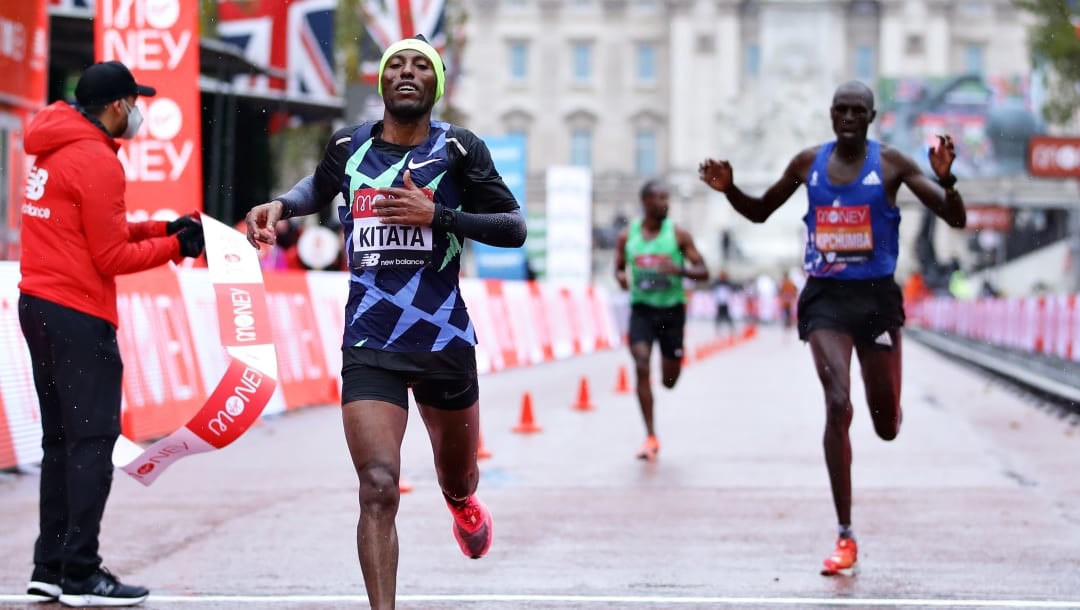
Women’s Results
1. Tigist Girma – 1:59:23 – 27-year-old has never won a major (best finish is 5th and that’s the only major she ever ran — Tokyo 2020) but has twice run 2:19. 2:19:52 pb from Amsterdam 2019. Has won 2 of her career 13 marathons.2. Birhane Dibaba – 1:59:45 – 27-year-old was runner-up in Tokyo last year (2:18:35 pb) and 9th in Valencia (2:23:07). Also ran 2:18:46 for 3rd in Valencia in 2019. 2015 and 2018 Tokyo champ.3. Roza Dereje Bekele 2:00:16 – 23-year-old won Valencia (2:18:30) and was 3rd in London in 2019. Won Dubai and was 2nd in Chicago in 2018. No results in 2020. 2:18:30 pb (2019 Valencia).4. Zeineba Yimer – 2:03:41 – 22-year-old has two carer marathon finishers, a 2:19:27 for 5th in Valencia in 2019 and a 2:19:54 that got her 4th in 2020.5. Ruti Aga – 2:04:28 – 27-year-old was 2019 Tokyo champ. Has finished in the top 3 five other times (runner-up in Berlin in 2017 and 2018 and Tokyo 2018 and 3rd in Berlin 2016 and New York 2019). 2:18:34 pb from 2018 Berlin.
(05/02/2021) ⚡AMPby Let’s Run
New Salazar documentary questions reasons for his 2019 suspension
Nike’s Big Bet, the new documentary about former Nike Oregon Project head coach Alberto Salazar by Canadian filmmaker Paul Kemp, seeks to shed light on the practices that resulted in Salazar’s shocking ban from coaching in the middle of the 2019 IAAF World Championships. Many athletes, scientists and journalists appear in the film, including Canadian Running columnist Alex Hutchinson and writer Malcolm Gladwell, distance running’s most famous superfan.
Most of them defend Salazar as someone who used extreme technology like underwater treadmills, altitude houses and cryotherapy to get the best possible results from his athletes, and who may inadvertently have crossed the line occasionally, but who should not be regarded as a cheater. (Neither Salazar nor any Nike spokesperson participated in the film. Salazar’s case is currently under appeal at the Court of Arbitration for Sport.)

Salazar became synonymous with Nike’s reputation for an uncompromising commitment to winning. He won three consecutive New York City Marathons in the early 1980s, as well as the 1982 Boston Marathon, and set several American records on the track during his running career.
He famously pushed his body to extremes, even avoiding drinking water during marathons to avoid gaining any extra weight, and was administered last rites after collapsing at the finish line of the 1987 Falmouth Road Race.
Salazar was hired to head the Nike Oregon Project in 2001, the goal of the NOP being to reinstate American athletes as the best in the world after the influx of Kenyans and Ethiopians who dominated international distance running in the 1990s. It took a few years, but eventually Salazar became the most powerful coach in running, with an athlete list that included some of the world’s most successful runners: Mo Farah, Galen Rupp, Matt Centrowitz, Dathan Ritzenhein, Kara Goucher, Jordan Hasay, Cam Levins, Shannon Rowbury, Mary Cain, Donovan Brazier, Sifan Hassan and Konstanze Klosterhalfen.
Goucher left the NOP in 2011, disillusioned by what she saw as unethical practices involving unnecessary prescriptions and experimentation on athletes, and went to USADA in 2012. An investigation by the U.S. Anti-Doping Agency followed on the heels of a damning BBC Panorama special in 2015, and picked up steam in 2017.
When Salazar’s suspension was announced during the World Championships in 2019, he had been found guilty of multiple illegal doping practices, including injecting athletes with more than the legal limit of L-carnitine (a naturally-occurring amino acid believed to enhance performance) and trafficking in testosterone – but none of his athletes were implicated. (Salazar admitted to experimenting with testosterone cream to find out how much would trigger a positive test, but claimed he was trying to avoid sabotage by competitors.)
That Salazar pushed his athletes as hard in training as he had once pushed himself is not disputed; neither is the fact that no Salazar athlete has ever failed a drug test. Gladwell, in particular, insists that Salazar’s methods are not those of someone who is trying to take shortcuts to victory – that people who use performance-enhancing drugs are looking for ways to avoid extremes in training.
That assertion doesn’t necessarily hold water when you consider that drugs like EPO (which, it should be noted, Salazar was never suspected of using with his athletes) allow for faster recovery, which lets athletes train harder – or that the most famous cheater of all, Lance Armstrong, trained as hard as anyone. (Armstrong, too, avoided testing positive for many years, and also continued to enjoy Nike’s support after his fall from grace.)
Goucher, Ritzenhein, Levins and original NOP member Ben Andrews are the only former Salazar athletes who appear on camera, and Goucher’s is the only female voice in the entire film. It was her testimony, along with that of former Nike athlete and NOP coach Steve Magness, that led to the lengthy USADA investigation and ban.
Among other things, she claims she was pressured to take a thyroid medication she didn’t need, to help her lose weight. (The film reports that these medications were prescribed by team doctor Jeffrey Brown, but barely mentions that Brown, too, was implicated in the investigation and received the same four-year suspension as Salazar.) Ritzenhein initially declines to comment on the L-carnitine infusions, considering Salazar’s appeal is ongoing, but then states he thinks the sanctions are appropriate. Farah, as we know, vehemently denied ever having used it, then reversed himself.
It’s unfortunate that neither Cain, who had once been the U.S.’s most promising young athlete, nor Magness appear on camera. A few weeks after the suspension, Cain, who had left the NOP under mysterious circumstances in 2015, opened up about her experience with Salazar, whom she said had publicly shamed her for being too heavy, and dismissed her concerns when she told him she was depressed and harming herself. Cain’s experience is acknowledged in the film, and there’s some criticism of Salazar’s approach, but Gladwell chalks it up to a poor fit, rather than holding him accountable.
Cain’s story was part of an ongoing reckoning with the kind of borderline-abusive practices that were once common in elite sport, but that are now recognized as harmful, and from which athletes should be protected.
Gladwell asserts that coaches like Salazar have always pushed the boundaries of what’s considered acceptable or legal in the quest to be the best, and that the alternative is, essentially, to abandon elite sport. It’s an unfortunate conclusion, and one that will no doubt be challenged by many advocates of clean sport.
(05/02/2021) ⚡AMPby Running Magazine
Here's What To Know About Recycling Your Running Shoes
It probably won't surprise you, a runner, a definite wearer of shoes, to learn that the shoe industry is massive (producing 24.2 billion pairs a year, massive). Also unsurprising is that with its size comes a monster amount of waste as consumers continue to buy and ditch pair after pair.
The life cycle (from material processing, manufacturing, logistics, and eventual waste) is estimated to create 30 pounds of carbon emissions for each pair of running shoes.
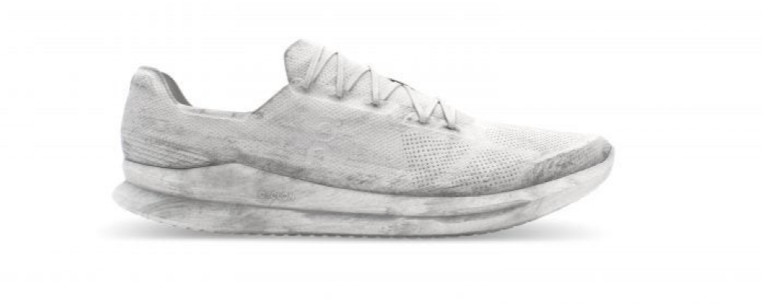
Running brands aren't oblivious to the problem and seem to grasp that runners are caring more and more about the environment, but aren't willing to compromise on the quality of their footwear. In fact, that's where a lot of the dissonance comes into play. To truly reduce the carbon footprint of the sneaker industry, runners need to one day rely on fewer, yet more durable shoes.
But no shoe brand wants us to buy fewer shoes. Which means, it's up to them to find another way. And this April, just in time for Earth Day, many brands are launching new (or beefing up old) footwear recycling.
Currently, 85 percent of textiles are not recycled, with the average person throwing away 70 pounds of clothing and other textiles annually.
In general, recycling shoes is a complex process and depending on the materials in the shoe it might not be possible. "Footwear is difficult to recycle because most shoes are made using multiple, mixed materials which are often stitched or glued together," says Shaye DiPasquale a publicist for the recycler TerraCycle.
"There is not a lot of physical recycling of footwear that goes on," says Eric Stubin, president of Trans-Americas Textile Recycling. The majority of 'recycled' shoes and clothes are shipped places to be reused. Stubin's company processes about 10 million pounds of post-consumer textile waste from clothing, shoes, and accessories every year.
Take polyurethane foam, a material researchers from Northwestern University only recently figured out how to upcycle. "Polyurethane foam waste has historically been landfilled and burned or down-cycled for use in carpeting," said William Dichtel, who co-led the research. "Our latest work effectively removes air from polyurethane foams and remolds them into any shape. This could pave the way for industry to begin recycling polyurethane foam waste for many relevant applications." Polyurethane, which is sometimes used in the midsole of shoes does not melt even in extreme heat. Previously, it could only be shredded or compressed in ways that make the material not durable enough for other uses.
In general, when clothing is recycled it tends to go to one of these four different end destinations:
Reused and repurposed as secondhand clothing (45%)
Recycled and converted into items like reclaimed wiping rags for industrial and residential use (30%)
Recycled into post-consumer fiber for home insulation, carpet padding, and raw material for the automotive industry (20%)
Landfills (5%)
Perhaps the most notable and lauded shoe recycling program is Nike's Reuse-A-Shoe, which is available at select Nike stores. Through the program any brand of athletic shoe is collected to be turned into a Nike Grind product-tracks, courts, walkways, and playground floors made from ground sneakers. Stubin considers the Nike Grind program to be the most "robust and viable program for footwear."
Earlier this month, the sandal company Teva announced its partnership with TerraCycle through a program it's calling TevaForever. For no additional cost, customers who sign up receive a pre-paid shipping label to send their worn sandals to TerraCycle. Their goal is to also turn the used sandals into running tracks, playgrounds, and more.
TerraCycle's footwear Zero Waste Box is an option that anyone can order and fill with shoes to be recycled. According to DiPasquale the shoes will either be manually or mechanically separated into fabrics, metals, fibers, organics, and plastics. The fabrics are reused, upcycled, or recycled. The metals are smelted for reuse elsewhere. Wood or paper fibers are recycled or composted. And the plastics are melted down and turned into pellets, flakes, or other usable formats to be molded into new products or packaging.
But what if you could buy a shoe with a promise that it will be recycled, rather than looking for a solution on the back end? On, the Swiss shoe company has recently launched its Cyclon shoe subscription which promises to be a closed-loop system. For a fee of $29.99 per month you are delivered the shoes, made of castor beans. When the shoes reach the end of their life, you let On know and they will send you a new pair along with everything you need to ship the old pair back to be recycled into new products.
Because of the concept, On was awarded the 2021 ISPO Product of the Year as well as a Sustainability Achievement award.
And on Earth Day, Salomon will begin selling its Index.01 shoe in the U.S., which is already available in Europe. Like On's concept, it promises to be a circular life-cycle shoe. As long as consumers send it back, partners of Salomon will recycle the TPU and polyester into raw materials for use in other products. In Europe specifically, the TPU will be recycled into Salomon ski boots.
What about socks? An oft-forgotten item that is more than likely to end up in the landfill. Smartwool has just announced its new partnership with Material Return starting April 21. Like Nike Grind, this program involves collecting old socks (can be any brand or material, but must be clean) to be ground up and used in other products. This is your chance to get rid of those lonely single socks that, let's be honest, won't ever find their match. Find a donation center here.
4 Other Ways to Donate or Recycle Your Shoes
Donating your shoes so someone else can get use out of them is probably the best thing you can do with that old pair.
Stubin's biggest piece of advice when donating your shoes: Don't judge your shoes too harshly. "A good pair of shoes, even if a runner deems them no longer useful, can likely find a second life," he says.
Even if the charity you donate to can't re-sell the shoes to a consumer, they can still sell it to a recycler. "So if a Goodwill sells clothing to Trans-Americas, we pay them for that material. There's a market price for that material," says Stubin.
Programs like One World Running and Soles4Souls (a popular choice among running stores) collect and distribute shoes and other clothing to people who need them. To date the Soles4Souls program has found second use for over 56 million pairs of shoes. Find a donation center near you here.
Soles4Souls partners with a lot of other high profile donation programs. The North Face's Clothes the Loop program, for example, will send your shoes to that recycling leader.
[Editor's Note: You can also join our Soles4Souls shoe drive! Get all the details here and help us put your old sneakers to good use.]
Also announced this month, Nike will soon start accepting lightly worn, good condition shoes into its refurbished program for resale in 15 authorized stores. You can also check with your local running store to see if they offer any sort of similar takeback program.
Extending the life of a garment by one year can reduce its carbon footprint by 25 percent, according to the Thredup fashion footprint calculator. "So footwear that lives on and finds a second life for two to three years, conceivably reduces the carbon," says Stubin.
Recycling vs. trashing shoes is only a small fraction of the problem. Most of the carbon emissions related to running shoes happens in the manufacturing process. At the end of the day, the best thing that can be done is to buy less and make the products we do own last longer. But, as with every environmentally charged movement, we have to start somewhere and demand forward progress and innovation, while doing our part as individuals.
(05/02/2021) ⚡AMPby Women’s Running Magazine
5 Steps to becoming a runner
Want to start running? You'll be in good company, considering almost 60 million Americans regularly hit the road, trail, or tread, according to Statista research.
Though running is one of the most accessible forms of exercise out there, becoming a runner can be a little more complicated than just lacing up and putting one foot in front of the other. (Unless you don't care about burning lungs, aching legs, and shin splints, that is.)
Whether you've never run a full mile, want to finish your first 5k, or are ready to train for a half-marathon, these training, fueling, and injury-prevention tips will make you a better runner than ever—and yes, even help you enjoy every step.
1. Don’t be afraid to start with walking.

If you’ve never laced up your sneaks for a run before, ease into a consistent cardio routine by walking for about 20 minutes, three times a week, says Colleen M. Brough, DPT, director of the Columbia University RunLab.
From there, progress your walks into run-walk interval workouts, Brough recommends. Start with 20 minutes four times a week, then bump the time up to 30 to 35 minutes.
“Run-walk intervals help minimize the risk of injury and can make the process of starting out more enjoyable and less daunting,” says Megan Roche, MD, running coach for Strava. “Increasing the number and duration of running intervals versus walking intervals is a great way to progress over time.”
As you get more comfortable, alternate between 60 seconds of running and walking—and eventually work your way up to a non-stop run.
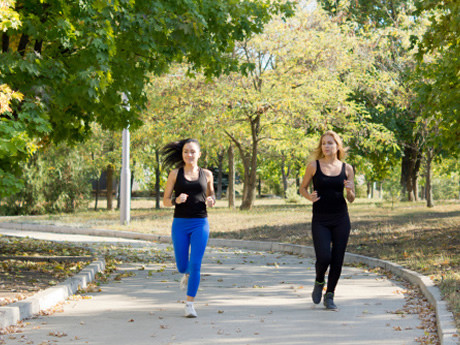
2. Use your breath to find your pace.
Sure, you might know how to run, but knowing what kind of pace you can hold is a whole other story.
New runners almost always start running too fast and then burn out, says Brandon T. Vallair, USA Track & Field Certified Level 1 Coach and owner of Run for Speed in Dallas.
Though you might associate the word "running" with speed, give yourself permission to slow it down.
To control your tempo, use the “talk test” and maintain a speed at which you can easily converse or sing, suggests Vallair. If you're gasping for breath, slow down. If you can belt out the chorus to a Bruno Mars song on your iPod, pick it up a bit.
"The idea is to finish each run wanting to do a little bit more or go a little bit faster," says Leivers. "It makes it easier to get out there the next time, because you feel like there's more to accomplish."
3.- Focus on minutes instead of miles.
How you measure your runs is totally up to you, but thinking in time instead of distance may be less daunting.
After all, setting out to run for 30 minutes gives you more wiggle room to have a bad day or take it slow than vowing to run three miles.
4.- Progress smartly and safely.
If you have your eyes set on a race (especially a half-marathon or longer), you'll (of course!) need to dial up your distance. However, it's key to do so slowly.
First, designate just one run each week as your long run, says Leivers. While you can add a mile or two to that run over time, keep the rest of your runs the same.
Leivers's number-one rule: Increase your total weekly mileage every other week by no more than the number of days per week you run. For instance, if you run three days a week, you can increase your mileage by three miles every other week.
And number two: Keep your long run to no more than half your weekly total mileage to prevent overdoing it during any single outing. So, if you run 10 miles a week, that long run should be five miles or less.
5.- Mix up your runs.
Once you can run for about 30 minutes straight, you can start adding intervals—which will help you improve your overall pace by switching up the stimulus on your body—to your routine, says Brough.
Plus, “switching up workouts is a great way to keep the fun rolling," says Roche.
Two ways to try intervals:
Hill strides: Run uphill for 20 to 30 seconds, then jog downhill or on flat road until recovered.
Speed intervals: Alternate between one minute at about 75-percent effort and one minute of easy jogging.
Sprint intervals: Alternate between one minute of all-out sprinting and five minutes of easy jogging.
(05/01/2021) ⚡AMPby Women´s Health
New CDC Guidelines Say You Don’t Have to Wear a Mask When Running Outdoors
Don’t leave your mask at home, though. Even outside, there are situations where you may still need it.
The Centers for Disease Control (CDC) announces new guidelines that state you don’t need to wear a mask outdoors if you’re running on your own or with members of your household, except in certain crowded settings and venues.
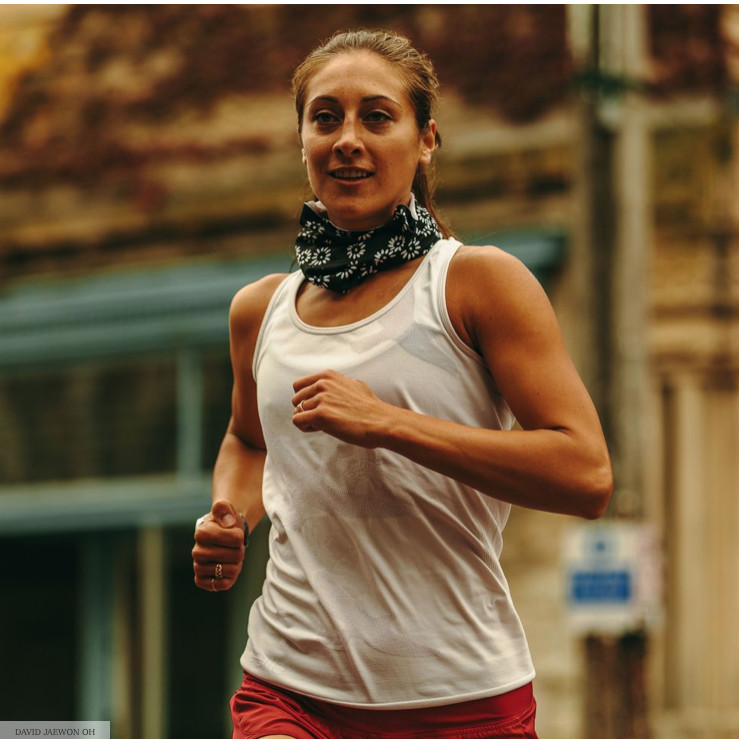
The guidelines also state that both vaccinated and unvaccinated people should continue wearing a mask during indoor activities including going to the gym or to a workout class.
While you don’t need to wear a mask or face covering when running outside, it’s best to still bring one with you in the case of an emergency or unplanned event.
Yearning for a run without worrying about a mask? The time has come.
According to new guidelines from the Centers for Disease Control (CDC), you don’t need to wear a mask outdoors if you’re walking, running, biking, or hiking on your own or with members of your household, whether you’re fully vaccinated or not, except in certain crowded settings and venues.
Additionally, those who are fully vaccinated can go mask-free when attending small, outdoor gatherings, even if there are unvaccinated people in attendance, and dine at outdoor restaurants with friends from multiple households.
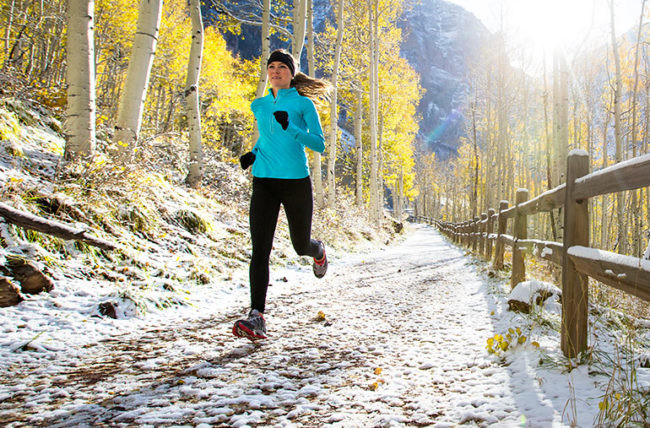
Previous guidance advised wearing a mask in any public setting, even outdoors, unless you were exercising solo in an area where you could maintain ample distance from others.
In a chart ranking the safety of numerous activities, the CDC now indicates that running or walking outside is among the safest activities you can do right now. Most other activities, particularly those held indoors (including going to the gym or to a workout class), should prompt mask-wearing—but that fully vaccinated people wearing masks have a much lower risk level of catching or transmitting COVID-19 than unvaccinated people.
Finally, there are other safety measures to keep in place when running, such as staying home when you feel sick and maintaining physical distancing when possible.
Can you head out for a run and leave your mask behind?
Not quite—it’s still worth carrying one with you on the run, even if you’re fully vaccinated, in the case of an emergency or unplanned event (like needing to stop in a store for food or drink), or in case you find yourself in a larger gathering than you’d anticipated, including in group runs and races. Consider tucking the mask into a pocket or your waistband to have it handy, or wear a buff that can easily be pulled up around your neck.
“While mask requirements have been updated, it is still prudent to keep your mask on hand at all times,” Vivek Cherian, M.D., internal medicine physician affiliated with the University of Maryland Medical System, told Runner’s World. “If you are running or biking, you can absolutely enjoy that mask-less, whether you’re vaccinated or not. However, it is always advisable to have it for a busy trail or having to go inside a store.”
If you’re on a group run or at a race, Cherian added that it’s important to be mindful of the vaccination status of others around you. If not everyone is vaccinated, or you are not sure, he advised that it’s best to wear a mask because it is still a possibility that you could be an asymptomatic carrier of COVID, despite having received the vaccine.
Are gyms safe for indoor training?
Participating in an indoor, high-intensity exercise class is listed as “least safe” on the CDC’s updated guidelines for those who are unvaccinated, but safe for the fully vaccinated. However, everyone in that class should still be wearing a mask, the CDC suggests.
At this time, home workouts are still your best bet for keeping up your fitness routine and helping to ensure your own health and the health of those around you. Gyms are open in most states—with caveats. Many require masks, distancing, smaller class sizes, reserved time slots, and even a switch to outdoor training. But, before you go, it’s important to weigh the risks and know how the virus is spreading in your community. (You can find a directory of state health departments here.)
“If you have to do an indoor workout with others in the gym, make sure you’re masked up with the best filtering, best fitting mask(s) you’ve got,” Matt Ferrari Ph.D., associate professor of biology in the Eberly College of Science, and a researcher with the Center for Infectious Disease Dynamics at Penn State, told Runner’s World previously.
And, no matter where you sweat, you should remember to wash your hands regularly, especially after your workout for an added layer of precaution.
When are you considered to be fully protected from COVID-19 after receiving a vaccine?
Two weeks after the second shot of the Pfizer or Moderna vaccines, or two weeks after the Johnson & Johnson vaccine.
This is a developing situation. For the most up-to-date information, check resources like the Centers for Disease Control and Prevention (CDC) regularly. This story will be updated as new information becomes available.
(05/01/2021) ⚡AMPby Runner’s World
Ultrarunner documents 100-mile Central Park FKT with short film
American ultrarunner Robbie Balenger set an FKT (fastest known time) in New York City’s Central Park on March 21, running nearly 100 miles in just over 18 hours. The Central Park Loop Challenge follows a roughly 10K route around the park, and it involves running as many laps as possible in one day. Balenger beat the previous record by five laps, and he documented his 98-mile run with a short film. The Central Park Loop Challenge marks Balenger’s first official FKT.
The record Balenger set out to beat in Central Park belonged to Aaron Zellhoefer, who ran 11 laps in just over 14 hours in June 2020. Balenger smashed that record, running five laps farther than Zellhoefer did and reaching the 100-mile mark. A big challenge with the Central Park Loop is the fact that the park is only open from 6 a.m. to 1 a.m. This means runners don’t have a full day to complete their FKT attempts, and the challenge officially begins at 6:05 a.m. and ends at 12:55 a.m. (although runners can start anytime between these hours).

That window works out to a little under 19 hours for runners attempting the Central Park Loop Challenge, and Balenger used almost all of the allotted time in his run. The rules of the challenge (which are listed on fastestknowntime.com) also state that only whole laps of the park count, and even if a runner covers 9K in their final lap, it won’t be included in their result. If two runners happen to run the same number of laps, the tie is decided by their times, and the faster result wins the FKT. In Balenger’s case, he ran much farther than anyone else before him, so no tie-breaker was needed.
Balenger notes that while he has run many ultra challenges before (in 2019, he ran 5,000 kilometres across the U.S.), he had never gone nearly as far in one shot as he did in his near-100-miler in Central Park. In his mini-documentary of the FKT attempt, Balenger also discusses his diet and how he completes all of his ultra-endurance adventures as a vegan. “It’s the best thing that I can do for my body to perform at my highest level,” he says.
Balenger’s diet and training clearly work very well for him, as he averaged 6:49 per kilometre over the 18-hour challenge. To learn more about his plant-based lifestyle and running career, click here, and to see his documentary, either watch the above video or head over to YouTube.
(05/01/2021) ⚡AMPby Running Magazine


